In pictures: 68 pro guitarists' pedalboards
Up close and personal with the pedalboards of the stars
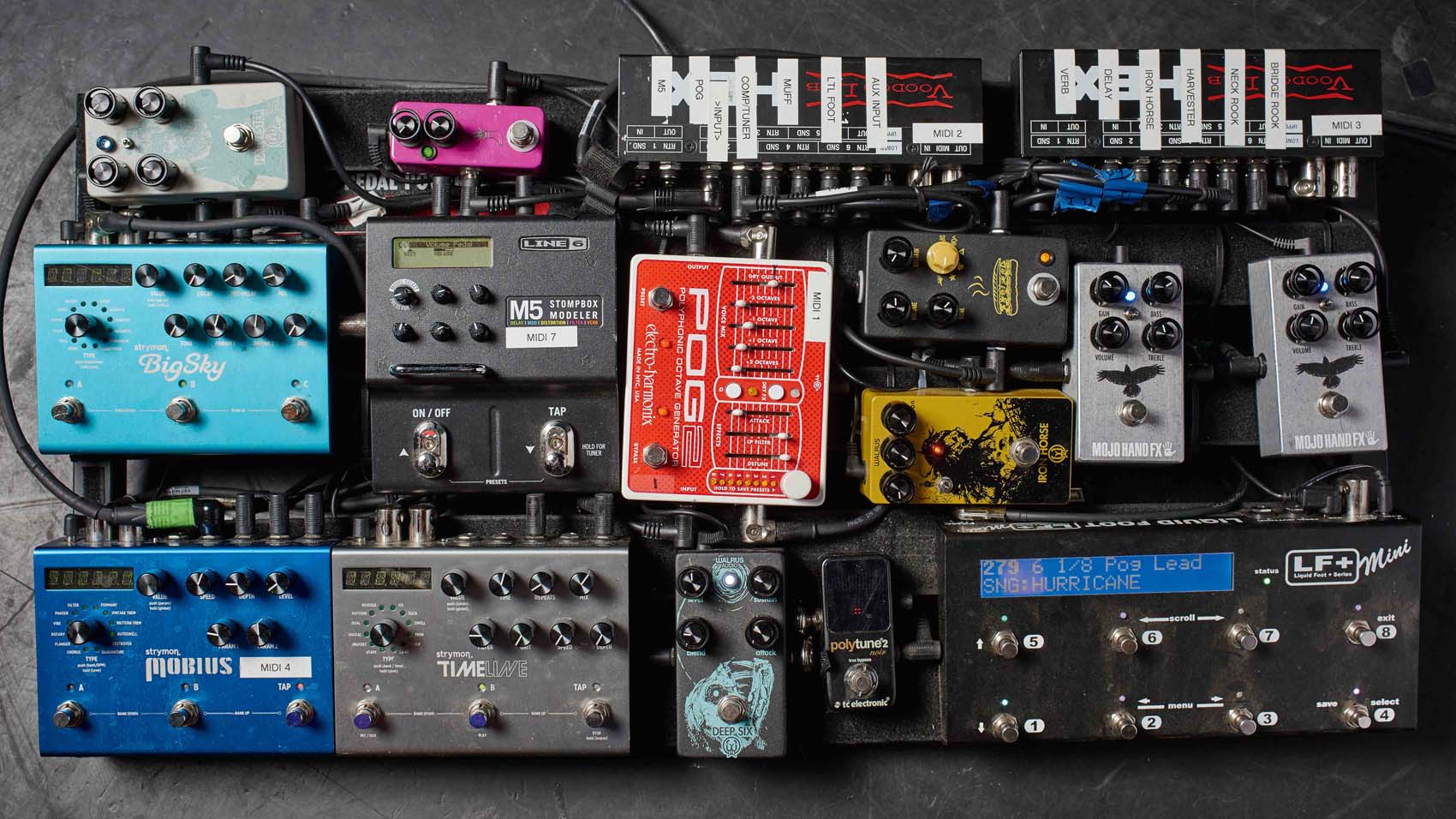
If you're anything like us, you've spent hours lusting over beautifully arranged, carefully considered pedalboards – after all, there's nothing more satisfying than getting that last stompbox stuck down and the last patch cable plugged in: it's perfection… at least until the next purchase.
Pro guitarists' pedalboards, on the other hand, are a whole other level of pedal-gazing. Filled with trendsetting boxes and old favourites, battered and bruised from months of touring, every player's 'board tells a story.
We've got rigs and setups from across the spectrum of players, too, from metal heavyweights Slipknot and Korn through bluesmen Kenny Wayne Shepherd and Gary Clark Jr, right on to insane pedalboards from the likes of Incubus, Minus The Bear and Thrice.
So, click - and, indeed, drool - through our gallery of the best pedalboards on the touring circuit to get the inside track on some of the guitar world's premier gear hounds, but be warned: we can't be held responsible for any post-gallery pedal spending sprees.
Don't Miss
Pro pedalboards recreated in miniature
How to build a guitar pedalboard
In pictures: the people's pedalboards: MusicRadar users share their guitar and bass pedal rigs
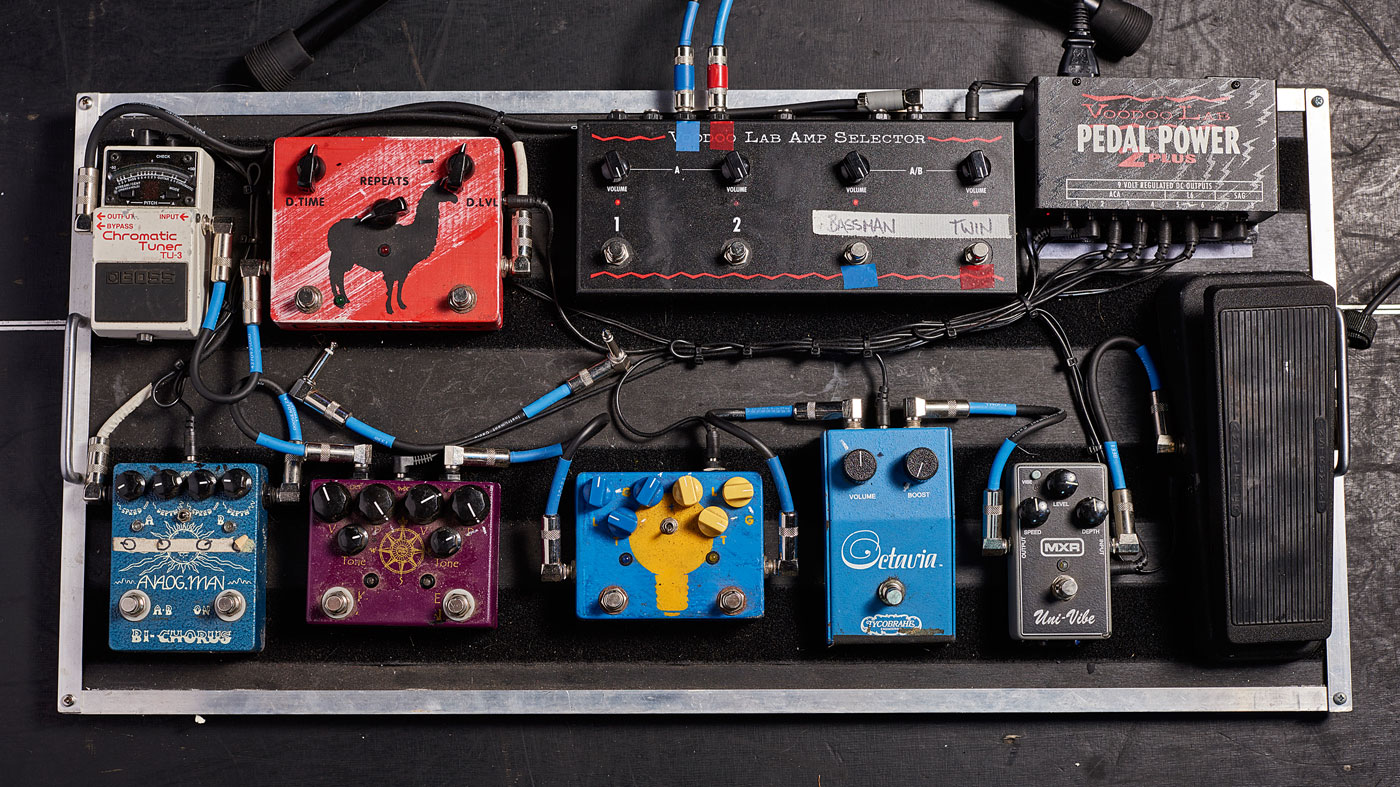
Kenny Wayne Shepherd
“Back home I have a switching system so I don’t have to do so much tap dancing. This is almost the same setup, without the switching system and a couple of small exceptions.
“I believe that this is one of the Clyde McCoy reissues that they make. Back in the States I use a Custom Audio Electronics wah that’s also made by Dunlop but under the Custom Audio Electronics name. So they sound slightly diff erent. Actually, I find the CAE to be a little more vocal, it has a little more broad range. But this one is good and it gets the job done.”
“A Univibe circuit is a pretty complex beast. The bulk of the sound on the original Univibes was dependent on this lightbulb flashing on and off inside. And when you’re trying to condense that into a very compact box like this one, you’re going to start sacrificing some of the sound. So this is, in my opinion, one of the best solutions for getting as close to the sound as you can in as smaller housing as possible. I only use it on one song, which is Blue On Black. We have a rhythm part that comes in right at the top of the second verse. I go from the acoustic sound to the Univibe for the rhythm.”
Chicago Iron Octavia SE
“This is a reissue from Chicago Iron. Again, I have the original and any of the reissue pedals you’ll see on my ‘boards, I always have an original as well. The reissues are pretty dependable and it’s a lot less stressful to take out on the road. This one is a pretty faithful reproduction.
“I kind of switch back and forth, right now on my other pedalboard I’m using a Roger Mayer octavia, which is the spaceship version. But this one sounds great. I use it on Blue On Black and in a very small section of Voodoo Child as well. I really use it for the octave effect, not so much the fuzz. So I have the boost turned all the way down.”
“I think it’s supposed to be a hot-rodded version of a Tube Screamer. It has a housing with two independent circuits. One has more drive and actually a little more treble to it, which I really have to dial back. On the left channel I have the tone knob turned way back, and on the right channel I have it turned way up.
“I haven’t opened this pedal up but sometimes these kind of pedals have chips in them that can go bad. And one of the things that starts to happen is they can get really bright, or their level will get drastically off . But right now this is working the way that it is.
“Primarily, I’m only using the right channel because it’s the lower gain side. The one thing about the Tube Screamer circuit compared to the King Of Tone is it has a little more midrange. The King Of Tone has a bit more clarity and depth. So if you want you can combine the two and get a really full spectrum sound.
“So it depends on the solo or the particular song with what I’m going for: whether I just use the King Of Tone, or whether I use a combination between the two to get a little more mid boost to get the solo a little further out there.”
Analogman King Of Tone
“Ever since this pedal came out, it’s been on every pedalboard I’ve had. It’s probably one of the most outstanding overdrive pedals ever, certainly in recent history. It’s got a really three-dimensional sound to it, and it’s got a lot of clarity so it doesn’t muddy your tone.
“A lot of guys throw around the term ‘transparent’ when they’re talking about overdrives, but I think this one really does have a lot of transparency. It doesn’t colour your tone too much; it allows it to go to that next level. It adds some overtones that you’d hope the amp can accomplish. Sometimes when the amp can’t do it the pedal can help you get there.
“The right side for me is the high gain channel, and the left side is the lower gain channel. A lot of times I’ll use the right side for fills and when I want to play a solo, I’ll kick the left side on top of the right side just to send it right over the edge. But that’s dependent on the amps I’m using.”
Analogman Bi-Chorus
“This is a chorus pedal with two different independent settings. I kind of use it like a Leslie in a box. So there’s a slow setting and then you switch it over and it’s a fast setting. It’s a pretty great pedal if you like a chorus and don’t necessarily have enough room for a Rotovibe. I use it on Down For Love; it’s an old fashioned Texas shuffle. It really gets that sound, in my opinion, in a little bitty box.”
Jam Pedals Delay Llama
“They sent me one of the very first ones. It’s an analogue delay pedal and I prefer analogue where possible. It was a pretty good-sounding pedal from the get-go, but I actually developed a version of this pedal with them that has tap tempo, which I believe was the very first analogue delay with tap tempo. That’s on my other pedalboard, this is one of my earlier versions. It has a button that’s a hold switch, if you want to stack the delay indefinitely until you turn it back off .
“Some guys leave delay on all the time, but none of my heroes ever did that. I don’t come from that school personally. And it’s easy to do as it can help cover up your mistakes. So it can make playing a guitar a lot easier because you don’t have to be as accurate. But I don’t do that, I use it purely as an effect. It probably gets turned on maybe four times in a two-hour long show.
“In the States I’ve got four to five amps onstage. And in that setup we have the ability to switch amplifiers, but over here I’m just running two amps and the third one is a backup in case something blows up. I’m running both of these at the same time, they’re set up to pretty much run in stereo. For the longest time I would run three Twins and crank them up but it’s really not good for the ears!”
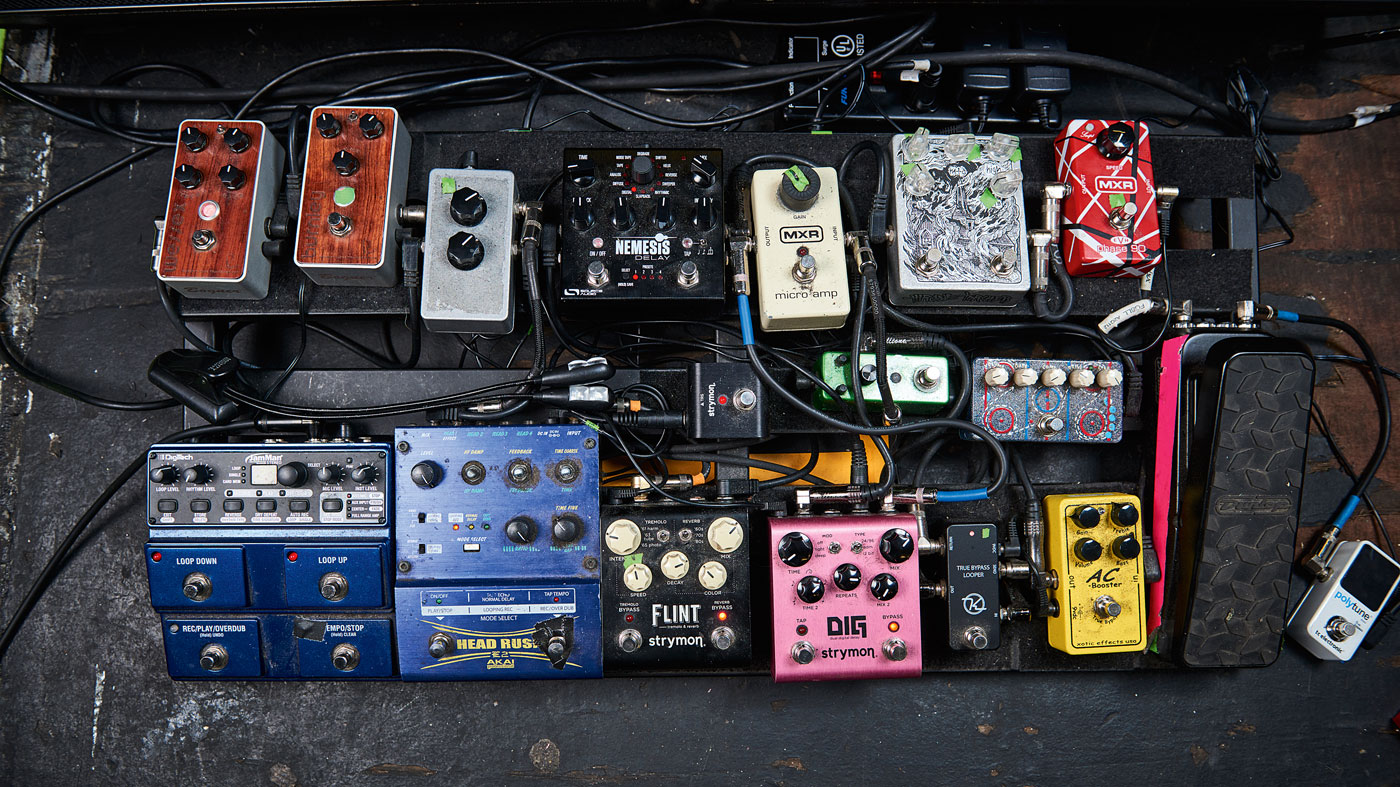
Mike Sullivan, Russian Circles
MXR EVH Phase 90
“It might be a weird spot to have it in the chain but I’m really happy with it. With the Phase 90 there’s not a lot of room for adjustment, well, other than speed, so I usually have a fair amount of delay and reverb with it to give it a sweeping texture. It works well on big chord parts to thicken them up. And I’m a big Van Halen fan!”
Abominable Effects Throne Torcher
“Right there we have a burning church [design]. It’s like a [Boss] HM-2 clone. So it’s got that gnarly midrange Swedish death metal sound. It does that exceptionally well. I used it so much on the last record it found its way onto the board.”
MXR Micro Amp
“I’ve had that since day one. Simple and easy to use live. Less is more with this and I use it for certain parts as a boost. I use the control with my foot quite often - this whole board becomes a different beast when it’s dark!”
Source Audio Nemesis
“That’s a really cool delay. You can save eight presets and for some of the songs the delay patterns need to be on exactly the right BPM. It’s very versatile.”
Bogner Wessex Overdrive and Burnley Distortion Pedals
“The main distortion comes from these. I usually have them going simultaneously and I use a little Keeley looper to turn those on and off . Occasionally, I’ll turn off the Wessex and just have the Burnley distortion. Usually in the studio you ditch your conventional [live] setup but I found those very useful. There’s a warmth with them that I haven’t found with other pedals.”
DigiTech JamMan Looper
“It can call up the between-song loops and there are drones in songs that help fill out the sound. I have a mixture of a pre-recorded loop and then throw another live loop on top of it.”
Akai E2 Headrush Looper and Saturnworks Mixer
“This has got be my most essential pedal. It just works for me live, with all the looping that I do. The only thing is the loop volume drops maybe five or 10 percent compared to the live signal, so I throw that into a mixer [silver pedal above] and it’s a wet and a dry to bump up the volume of the looped signal, so it sounds the same.”
Outlaw Effects Vigilante Chorus
“It’s a cheap little pedal and I don’t use chorus that often but I picked it up for next to nothing and it sounds alright.”
Z.Vex Fuzz Factory
“That’s cool, but I don’t use fuzz that much; usually when I want to cut through the mix in a noisy chaotic part. I don’t really find it useful for standard riffing, more letting the notes sustain through delays. I’m using it for 1/20th of the potential it could be used for!”
Strymon Flint Reverb and Tremolo
“The reverbs are very useful and the two in one combo is nice with the tremolo. I use the 60s reverb mode but the 80s is also cool for long, drawn-out delays with ethereal drones.”
Strymon Dig Delay and Favourite Switch
“I’ve found Strymon pedals to be well made and versatile. I like digital delay and you can change the dotted eighth notes and diff erent subdivisions that are really useful live. There’s a lot of reverb through the twins and here so I like to have a really clean delay onstage. You can use a little Strymon auxiliary switch [above left] with it - a favourite switch.”
Xotic Effects AC Booster
“That’s close to the start of the chain. It’s more of a dynamic boost and I can get a little more grit than with the Micro Amp. This one I use a little more as an overdrive or preamp per se.”
Jim Dunlop Volume Pedal
“I used to use the Ernie Ball Volume Jnr but everyone goes through them right and left. On tour you definitely need something reliable.”
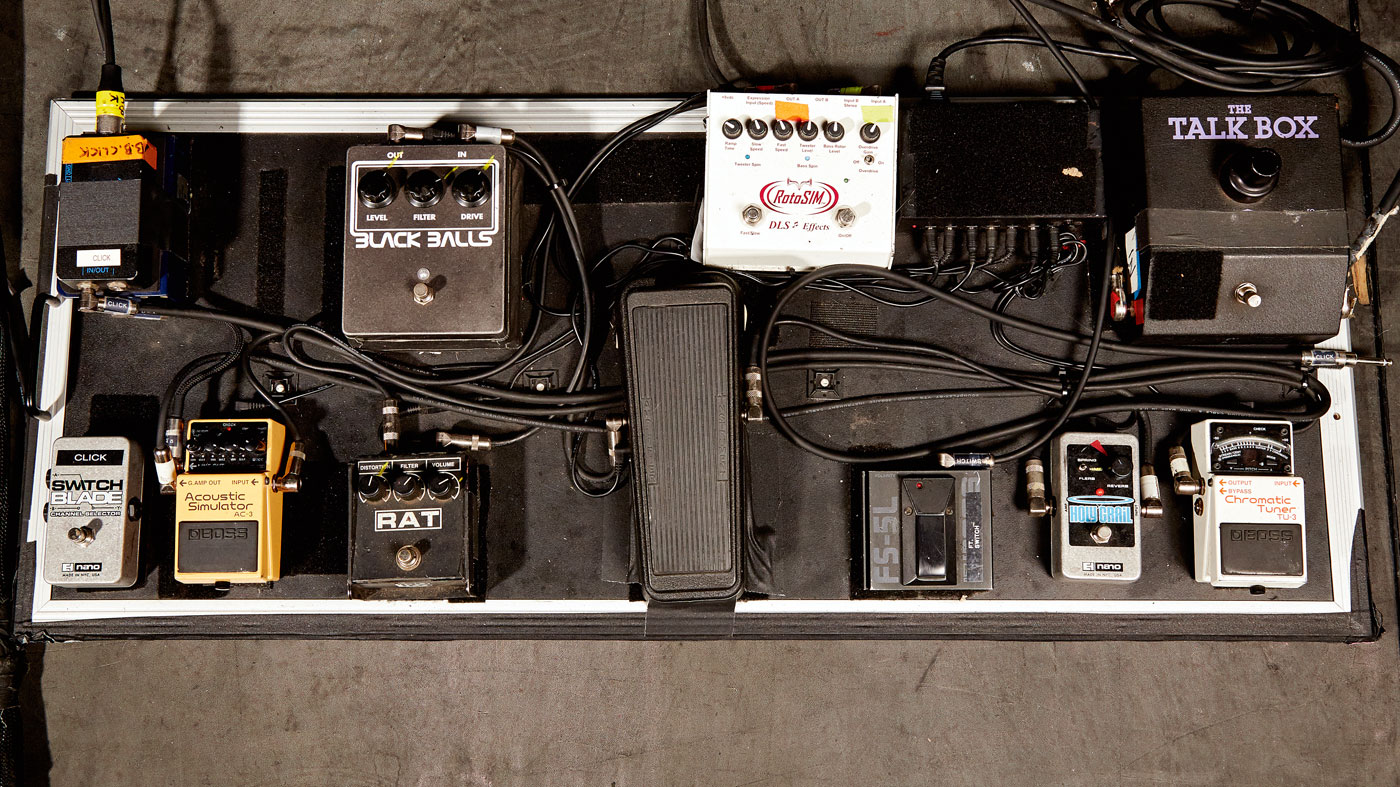
Rivers Cuomo, Weezer
Pro Co RAT
Brian: “I’ve got an original one. They’ve made a reissue that sounds really close, almost identical to that distortion sound. It just bites and pops more than any other pedal.
“Sometimes you put on distortion on top of something already distorted and it’s like a math problem, everything cancels each other out, you know? This gives a big boost and I can always hear the notes really well. I’ll kick it in for any lead sounds.”
DLS Effects Rotosim
“The last pedal I incorporated, because I try to keep all of this real simple, is the RotoSIM for a Leslie effect, a bit like a Rotovibe.
“A friend of mine got some deal with this pedal company and they gave me this big box of pedals. I didn’t really need delay or anything like that in this band, I just wanted another colour. I didn’t even know what a Rotovibe was… but this was perfect and exactly what I was looking for. If I’m not kicking in distortion or reverb, this is what it’ll be!”
Boss AC-3 Acoustic Simulator
“This is the best pedal there is! I cannot believe it’s taken this long to figure out this box is all you need to make electric guitars sound like acoustics, which usually sound like garbage on stage.
“This box nails the idea of an acoustic - it has that timbre, that percussive sound. In other situations, you’d want the real deal. If you ever went to see Tom Petty or Neil Young, you’d want the big jumbo and everything all mic’d up. It’s kinda funny because I’m up there playing this mirrored Explorer on My Name Is Jonas and it comes out sounding like the most beautiful acoustic.”
Balls Effects Black Balls
“This is a little fuzzier than my other pedals, I use it primarily for Back To The Shack, which I felt needed a bit of a creamier sound.”
Jim Dunlop Heil Talk Box
“This thing sounds great for the solo I do in Beverly Hills. Whenever you need a special sound that’s unlike anything else, a Talk Box will defi nitely do the trick. I also use the Jim Dunlop wah.”
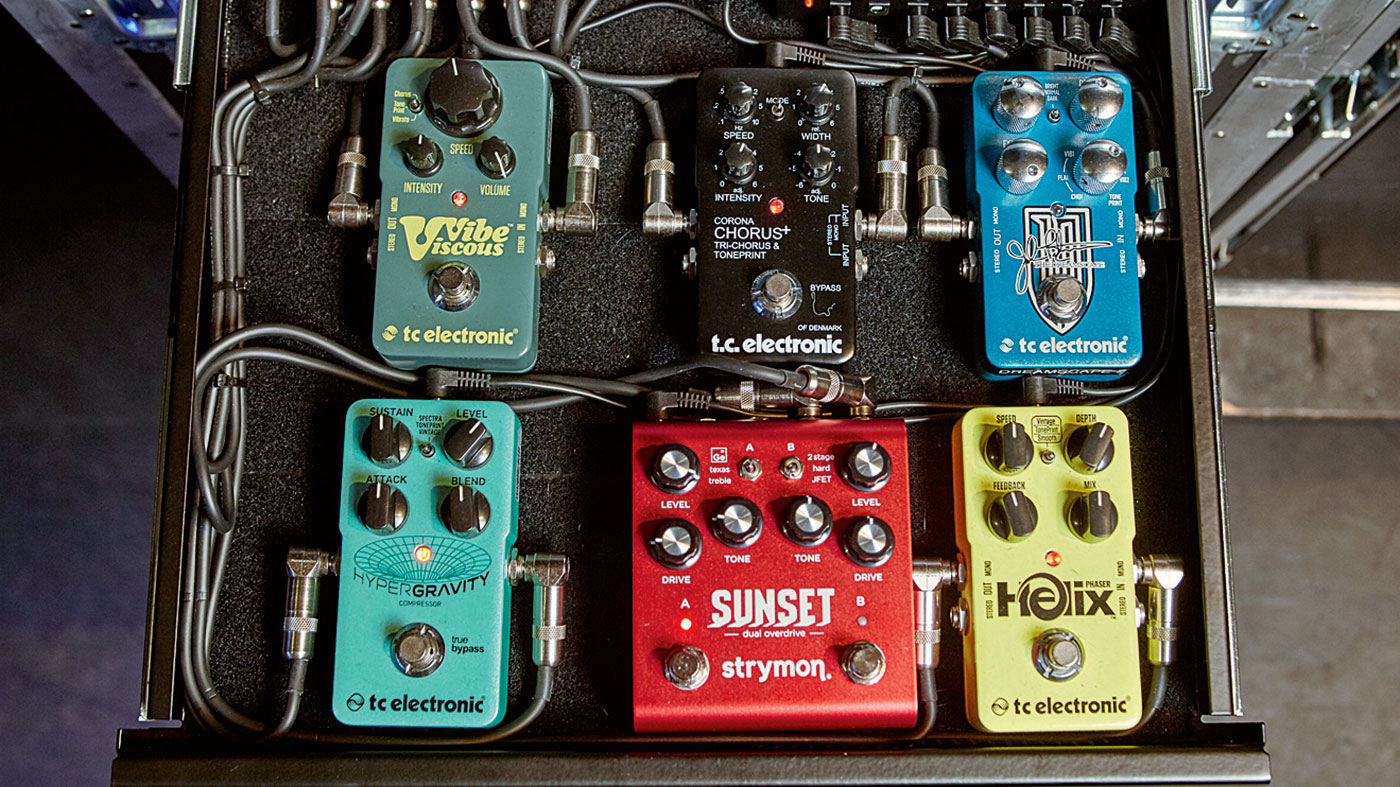
John Petrucci, Dream Theater
Jim Dunlop JP95 Cry Baby Wah
“I’m not being a salesman… my wah is fuckin’ badass! The sound comes from the rack wah, which we had made into a pedal.
“When I went to develop it, they had sent me all the other signature ones… I tried them all and took notes about the things I’d liked about each one. In the end, I realised the rack wah sound was my favourite. It’s a throaty, aggressive wah that sounds like a monster!”
TC Electronic Dreamscape
“My pedals tend to change a bit over the years. Right now, it’s primarily TC stuff - and this is signature Dreamscape modulation pedal, which does chorus, flanger and vibrato… If I ever need to switch, we go old school and do it all by hand on the fly.”
TC Electronic Helix Phaser
“I love the Phase 90 too, I like the Boss phaser and the MXR one… but I’m a big fan of TC Electronic stuff. They’re really consistent, true bypass. The Helix phaser will come on for a short lead in The Bigger Picture and I might use it a little on Take The Time. There are little clean guitar breaks here and there, rather than the long, arpeggiated song intros, which have a more of a chorus thing going on.”
Strymon Sunset
“This is my newest pedal, I got it pretty recently. It has six different modes for all these different overdrives, which you can mix together at the same time. The overdrives probably change the most in my rig.
“Sometimes there’ll be a Keeley Red Dirt here or a modded Tubescreamer or a Boogie model. With all the features of my Boogie, I don’t really need an overdrive pedal. The Majesties also have a 20dB boost on the volume control! So we really don’t need these, but in the spirit of fun, we thought we’d include a little something extra.”
TC Electronic Hyper Gravity
“This is a compressor used for just my clean sounds, like on Take The Time. I’m a big fan of that big compressed sound, where you can hear the strings ringing out with a bell-like quality and with sustain. It helps tame those peaks, but you can do without it - the clean sound of the Boogie is so beautiful, you don’t need much compression.”
TC Electronic Corona Chorus+
“Here’s a limited edition version of a similar pedal called the Corona Chorus+, it’s just like the original TC SCF pedal. I can have this covering most chorus modulation if I want and use the Dreamscape as a flanger.”
TC Electronic Vicious Vibe
“This is TC’s answer to a ‘Uni-Vibe’ kind of sound. The TonePrint ability is awesome, you can just beam things off your phone. Usually, I’ll be in the mood to get a David Gilmour or trippy Robin Trower vibe, or old school Rush. It’s mainly used for clean parts - it will get used on Hell’s Kitchen. It almost sounds like a phaser but more distinct.”
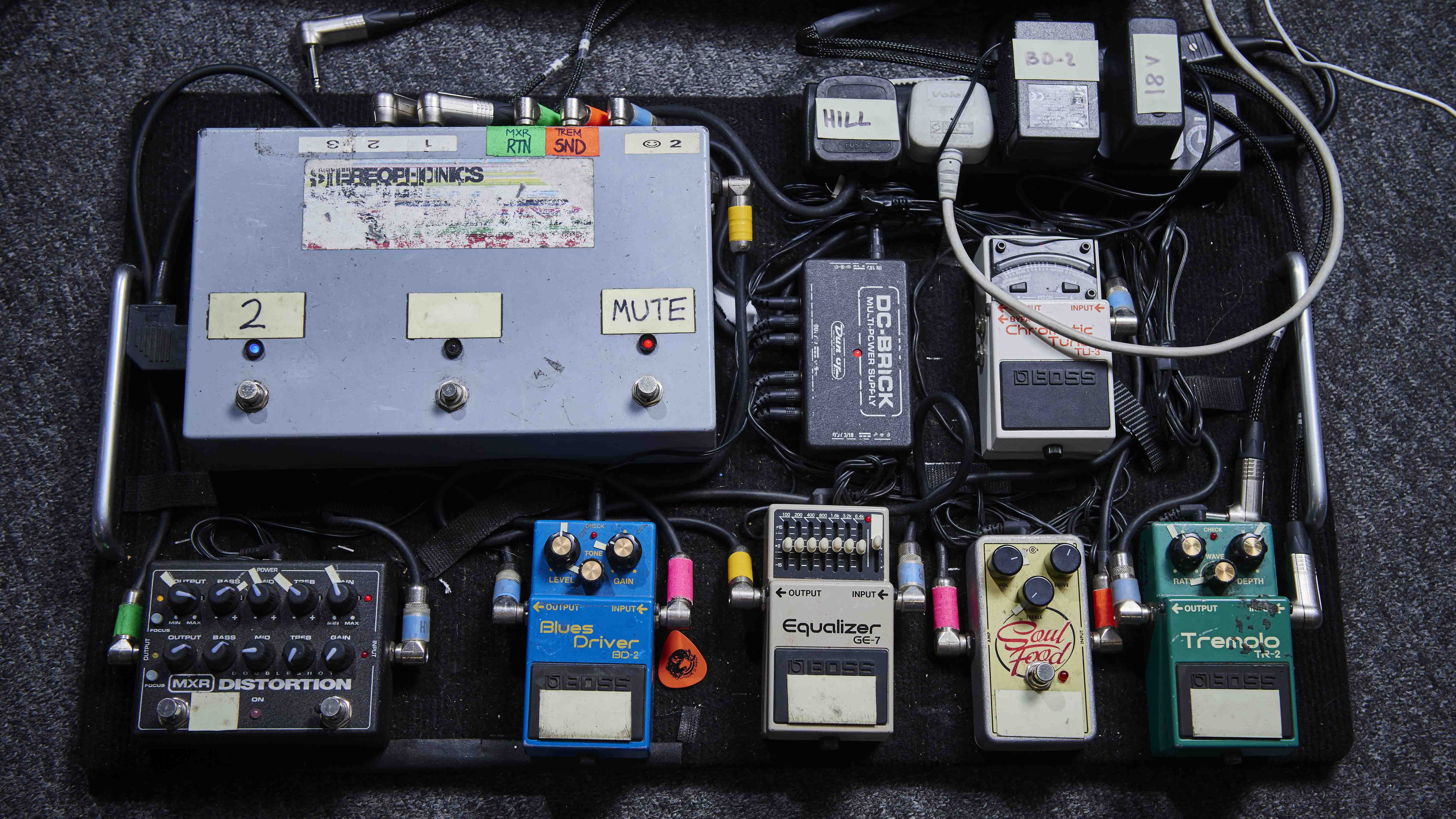
Kelly Jones, Stereophonics
“If I want a little more [gain] I whack on a [Boss] Blues Driver or a [Electro-Harmonix] Soul Food. So if I do solos I’ll whack that on. It’s kind of a three-stage thing for me [with the amps].”
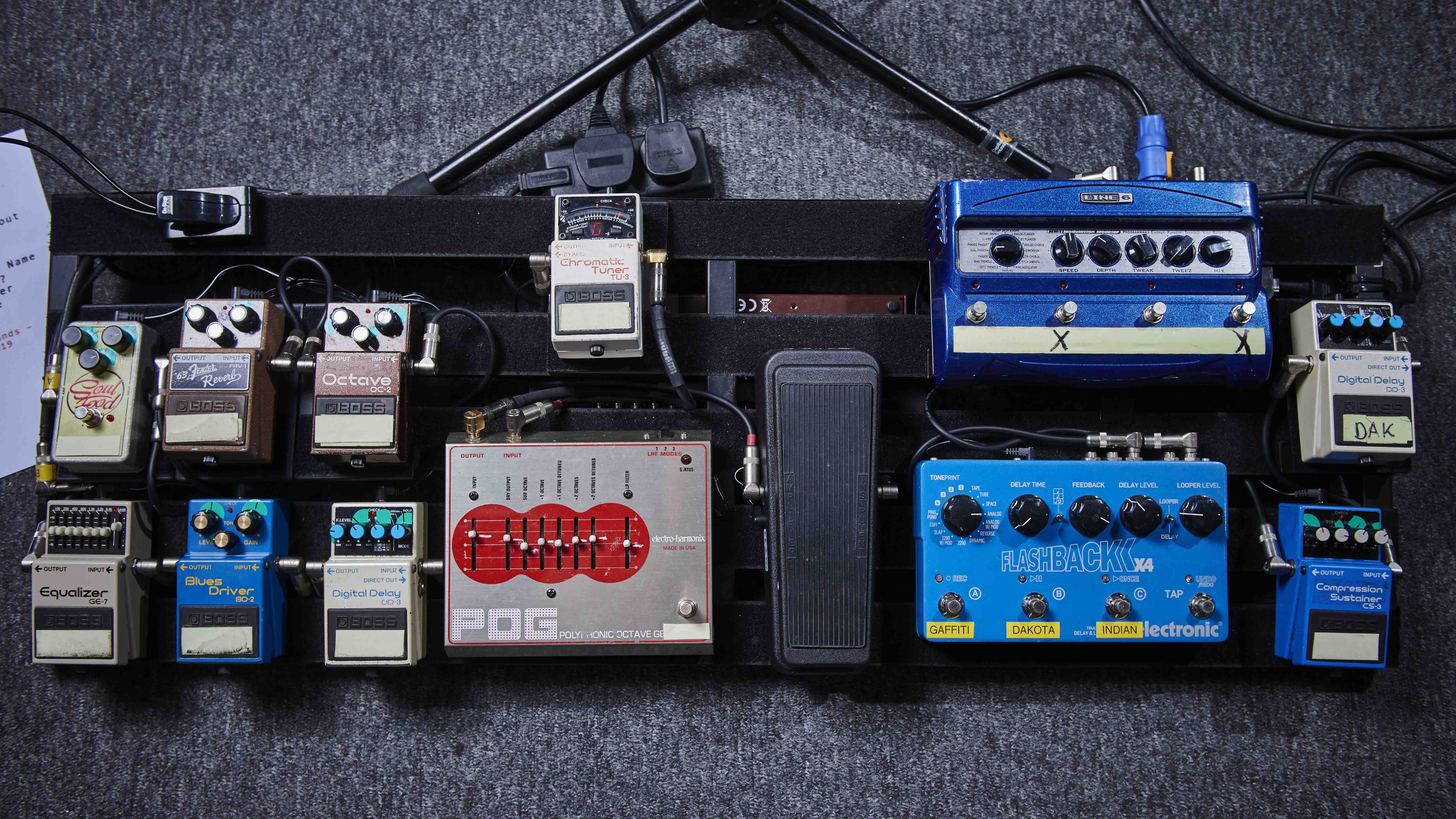
Adam Zindani, Stereophonics
“For my Orange, I use the [Boss] EQ a lot because it just lifts the volume. What you find with overdrives, or what I’ve found, is until you get things like the Klon, they take away from the actual sound and you lose the bottom-end. An EQ pedal for lifts the whole sound.”
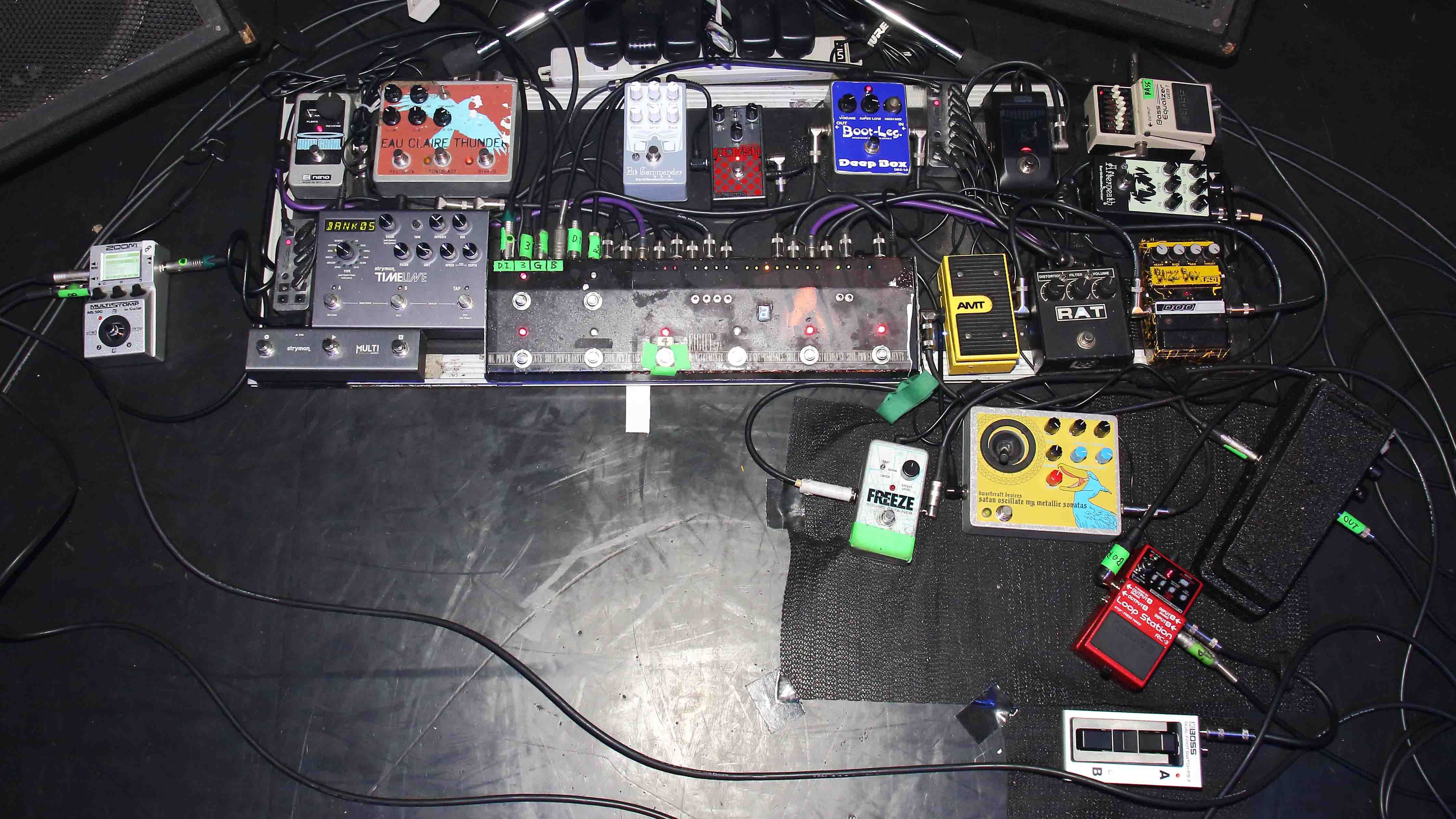
Takeshi, Boris
- Boss FS-7
- Boss RC-3 Loop Station
- Custom wah
- Dwarfcraft Devices SOMMS
- Electro-Harmonix Freeze
- DOD Buzz Box
- Pro Co RAT
- AMT LLM-2 Zero volume pedal
- EarthQuaker Devices Afterneath
- Boss GEB-7
- Korg Pitchblack
- Deep Box Boot-Leg
- Malekko Fetish
- EarthQuaker Devices Bit Commander
- Dwarfcraft Eau Claire Thunder
- Electro-Harmonix Holy Grail
- Strymon TimeLine (plus Multi switch)
- Zoom MS-50G
- Soul Power Instruments custom loop-switcher
“The system is put together centring on a loop-switcher pedal we custom-ordered from a small effects pedal company called Soul Power Instruments (S.P.I.). With two inputs, four outputs, and eight loops, by programming this beforehand, it allows me to switch between different combinations across the double-neck/pedals/amps in an instant.
“Wata is also using basically the same thing, so to say this loop-switcher is the central part of Boris’s sound wouldn’t be an exaggeration.
“For the bass side, my main pedal is a Pro Co Rat I also had modified by the same company, S.P.I. On the bass, I don’t really use many effects besides this distortion pedal.
“For my guitar sound, my main pedal is a Dwarfcraft Devices Eau Claire Thunder. I really can’t imagine using anything else; it’s my ideal sound.
“My DOD Buzz Box and Dwarfcraft Devices SOMMS pedals are also crucial to create an atmosphere of noisy outbursts.
“The EarthQuaker Devices delay/reverb pedal, Afterneath, creates mysterious echoes that sound like you’re inside a cave, and this paired with the Strymon Timeline creates a very deep delay that I’ve been really into recently.”
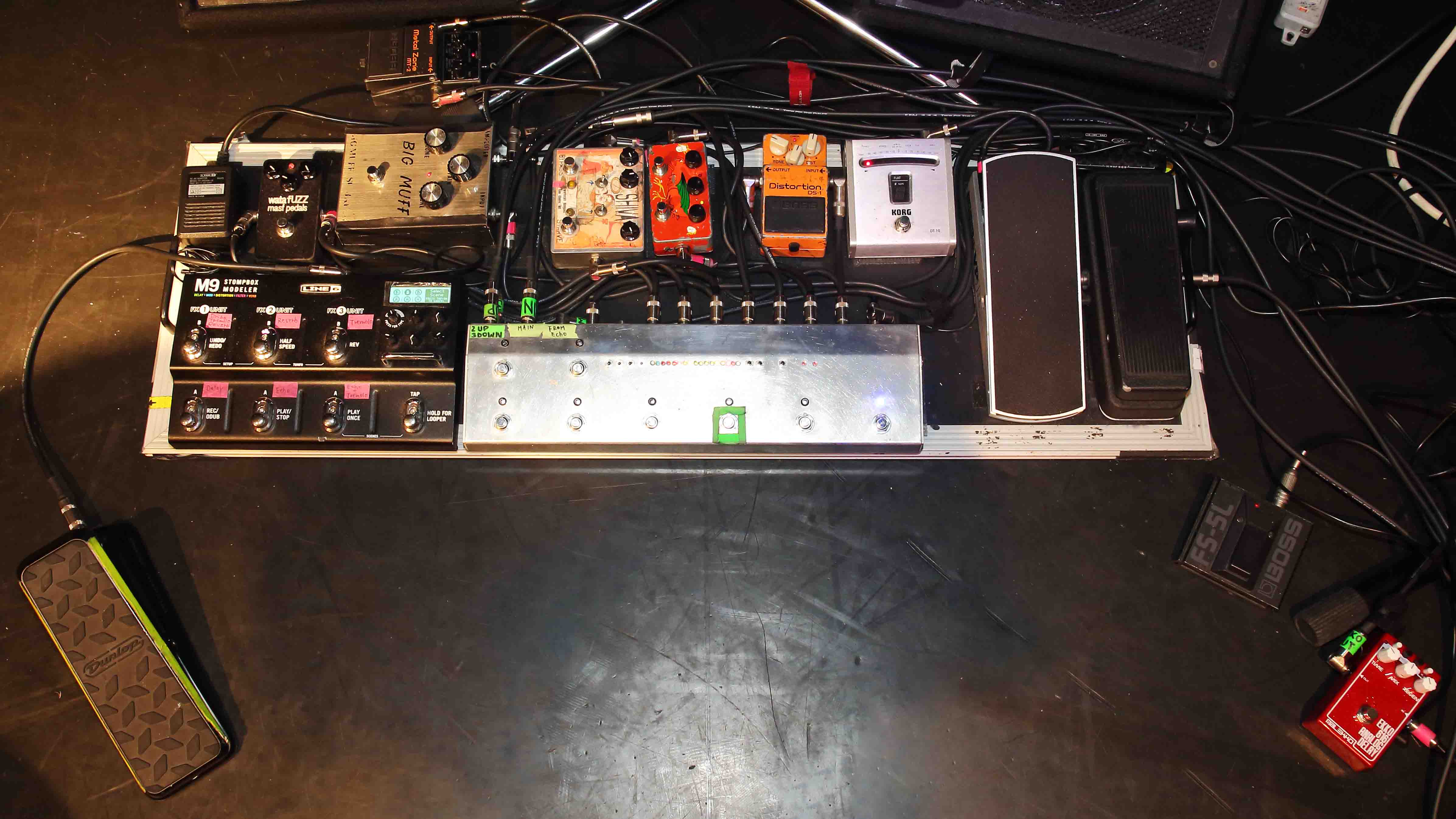
Wata, Boris
- EBow
- Roland Space Echo RE-150
- Dunlop Cry Baby Wah
- Ernie Ball VP JR
- Soul Power Instruments custom loop-switcher
- Boss DS-1
- Boss RV-2
- Z.Vex Super Duper
- Dwarfcraft Devices Shiva
- Elk Big Muff
- MASF Pedals Wata Fuzz
- Line 6 M9
- One Control Distro (power supply)
- 4ms Pedals CV Max Tweaker Swash
“For distortion, my Elk Big Muff is my main pedal. It’s a Big Muff clone, made by the Japanese company Elk Gakki, but it’s thick and heavy, and I really like the way the chunky sound comes through with a bang. It’s especially good when paired with the tape echo.
“Along with the Elk Big Muff, the Roland Space Echo RE-150 is of dire importance to my playing. Its unique atmosphere, roughness, and unpredictability are wonderful. It creates sounds that could not be made digitally.”
“The Wata Fuzz by MASF Pedals is one I had made for me, based on a Foxx Fuzz Wah. It emits a unique, gravely low-end sound.”
“The Soul Power Instruments loop-switcher is a pedal that was customized for me with two inputs, four outputs, eight loops and send-return. If programmed in advance, with one switch I can switch between everything - not only pedals but also inputs and amps. This pedal plays an extremely important role when performing Boris songs.
“With the EBow, using slides or bends or the manner of approaching the strings, it can create various expressions of sustain. The best.”
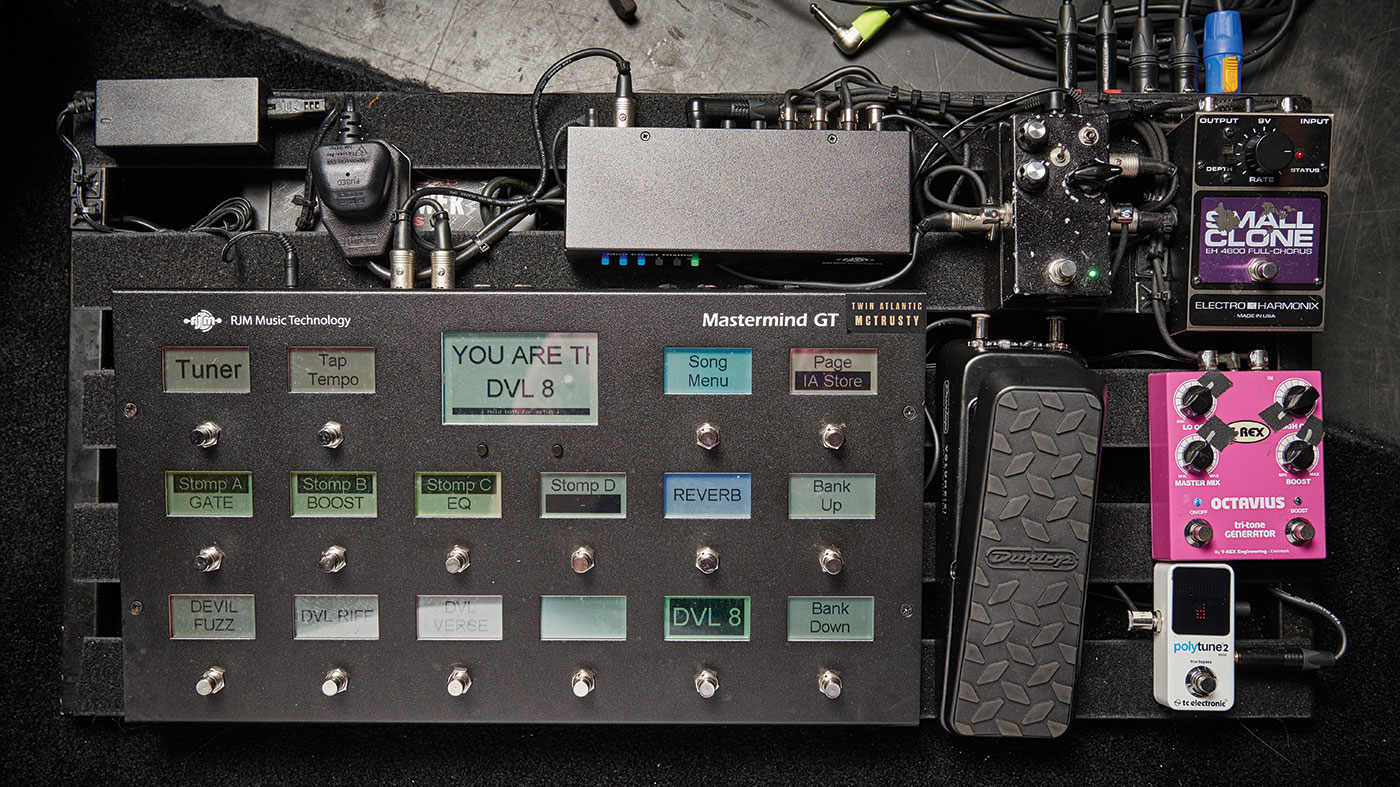
Sam McTrusty, Twin Atlantic
Electro-Harmonix Small Clone
“I’ve known about these for years, but I was never indulgent enough to fit one on my board until now! Because I’m singing as well as thinking about crowd control, pedals are a bit of an afterthought.
“I was listening to a lot of In Utero while we were making our new album and I wanted to recreate that swirling, sickly feedback. Whenever that comes on, it’s to add swampiness - on tracks like You Are The Devil, Overthinking and Valhalla. It’s one of the pedals that can’t be replicated, and when you mix it with fuzz you get instant Nirvana.”
Scotch Bonnet Fuzz
“I am the only owner of this fuzz pedal, as it was made by one of my guitar techs called Phil Wilson on the fly - you can’t buy it.
“It’s basically a Big Muff , but you can really mess around more with the high mids. We’ve used it so much for recording, I’m almost scared to touch the switches because it’s quite temperamental. It just goes on and off, that’s it!”
T-Rex Octavius
“Like the Small Clone, I used this on nearly every rhythm guitar track on the new album. It was my way of dropping it down to single notes instead of chords, so I can fatten things out more with the same weight and presence.
“There’s a lot of that style on there, while before it was all about power chords! I used the high octave on the chorus of Heart And Soul, with long reverbs coming from the Kemper. The tracking is so good it literally sounds like someone else is there playing a baritone, rather than being too digital.”
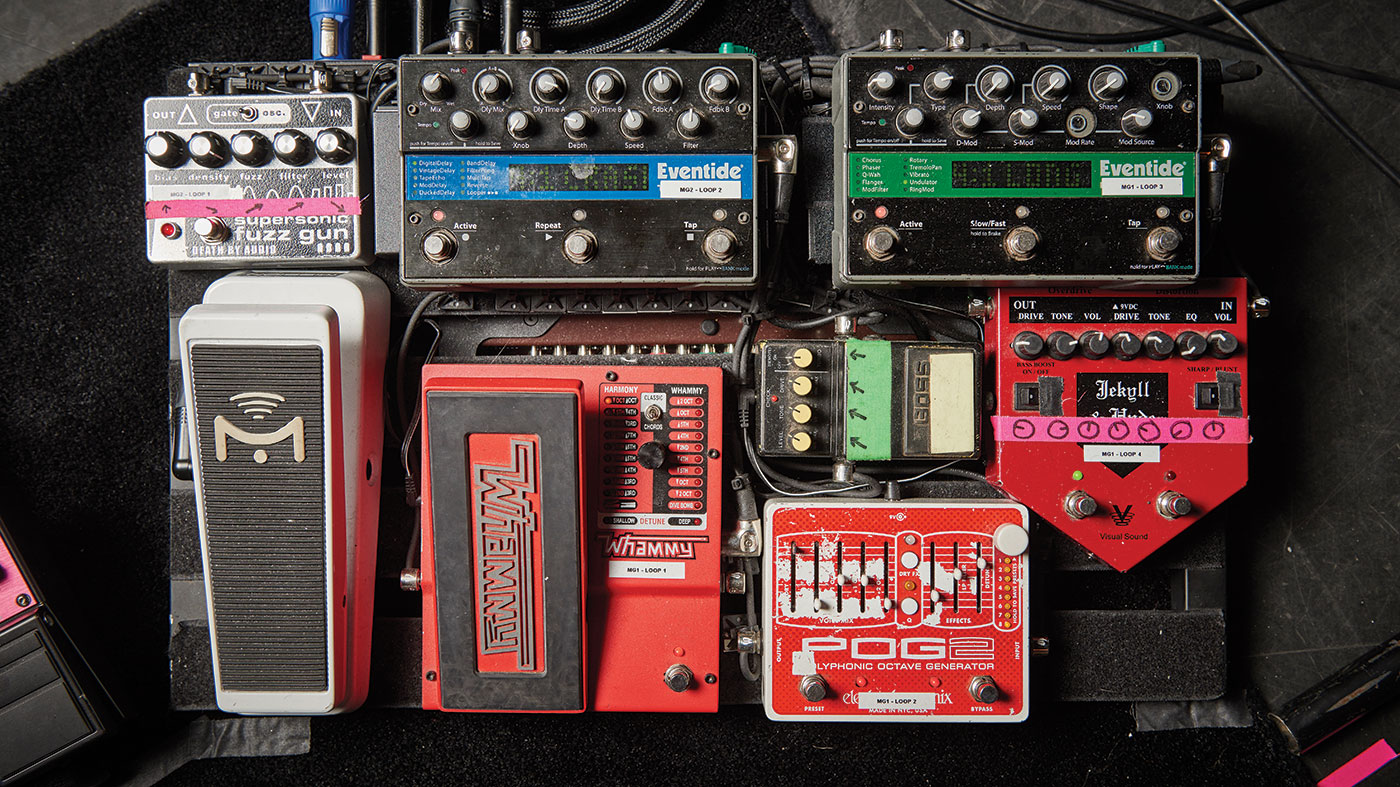
Barry McKenna, Twin Atlantic
Death By Audio Supersonic Fuzz Gun
“This is the most badass pedal I’ve ever owned. There’s a switch between gated and oscillated modes - when it’s gated it still sounds mental, but in oscillation… everything just kicks in.
“The moment you stop playing, you get these crazy wails and siren noises. It’s quite untameable, but I quite like that. Every night we use it, things sound a bit different because it’s impossible to control.”
Visual Sound Jekyll And Hyde V2
“Our old guitar tech, Brian, also worked for The Strokes and one day I was talking to him about overdrive. He recommended this - which was the only pedal The Strokes used on their first album, and he had the actual pedal they recorded with, which he lent to me for a bit. The tones are insane, and you can hear it all over that debut record.
“I even got to use it live, but I had to give it back when he was next out with them. The company had changed hands and the newer models didn’t have the same components, which is why I found this specific version.”
DigiTech Whammy (5th Gen)
“I’m always searching for new sounds out of boredom. Every guitar player should fuck around with their tone, you don’t want the same sound all the time.
“And what I love about the Whammy is that it can do so much more than what it’s famous for. It’s actually my new favourite chorus pedal… I almost don’t want to give that secret away! Basically, if you stick it in deep detune and leave the heel all the way up, you get this really sweet chorus.”
Eventide TimeFactor & ModFactor
“It’s simply a fact that Eventide make amazing pedals. The Modfactor takes care of a lot of my choruses and flangers, tremolos, swells, they are just so many tricks to it.
“I liked it so much I got the Timefactor over the Strymon delay, it just made me want to stick with Eventide. Plus I can control everything from my Mastermind [MIDI controller].”
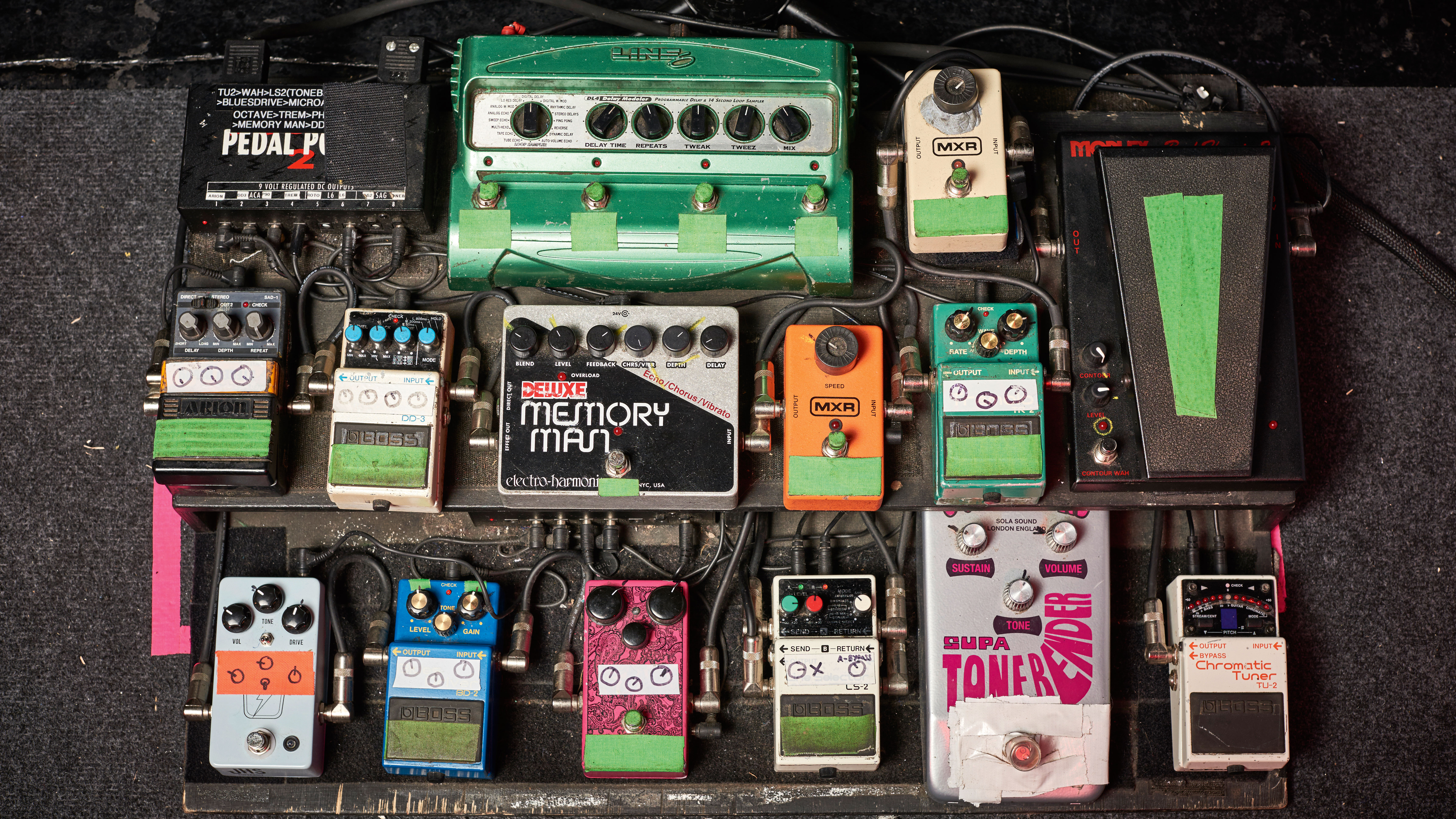
Grant Nicholas, Feeder
JHS SuperBolt V2
“It’s an overdrive. I’m using this for the track called Eskimo for the verse sound. It’s kind of on the edge – like an amp just breaking up. It’s a really versatile pedal, and similar to the Blues Driver.
"I bought it to do my solo stuff so I could overdrive the acoustic a little but I never used it. If I had more room on the ‘board I’d put my Pete Cornish pedal on there but it’s so big.”
Boss BD-2 Blues Driver
“It’s just a really good all-round pedal and I find them really robust. They’re great for that in-between sound. Loads of bands use these, they’re just really good. They’re great at that classic rock sound and you can do a lot with them."
Boutique Tone Bender-style fuzz
“I bought it on eBay, some guy made it. I just took a gamble on it because I thought it would be really good if I could get a Tone Bender in a smaller box without having to get one made.
"It’s actually really close so he’s either taken the guts of a Tone Bender and put it in there or managed to replicate it in some way. So it’s a backup for my Tonebender and I’ve set it on a lower level that I’m using on some of the new songs.”
Boss LS-2 Line Selector
"That activates the Tone Bender because I was a bit nervous about the old switches. I’m also driving it a bit more [with the boutique pedal] so it’s changing the sound slightly.”
Colorsound Sola Sound Supa Tone Bender
“The settings rarely change on this. In soundcheck I might back off the top end a bit because it does make a difference – it’s really fierce in some venues.”
Boss TU-2
“I’ve got two or three of these. I’m just used to them now. I even used this to tune all of the guitars on the record, too – I didn’t use any strobe tuners for it. They may not be as exact as some of them out there, but they’re easy to use.”
Morley Bad Horsey 2 wah
“My use of it can vary from track to track. I’m using it quite a lot on the song Tender for sweeping effects with the delays. I use it on Eskimo a little, for psychedelic rocking out bits. I use it for slow sweeps, I’m not doing any wah solos with it or anything like that.
"I used to have a standard Vox one but I found that it’s so hard to turn the switch off sometimes. I quite like the fact it’s instant with this one.”
Boss TR-2 Tremolo
“I’ve had this for years. I use it on the intro of Yesterday Went Too Soon, it’s really just set for that but it’s not in the set for tonight.”
MXR Phase 90
“I’ve always had a phaser on my pedalboard. I just like them – they’re crazy. I’ve got the larger control cover there so I can change it with my foot on stage. I use that quite a lot when I’m doing things like Descend, though we haven’t played that on this tour.
"A lot of the early Feeder stuff had some mad phaser stuff that was on fast speeds, so you get that fast, almost synthy, sound.”
Electro-Harmonix Memory Man Deluxe
“This and the Tone Bender are really key to my live sound.
"I just use it a lot for solos, I’m using it on the vibrato setting mainly. It’s great for recording, too. I’ve got some really old Memory Mans but they’re just too big and unreliable to take on the road.
"They’re proper old-school sounding, which I why I like them; that organic analogue sound.”
Boss DD-3 Digital Delay
“I’ve used this pedal for years now – since the early Feeder days – and have a few of them at home as backups. I really like the early ones more than the later [Boss DD delays], they just sound a bit better to me.
"There’s too many options to play with on the newer ones. The DD-3 is used as a general delay that I put on if I feel like it. It does get used a lot, sometimes in a verse to give it a little bit of depth.”
Arion SAD-1 Stereo Delay
“It’s started playing up on this tour for the first time in 20 years. It was given to me by Darren who is now part of our management team. I thought it looked a bit crap and plasticky.
"Plugged it in and thought it sounded brilliant; it’s got a real analogue old-school sound to it that does something I love. I did buy another one of these on eBay, plugged it in and it sounded completely different.
"They’re getting hard to find now, and this is probably 25 years old now. It’s like it’s alive, every time you plug it in it’s different… a really funny pedal. It gets used a lot.”
Line 6 DL4
“I use it more for the tap tempo when I want to do a few trippy things. I don’t use it much, but it’s a useful pedal to have on your ’board. It’s a backup if I have issues with any of the other delay pedals, too.”
MXR M133 Micro Amp
“It’s a little boost so if I’m really struggling to hear myself on a solo I can just hit that. It’s just like a volume boost.”
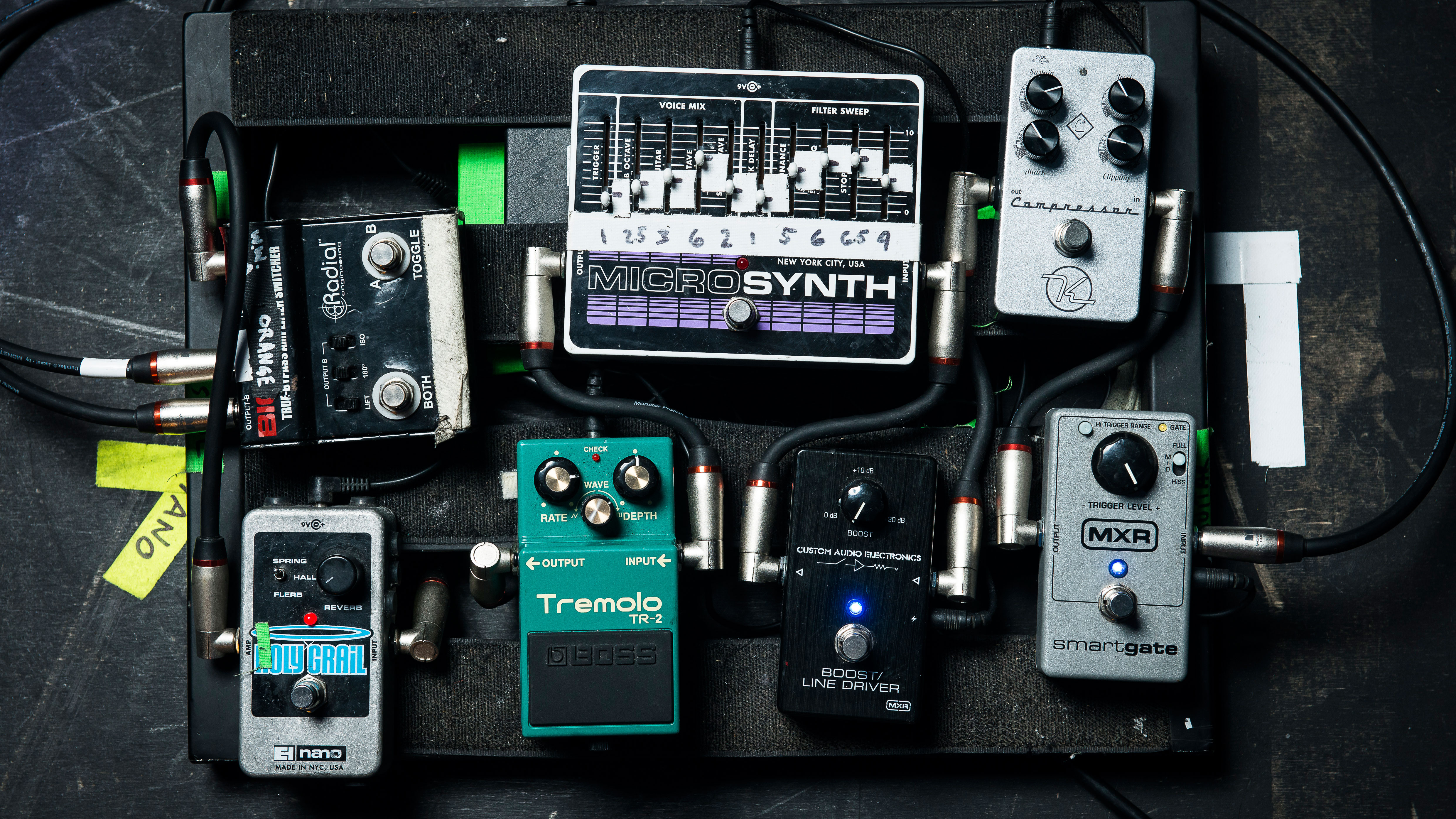
Neil Fallon, Clutch
Electro-Harmonix Micro Synth
“This is primarily here for me to use on Our Lady Of Electric Light. It has that analogue tone I love, set to a swell mono-synth.
"I’m a big fan of Pink Floyd’s early synth sounds, and this is the closest thing I’ve heard in making a guitar sound like that. There are others out there, but I often find them to be a bit too contemporary for me. You can switch this and make it percussive, with the gate open.
"You can make it really sizzly or really mellow, rolling off frequencies to the point where it doesn’t even sound like a guitar at all anymore, really.”
Boss TR-2 Tremolo
“I got this here in the UK when I left my Strymon Flint at home, it’s just a basic Tremolo. I think people sometimes over-think these things, maybe a Boss pedal might not sound as boutique as others, but it does the job just as good as any.”
Custom Audio Line Driver Boost
“We keep this on just about all the time. It comes off for the more dynamic songs, like Son Of Virginia or Regulator. It also gives the Fender some more cajones, it helps with growl. It doesn’t colour the sound much.
"Sometimes it’s hard to differentiate boost from a distortion. I tend to want the same tone just more in quantity, and that’s exactly what this does.
"It’s feeding more food into it all, instead of being a glorified distortion pedal.”
Keeley C4 Compressor
“It’s a killer compressor… I’ve used a number of them over the years, but this one seems to sound the best. We have a lot of dynamics in our set.
"I never used to appreciate compression because it was less obvious than something like a distortion pedal. As for modulation effects… that’s more Tim’s world. I won’t be doing a psychedelic solo anytime soon.
"That’s not in my future, I think.”
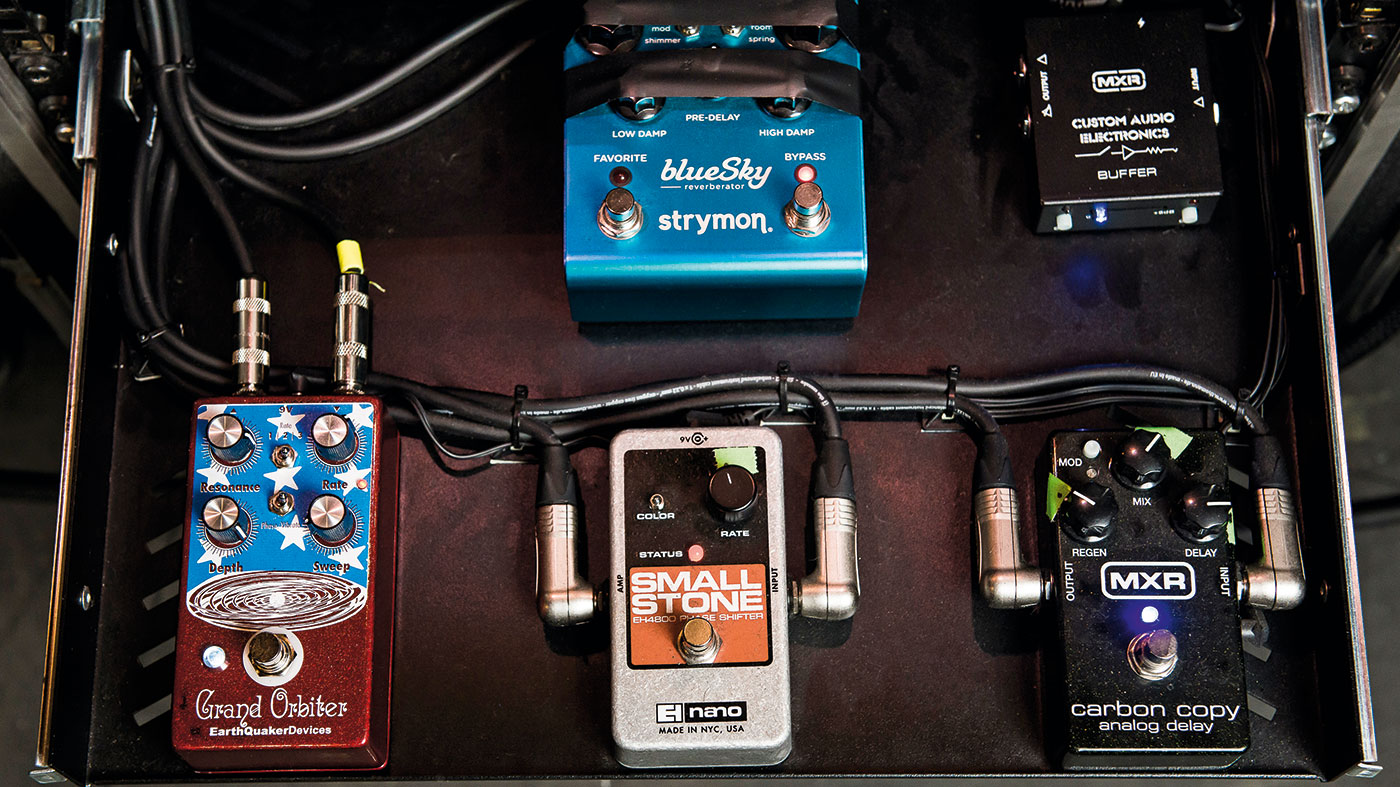
Mikael Åkerfeldt, Opeth
Electro-Harmonix Small Stone Nano
“The Small Stone is my favourite phaser, I use it a lot on my clean sounds. I originally bought one of the Russian ones in military green and it looked like a landmine!
“I got that for My Arms, Your Hearse [1998] - which was a long time ago, and I’ve used it all over the place ever since. The footswitch fell off so I had to buy this new one.”
MXR Carbon Copy
“The Carbon Copy I’ll kick in whenever I feel, usually for leads or solos. I might change it soon because I got a new delay from Dunlop that I forgot back home. The only reason being the Carbon Copy might be a little too mild for my needs, almost a bit subdued. I want more juice! Nothing too digital, but something just a bit clearer.”
EarthQuaker Grand Orbiter
“I got this in Akron, Ohio, and it’s actually made by a company based there called EarthQuaker Devices. It’s a phaser, but with a shitload of sounds within it. At the moment, I only use it for isolated chords to get this underwater effect that makes you sick to your stomach!”
Strymon BlueSky
“I love the Strymon reverb, I have it set on spring and it’s pretty much on all the time. You could say I am very generous when it comes to reverb! I want lots, unlike Fredrik, who wants more of the dry tone so every note pops out. I’m the opposite - I want the notes to disappear into the reverb. I absolutely love this one. It was very expensive… for a pedal!”
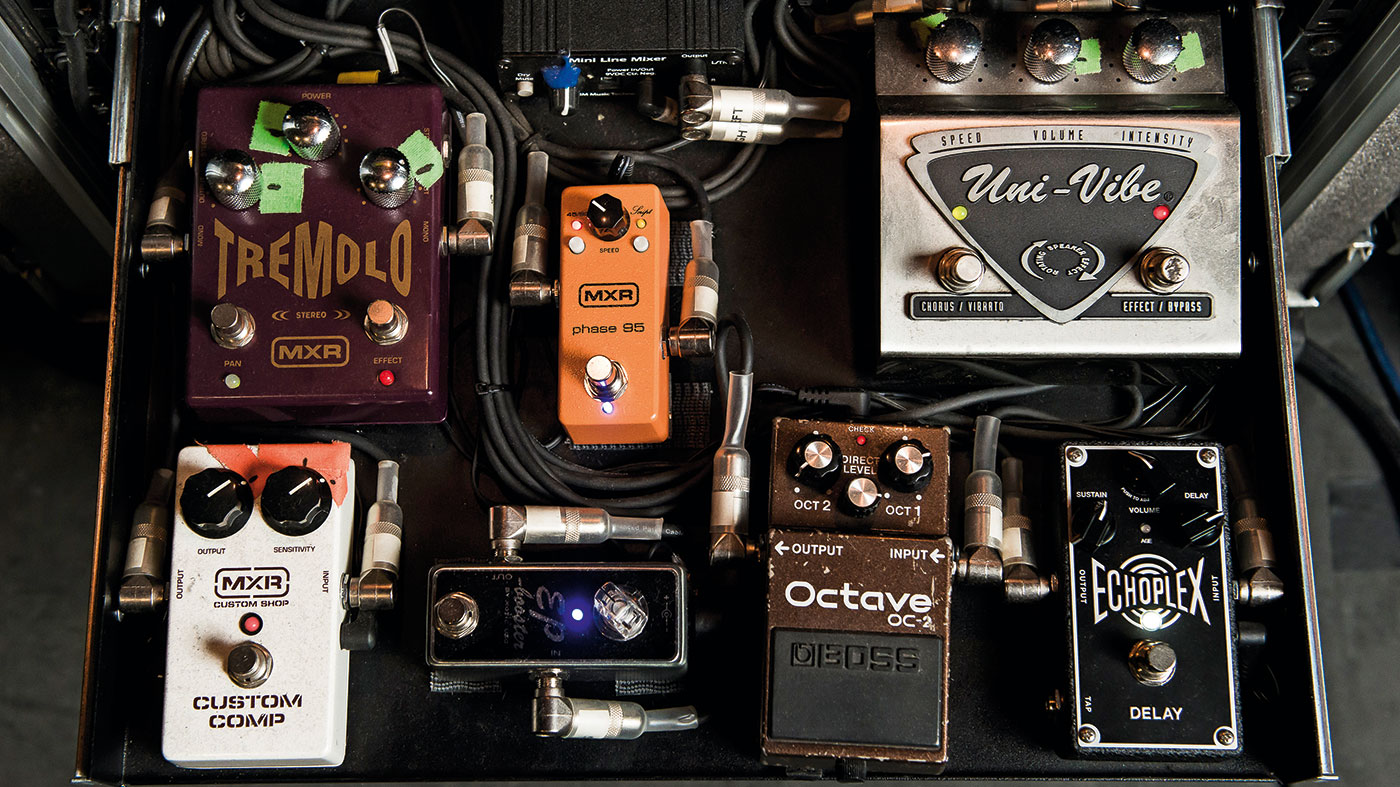
Fredrik Åkesson, Opeth
MXR Phase 95
“I just picked this up from the MXR guys in San Francisco. It’s a brand new model which has the old Phase 45 as well as the 90, then you have the script mode, too.
“I’ll kick it in for some leads whenever I want that flavour… and especially if I want to sound like Van Halen! [laughs]”
MXR Custom Comp
“I don’t actually use this compressor much - it’s mainly for the song Atonement, where I play a freaky solo at the end using a cleaner tone with loads of boost and echo, kicking in the Cry Baby rack. It creates some unusual sounds… it actually helped me to come up with the solo I play on the live version of that song.”
Xotic EP Booster
“It’s based on the Echoplex booster and I pretty much have it on for all solos - but nearly set to zero. It makes the notes pop out a little more and gives things an extra push over the cliff edge!”
Dunlop Echoplex Delay
“This pedal is really interesting. It’s a new delay with a tap-out which I will start using soon, I used to use a Carbon Copy but I’ve switched to this now. It has a longer delay time, it’s a bit clearer but still with a vintage touch - you can dial in the flutter and oldness of the tape, which I like. There’s a lot it can do and it’s perfect for adding into solos.”
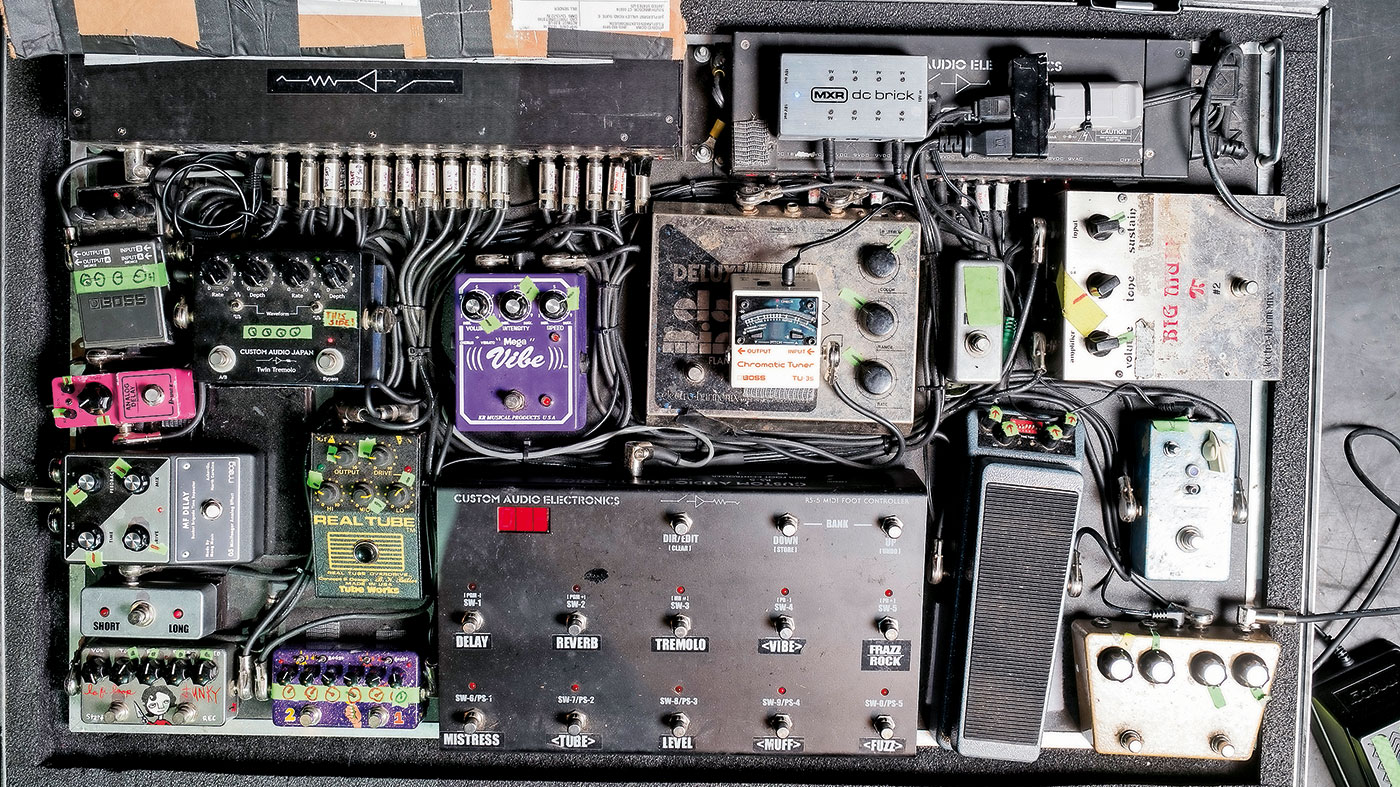
J Mascis, Dinosaur Jr
ZVex Lo-Fi Loop Junky
“I got this before an acoustic show in New York. I thought it would be good to get a loop to jam with myself a little bit. I thought this was cool because it was all-analogue and very easy to use.
“It seems to cut off a lot of the high frequencies; it just can’t reproduce them because of the chip in there. They make you sound a lot darker, so it’s like having two separate tones. You can even make your guitar warble as it plays back. Then I started using it for the electric shows for those noisy jamming parts or even in between songs so no one has to hear silence!”
Moog MF Delay & Ibanez Analog Delay Mini
“I started using the Moog for recording, I just liked the sound of it. They brought out the smaller version that fits on my pedalboard. It has an expression pedal which I’ve been using to turn the speed up and down to get the wacky sounds I like.
“I use it on Gargoyle - which we usually play last - Watch The Corners, sometimes on Get Me… whenever I feel inspired to switch it on. I really like the short echo on the Ibanez. I’ve been using it for the solo on Heaven, it’s a bit of a different sound to the Moog, but they’re both analogue. Plus it’s pink…”
Boss RV-5 Reverb
“I’ve had this for a while. I always try to check out different reverb pedals, but this is the one I keep coming back to. Usually, I prefer not to use a Boss pedal if I can, but this one works better than anything else I’ve tried.”
Custom Audio Japan Twin Tremolo
“I really like the square wave sound of this pedal… you can get it going really choppy and super fast. I used to have the rack-mounted version, but Custom Audio told me about this Japanese pedal version and I had to get one!”
Tube Works Real Tube Overdrive
“This is responsible for my main clean sound… it only has a little bit of drive dialled into it. I can turn down the volume and it still sounds really good. I like doing that so when I turn on the Big Muff it gets louder... though with four amps, it’s always loud!”
KR Musical Mega Vibe
“At first I used to use a Roger Mayer Supervibe, which was a rack-mounted vibe unit. The Mega Vibe is closest I’ve heard to that thing in a pedal version. I’ll use it on Knocked Around, Gargoyle, Freak Scene with the flanger added for colour and volume.”
MC-FX Super-Fuzz Copy
“These were made in Australia, I’m not sure if they’re in production anymore. I have original Super-Fuzzes, but I love the sound of this one and, again, it fits on my ’board. I kick it in for solos and extra fuzz when things get super crazy.”
Rangemaster/Tone Bender MK1 Copy
“One side is a Rangemaster copy and the other is a Tone Bender Mk1 copy. This was made by Jim Roth from [American indie-rockers] Built To Spill, he gave me a Tone Bender copy a while ago. I really liked it but had it remade with a Rangemaster to save space.”
Z.Vex Double Rock
“I actually asked them to build two overdrives into one pedal. They made it for me and now they’ve started producing them commercially. I’m usually pretty set on which distortion I’ll use from song to song, but sometimes during solos I’ll switch on different ones when I feel like it.”
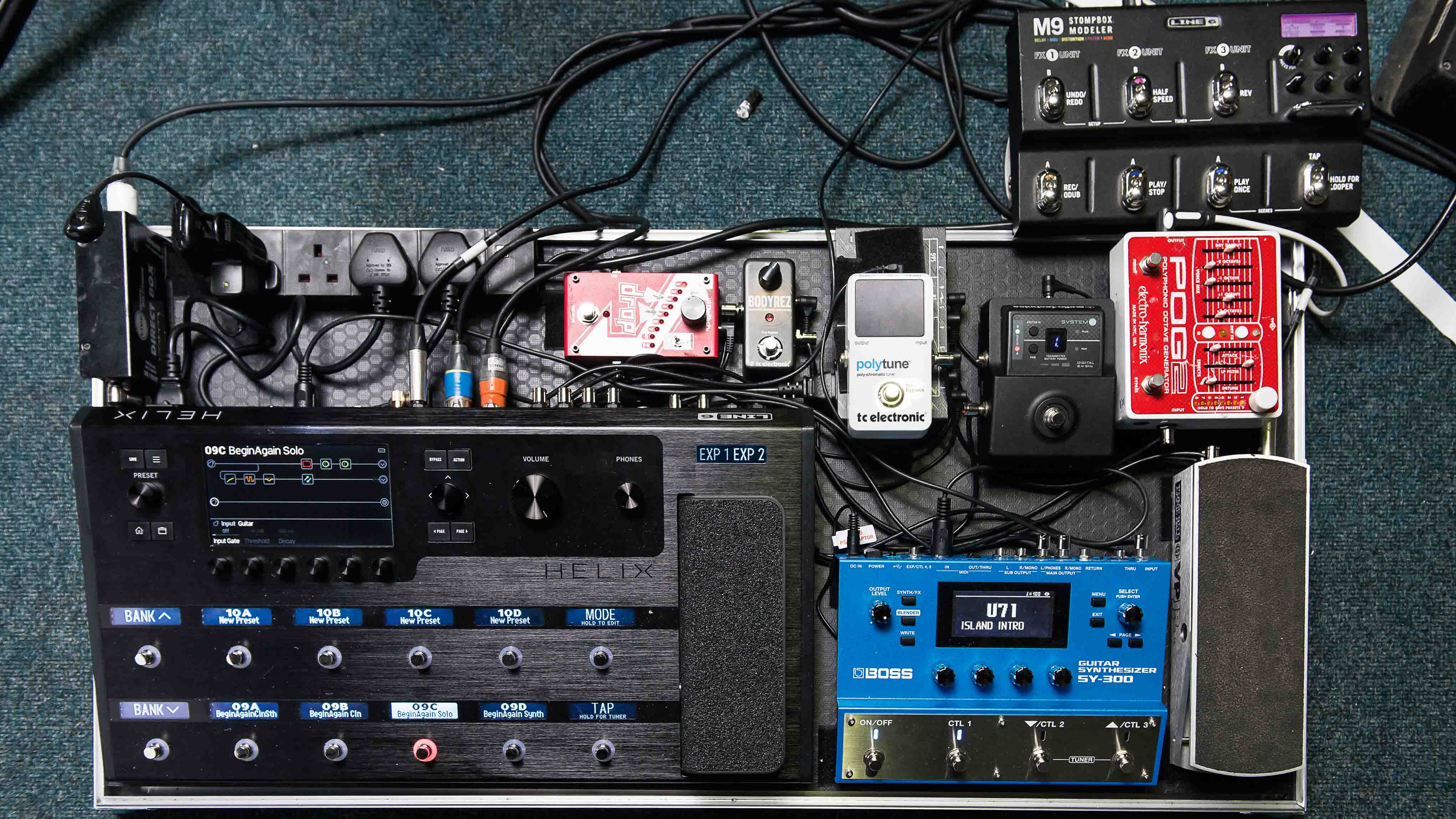
Peredur ap Gwynedd, Pendulum
Boss SY-300
“The best thing about this invention is that you don’t need one of those Roland Hex pickups. It uses the same technology as the [TC Electronic] PolyTune, picking up each individual string which separates everything – it’s polyphonic, like the [Electro-Harmonix] POG2.
“Guitar synth pedals have usually been monophonic, and somehow they managed to sort it out with this one. As soon as I saw it on the Chappers and The Captain YouTube channel – I think they’re very funny, by the way – I instantly knew it would be perfect for Pendulum. It’s pretty new on my pedalboard, I can’t wait to get using it more.
“I’ll be bringing out the same rig for my Faithless sets, too, so I know this will come in handy. It tracks perfectly, and I can use my amp sound to double up underneath. You can get some amazing pads out of this thing. It’s fun for playing those Queen riffs with that trumpety sound, like Brian May’s leads on I Want To Break Free.
“It’s been a great investment already, but this is just the first version! I can’t wait to see what else they’re going to come back with for version two or three. The fact you don’t need a special pickup really opens things up - those things are a pain in the arse! You need to screw them in or maybe use double-sided sticky tape, then have a 13-pin lead, which they don’t make wireless units for… no-one wants that.”
Electro-Harmonix POG2
“Electro-Harmonix are very clever people! This pedal can create that 12-string effect, but it’s almost like 18-string because you can go two octaves above.
“I’ve always been a fan of making the guitar not sound like a guitar. Don’t get me wrong, I love how guitars sound, but I find myself drawn to more synthetic sounds. You can also use the POG as an octave pedal - I can go two octaves below to the point where the PA can’t handle it! It’s a very creative pedal and actually a great tool for songwriting.
“I’m not into using too many pedals at once. When you do that, your tone goes to hell – it sounds like a bloody mess. I’ll have a compressor, the POG, some delay and that’ll be it… I don’t like going beyond that.”
Line 6 M9
“There’s an effect on this Line 6 pedal called The Growler that I absolutely adore. The harder you drive it, the more the frequency overloads… which can transform your guitar into something close to an analogue synth. It’s really dynamic and responsive in that sense. I also use the pattern tremolo to cut my signal up as another special effect of sorts.”
TC Electronic BodyRez
“My PRS P24 has a great piezo pickup in it, but it still sounds like a normal DI’d acoustic out front, and remember, even if you put a £10,000 Martin through a PA, that’s inevitably what it’ll sound like. So the TC Electronic BodyRez really helps me tap into more of that wooden body resonance. God knows how they do it: one knob and that’s it. It’ll make any piezo sound more like a mic’d-up acoustic, plus you still get to use your whammy bar!”
Ernie Ball VP JR 250K (Passive)
“If you only use the knob on your guitar to control your volume, it limits how much you’re able to do on the fretboard. These pedals are also very handy for changing guitars on stage as well - no-one wants to hear that jack lead clunk in between songs!
“The Ernie Ball feels like the most solid one I’ve come across, and I’ve tried a lot of them. The Morley is pretty good, too, but there’s no tuner out on it. I’ve got one of the miniature ones, which are great for pedalboard real estate!
“The Ernie Ball models are just solid… the pots are connected by string mechanisms, so you really can’t break them. I find the other ones that are physically connected are more prone to damage.”
DigiTech Drop
“There are probably other similar pedals out there, but DigiTech knows exactly what its doing when it comes to bringing pitch up or down. I’ve had this one for about a year and, to tell you the truth, it didn’t replace anything on my pedalboard – it replaced four guitars!
“We tune to Eb, but in the past I’ve needed extra guitars for songs in D. The Drop shifts it for me and has cut my rig down from six instruments to two, which as you can imagine, makes life a lot easier!”
Audio-Technica System 10
“This is the wireless system that receives my signal. I’m actually wearing two packs on stage – one for acoustic and one for electric. The electric signal is split first – the guitar runs into the amp, as well as through the pedalboard then the PA. I can do whatever I want with either side of it.
“I can have a DigiTech Whammy going over a distorted chord behind it. So altogether, there’s the amp sound, the DI modelled sound and then the final acoustic out. Our sound engineer gets to blend it all together.”
Line 6 Helix
“The Helix is mind-boggling and I’ve only just begun to scratch the surface with what it can actually do. I saw a video of [British guitarist and demonstrator] Paul Hindmarsh explaining the idea behind it and as soon as I watched that, I realised I needed it in my life.
“With Pendulum, we have this massive crossover thing going on – we’ve done Download Festival three times, as well as the more mainstream ones. So I take different influences from different people, of course, but I like experimenting with whatever I can.
“It’s not a new thing: look at the weird sounds Robert Fripp was getting back in the day. But I do see this kind of equipment as part of a new generation. My rig is very much a work in progress – I’m making it up as I go along. I just watch YouTube clips thinking, ‘I want that and that!’ and put it all together to see what it sounds like. It’s pretty mental!”
TC Electronic PolyTune
“The PolyTune mark one is still the most important pedal I own out of them all! Being in tune is definitely important. Before you even get to the sound, you’ve gotta make sure your guitar’s in tune… otherwise you’ll sound like a dick!”

Dustin Kensrue, Thrice
Gain stages: 2x Mojo Hand FX Kensrue Rook, Walrus Audio Harvester, Walrus Audio Iron Horse, JHS Muffuletta
“One Rook is for when I’m using the bridge pickup, and one is when I’m using the neck pickup, so they’re just EQ’ed slightly differently to get those pickups to sit more in the same space – I really hate the overly muddy sound of a neck pickup when I’ve set it for the bridge pickup.
“One of the Rooks is always on, so it’s my baseline tone, and then I’ll use the Line 6 M5 to notch down one or two steps with the volume pedal on there, so that’s decreasing the input into the Rook.
“I have five levels [of gain]: three is the Rook, I can go down two on the input, and then if I want to go up, I add the Harvester in line, and then the next level adds the Iron Horse.
“That Iron Horse is really cool, and that’s my main bigger rock tone, and it can handle getting a bit jumpy without sounding like a Metal Zone or something – it still sounds really musical and full. And then I’ve got the JHS Muffuletta, where they basically put all of the Muff circuits in one pedal, and I’m using their own custom one – it’s really cool.
“That stacks on top of the other ones, so it’s a lot of stacking. The reason I end up doing it is because I was really trying to keep a consistent tonal palette as it built, and I wasn’t liking it going to something completely different.”
FAMC Liquid Foot+ Mini MIDI controller/2x Voodoo Lab Hex Audio Loop Switcher
“Everything on there is tied to that Liquid Foot, and so that’s controlling those two Hexes on top from Voodoo Lab, and they’ll turn any of the things on or off, and then it will also MIDI control which effects are on on the Strymons, as well as the Line 6. I modded the POG 2 to receive MIDI signals as well.
“It’s a lot of work to set up, but once I’m playing, I only have to hit a button and it will change a variety of things. So, with me singing, I just got really sick of dancing around. There are song-by-song presets, and a general logic to the way that I lay out the five or so buttons that I’ll push.”
Walrus Audio Deep Six
“I’ve never used a compressor until really recently. I just didn’t find one that I liked; it felt like it was crushing the tone, and I didn’t feel that way about the Deep Six.”
JHS Mini Foot Fuzz
“It’s a fuzz pedal, but it’s not incorporated in anything yet; I’m just playing around with it.”
Strymon BigSky, Strymon Mobius, Strymon TimeLine
“They’re all over the place. They’re on a lot of stuff, but I think that the BigSky is just phenomenal, and so I use that a bunch now to transition between songs. There’s a setting on the Liquid Foot that I can hit and it will create a pad out of what I was just playing that will hold until I click something else off, and it’s super-helpful just to help with the flow. But that thing is super-versatile, and it just sounds amazing. All those pedals are fantastic.”
Electro-Harmonix POG 2
“I haven’t used it before this record, but it’s on a lot of the kind of lead stuff; it’s just in there a little bit, so the main riff on Hurricane, it’s on there, and it’s on the guitar in the verses of Stay With Me. So, it’s in there pretty subtly, but it adds a thickness and dimension to some of that stuff.”
Line 6 M5 Stompbox Modeller
“It’s the Swiss Army knife. I feel like it’s not super-useful on its own, because you can only have one thing on at a time, but there’s so many random little things that you can do with it that being able to control with the MIDI is super-helpful. So, I’ll have this spot where I have this weird synth sound in the middle of All The World Is Mad, and I use it for volume cuts right now.”
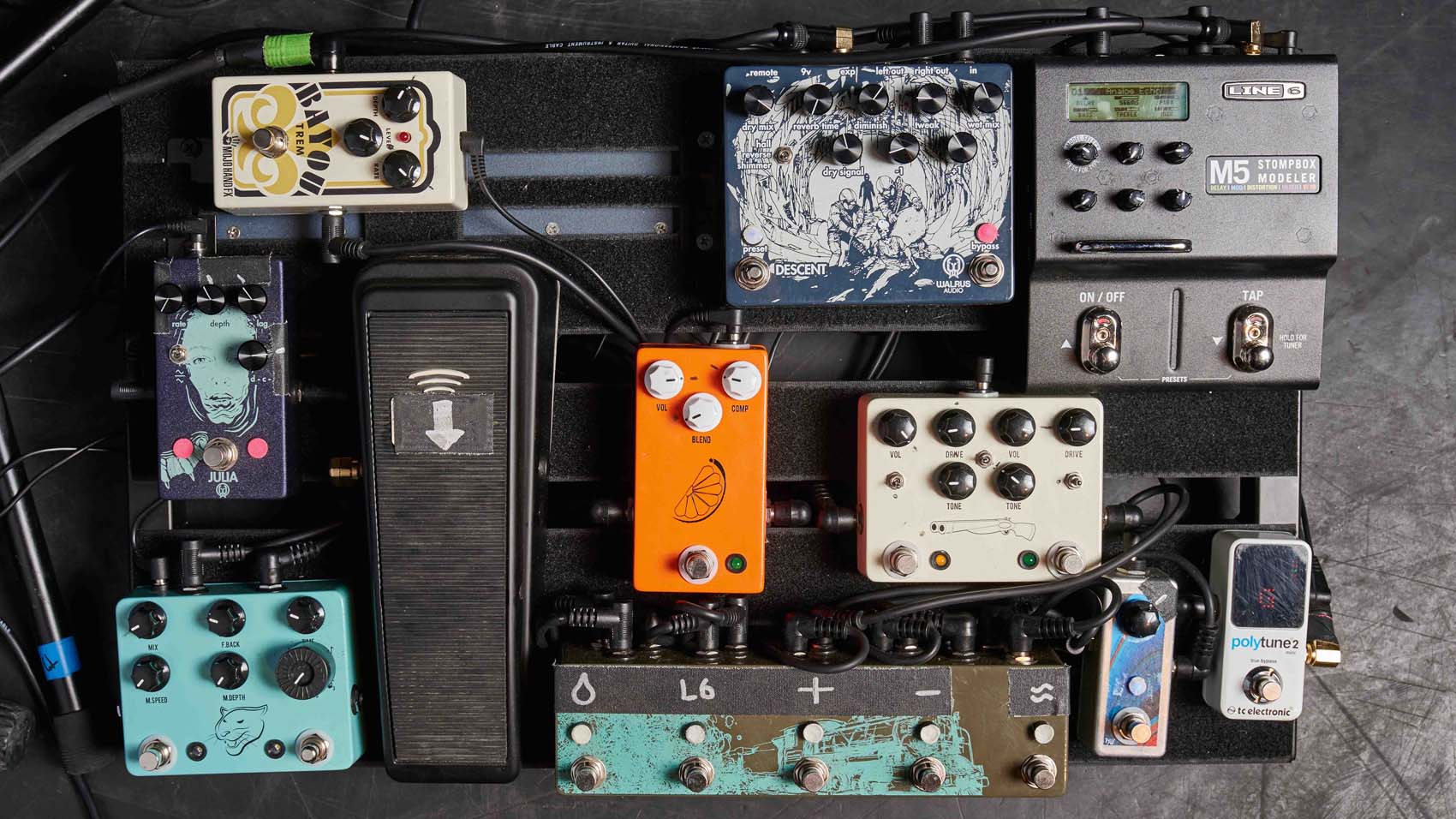
Teppei Teranishi, Thrice
Walrus Audio Julia
“I actually never liked choruses ever, but we ended up using quite a bit on this last record and it just worked, so I was like, ‘I guess I need a chorus pedal now!’ So Dustin was like, ‘Try this one!’ and I really like it; it’s beautiful-sounding. It’s got the chorus and the vibrato, and then you can actually blend in between, so I think it’s the vibrato that’s winning me over – I’ve always thought vibrato’s really musical and pretty.”
Walrus Audio Descent
“There’s three different presets that you can do with that, so I just have a basic hall-type setting, one that’s a little more spring-sounding, and then one that’s the shimmer octave setting. There was this pedal that we used to use called the [Boss] PS-3 Pitch-Shifter/Delay – the Cave In pedal was what we called it. And so that has that vibe, and we use that on quite a bit of stuff. So, I’m using the shimmer setting as my PS-3-ish thing.”
JHS Panther Cub
“That’s my analogue delay, which has got tap tempo. It’s cool – it’s got the different subdivisions, but I just keep it on one. That’s my only delay.”
Walrus Audio Transit 5 True Bypass Switcher
“I basically have all the wet stuff running in one loop, so I can turn that on and off. And then I’ll turn little things on or off for different songs – maybe one needs chorus, one needs delay, one needs reverb, so I’ll just turn those on and off.”
Saturnworks Volume Pedal
“Dustin runs his amp halfway and adds; I do it backwards, so I run my amp super-hot, and if I want to clean it up – because the Vox cleans up real nice, and it reacts to the signal that you give it real nicely – I just cut the volume for clean stuff, so that’s what that is.”
JHS Pulp ’N’ Peel
“I run it real light, always. It just adds a little mojo.”
JHS Double Barrel
“That’s just my distortion, overdrive, whatever you call it. It’s all over the board, here and there. It’s pretty simple.”
Line 6 M5 Stompbox Modeller
“That’s my, ‘I need this one random thing for this one part in this one song’ pedal. There’s a couple of things that need that for whatever reason, like the parked wah: there’s a riff in The Artist In The Ambulance that just doesn’t work without that effect. And the Whammy-like pitch-shifter pedal thing for the end of For Miles.”
Mission Engineering expression pedal
“That one is controlling the Descent. That’s just if I want more tail on the reverb.”
Mojo Hand FX Bayou Trem
“That’s just a basic tremolo, so actually I’m not using it at all on this tour. There’s just a couple of songs where I would use it on, Come All You Weary being one of them.”
TC Electronic PolyTune 2 Mini
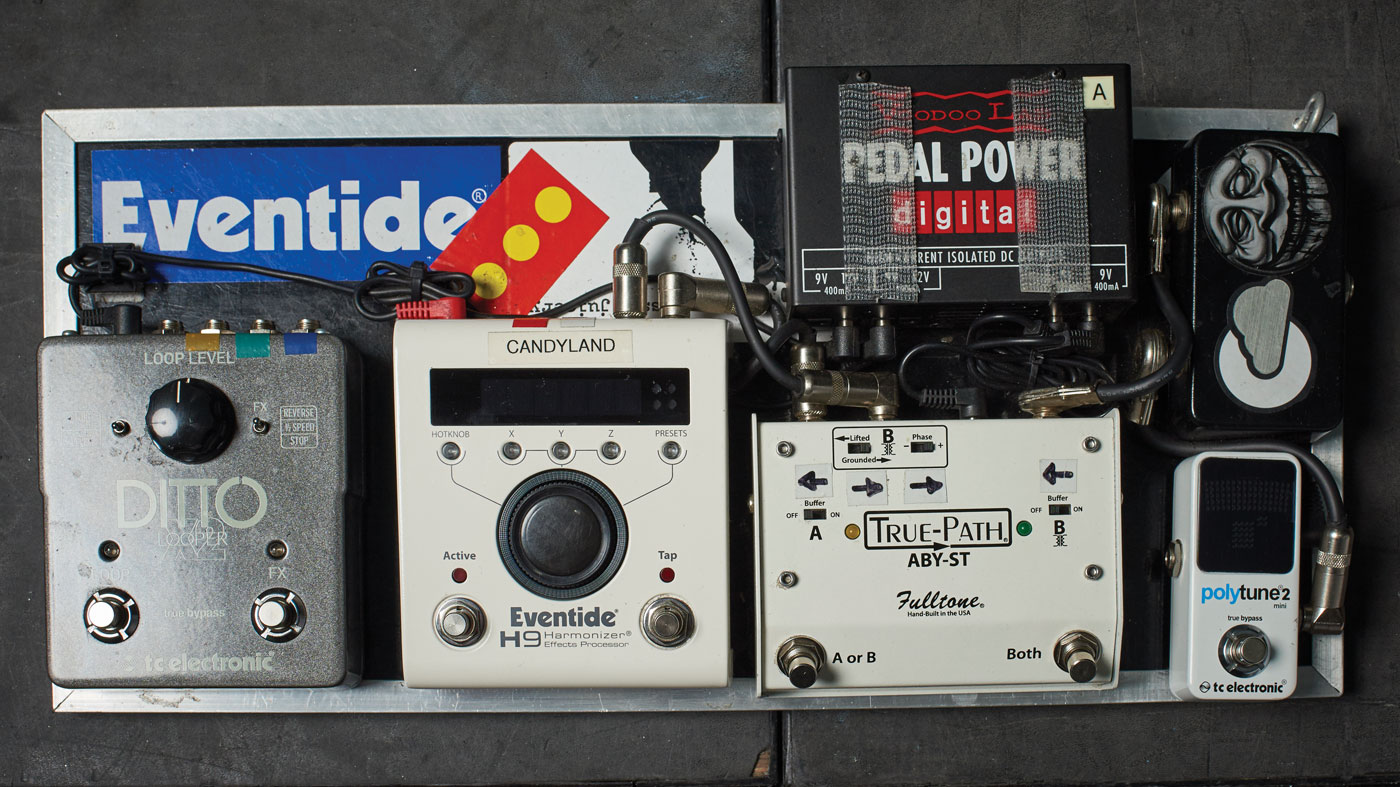
Stef Carpenter, Deftones
TC Electronic Ditto X2
“I can record whatever I want with the Ditto, then change my sound, then record more on top of it.
“On the new record, there’s two songs I do with looping… It’s impossible to keep it in time. I gave up on that. We don’t play to click, our tempos are dependent on our personalities, level of inebriation and sleep!”
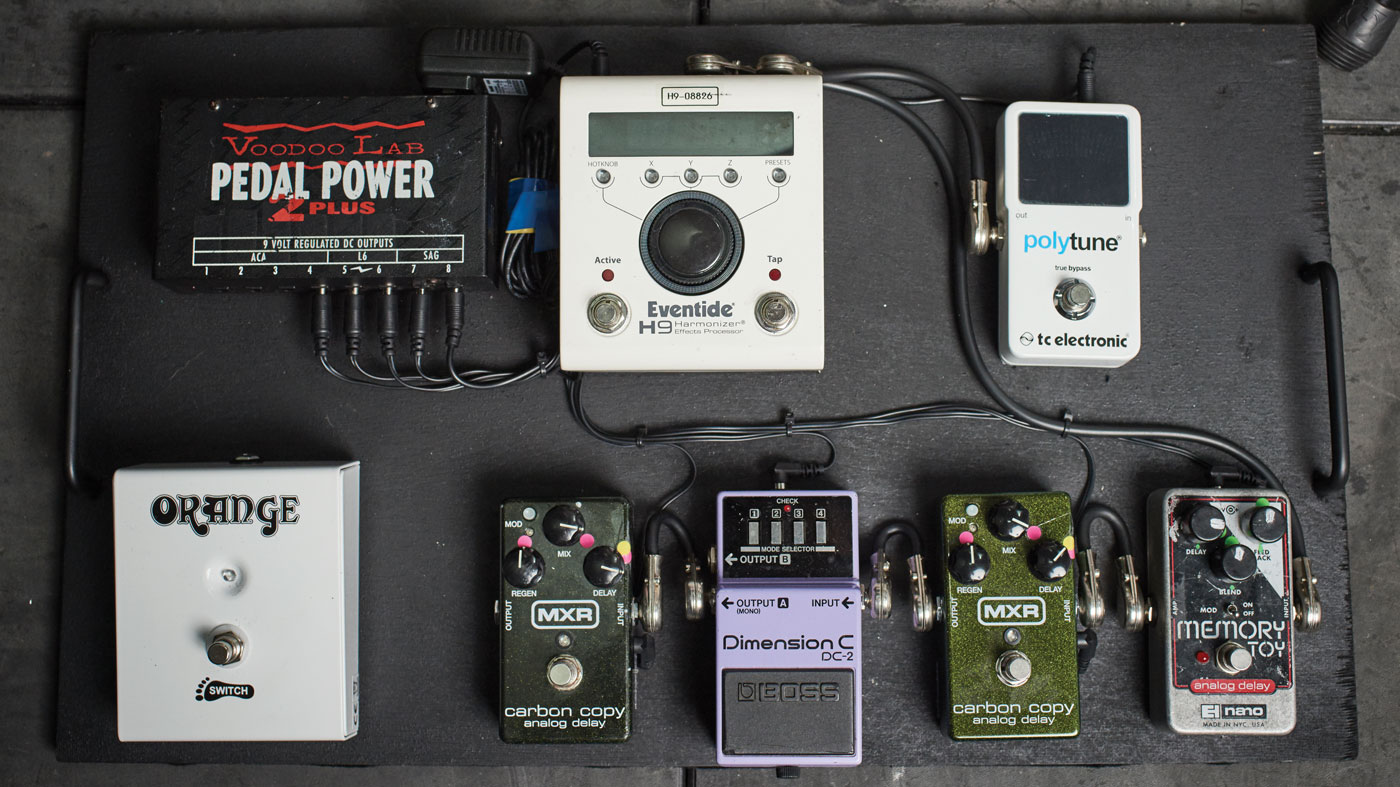
Chino Moreno, Deftones
MXR Carbon Copy x2
“The reason that I have two of these Carbon Copy pedals is because I’ll use one for most of the set, but there’s a couple of songs off the new record that have different settings - I don’t know why, I must have kicked it and moved the dial or something.
“It’s the same type of delay; repeating patterns, one of them’s just a little faster and having the extra one saves me bending down to change. I tried a lot of analog delays, but this is the one I feel sounds good, plus it’s only got the three knobs and looks real basic.”
Electro-Harmonix Memory Toy
“I use the Memory Toy for modulation. It has delay in it, but there’s this warp setting where it bends your notes out of tune.
“For a song like Rosemary, during the chorus I play this My Bloody Valentine-sounding, washy guitar line and this is how I get that sound. It’s almost like having a Floyd Rose or Bigsby, it pulls everything out a bit and sounds really neat. You can’t use it for everything, but it’s one of my favourite pedals.”
Boss DC-2 Dimension C
“The chorus pedal is rare. My buddy Aaron gave it to me, and out of all the chorus pedals I’ve tried, this one’s the most soothing and has the loveliest sound.
“It’s straight-up 80s, like Cocteau Twins and all that stuff. I’ve done a lot of research on what all those bands used, like Robert Smith used to get that out of his Roland Jazz Chorus amp, mostly. This just has four buttons on it, and is very hard to find and pricey. I take it everywhere I go and I only have one of them, so really I need to get another!”
Eventide H9
“This is the newest pedal on my 'board and I used it on the new album, so we’re slowly but surely integrating that into our set.
“To program it, you have to use your iOS device to manipulate the settings. And it’s rare I’ll get my iPad out, so right now it’s just set to the intro for Hearts/Wires. It’s like having all the super-cool Eventide pedals in one, you could make a whole album of creepy soundtracks in one night with all the sounds within it!”
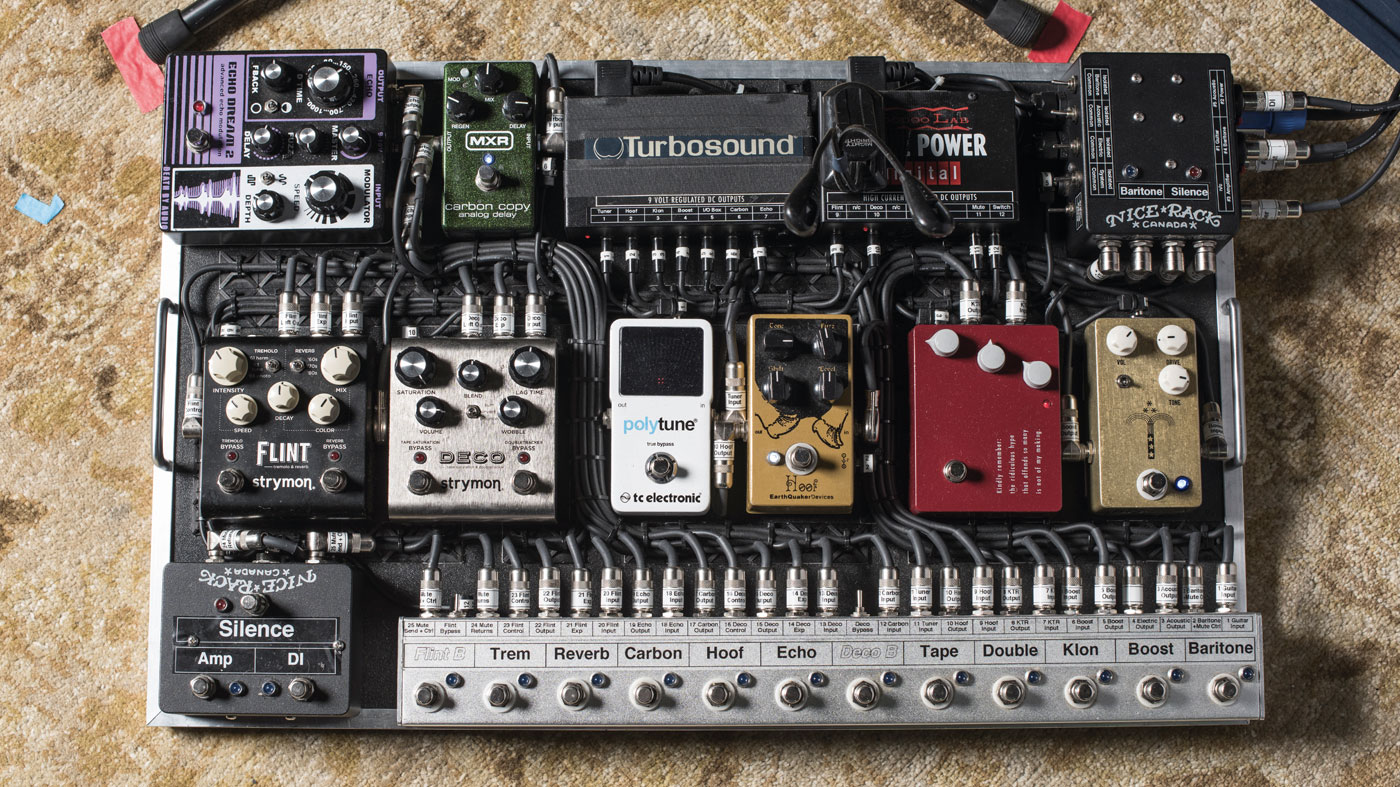
Dallas Green, City And Colour
Strymon Flint
“I just got this and I really love it. I used to have a reverb pedal and a trem pedal separately but this does both, which is great. The reverb is almost always on because I don’t have amp reverb.”
MXR Carbon Copy
“I’ve had this MXR Carbon Copy for a long time now and it’s probably my favourite pedal. I just really like the simplicity of how the delay sounds.”
Death By Audio Echo Dream 2
“This is what I call a ‘world-ender’! You step on it and it sounds like everything is destroying… it’s got fuzz and delay and I use it for the ends of songs when we’re freaking out, just having fun.”
Strymon Deco
“This one is fun. I’ve been using the tape saturation on the Deco a lot, using it as an overdrive.”
EarthQuaker Devices Hoof Fuzz
“The Hoof Fuzz is pretty awesome and kind of Big Muff-y. For Woman, which is a pretty long song, I use the Deco tape saturation for the first big ‘open up’ part and then, for the end, I use the Hoof Fuzz.”
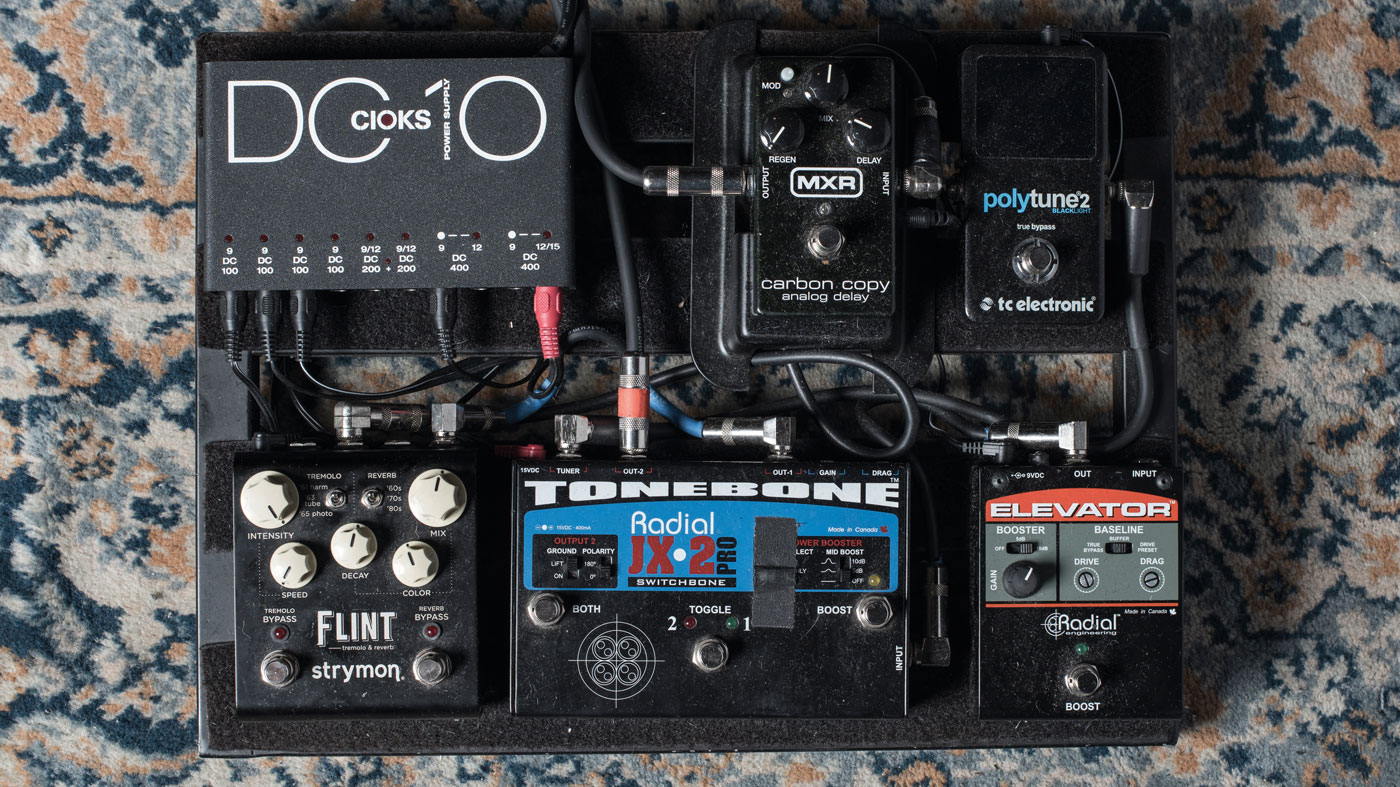
Dante Schwebel, City And Colour
Strymon Flint
“I use this a lot for Woman. It’s got this really swirly almost like Leslie sound with this harmonic tremolo and this never-ending reverb thing, which is really cool for that song.”
MXR Carbon Copy
“On a couple of songs, there’s a slapback and this sounds real good. I might use it on Lover Come Back’ or Waiting or anything that’s kind of country-ish, just to get a little bit of a Nashville kind of thing going.”
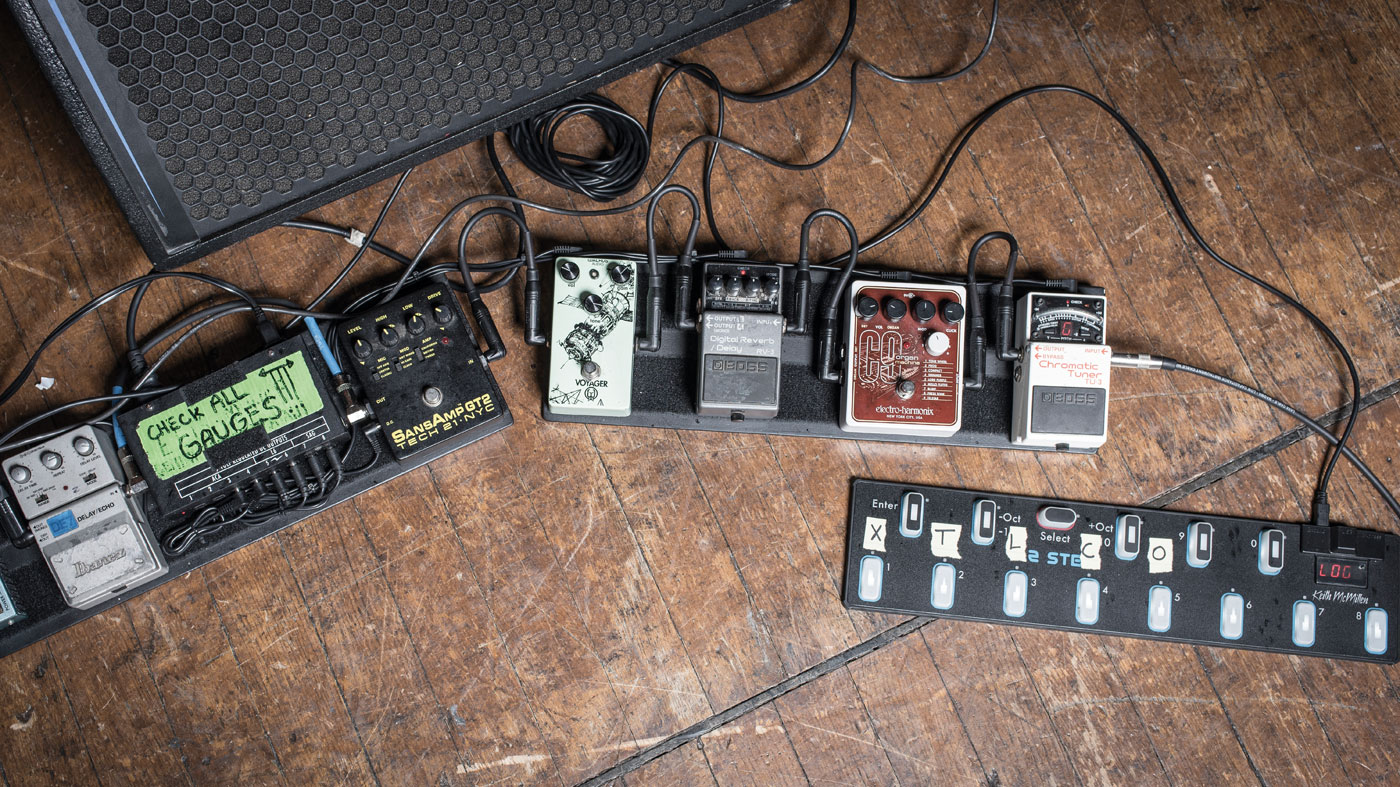
Munaf Rayani, Explosions In The Sky
Ibanez DE7
Munaf: “This was one of the first delay pedals that I got… so many years ago, maybe in ’99 or 2000. It was one of, if not the cheapest delay pedals at the store. And I just stayed with it over the years… and it craps out and it breaks out on me more often than desired [laughs], and so I have to go looking for it again - I think we have about three or four of them now, but they’re long discontinued.”
Tech 21 SansAmp GT2 & Walrus Audio Voyager
Munaf: “The SansAmp is sometimes used as a booster, but I use it more as the main distortion, and then the Walrus pedal, it gives this great kind of ‘soft’ dirt, which I use to play some lines off the newest album. But then those in conjunction help boost one another.”
Boss RV-3
Munaf: “However they wired this pedal, that’s the one that we have just stayed with. They must be on the sixth edition now and it just evolved in a way that is no longer conducive to us. I mean, right after the third! Four doesn’t work, five doesn’t work… Obviously, this one is also discontinued, so we have to go searching for it in second-hand shops and on eBay, and we have about three of those in reserve.”
Electro-Harmonix C9 Organ Machine
Munaf: “We just incorporated this and the B9 in time for the new album - they’re great, I love ’em. We’re trying to be very careful how we use them, however - because they have a very distinct effect, and I think if over-done, then its quality can get lost and it can become a bit stale.”
Keith Mcmillen Instruments 12 Step MIDI Controller
Munaf: “We were looking for a MIDI foot-pedal because we’re using more samples throughout the set. We were running it from the [Roland SP-]404SX, which is really just a sample trigger. So connecting the two - the Roland and 12 Step - allows us to have more limbs!”
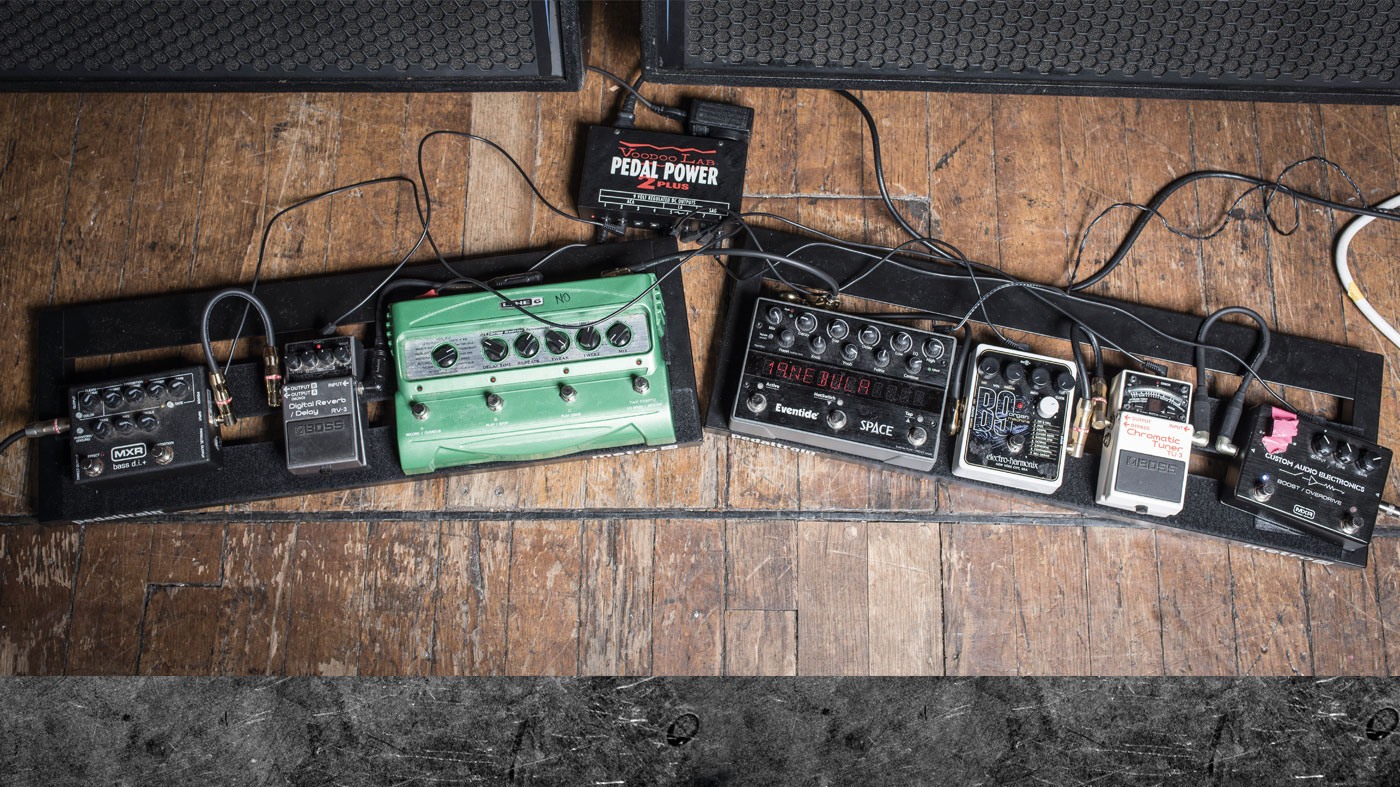
Michael James, Explosions In The Sky
MXR Bass DI
“This is just for distortion - I use it for guitar and bass distortion, actually. I got it just for bass, but it sounds great with the guitar and really thickens up the sounds. I don’t use a ton of distortion on guitar, so it’s just for big sounds.”
Boss RV-3
“The sound of the RV-3… it’s cloudy enough to mask the digital-ness of it. As the models went along, they just got cleaner and clearer - which is fine if that’s what you’re looking for, but you can also hear the digital sound of that reverb much clearer. Whereas the RV-3 puts this little sheen over everything that makes it sound beautiful and angelic, without sounding really digital.”
Line 6 DL4
“It’s a classic, man - but talk about unreliable! We go through about three a year! But I love that pedal, and we’ve been using them since the beginning. Mark and I generally use the same settings in different ways - the stereo delays mainly. Even though we don’t send it out stereo, it still gives it a very interesting bounce to it.”
Eventide Space
“When we first started writing this record I got that, and it was just the sound of a couple of songs - I couldn’t play them without it. I use about two per cent of the functionality on it right now, but the two per cent I use is amazing!”
Electro-Harmonix B9 Organ Machine
“This is amazing. We used it in the studio to get some more unique and interesting sounds, and then we realised that we had to find these sounds on the road as well. But it can sound like a circus organ if you’re not careful!”
MXR Custom Boost
“I got that because the Talman is just a very quiet guitar. Those lipstick tube pickups, they don’t have a lot of punch, so nobody could ever really hear me. So finally, our sound guy, Jeff Bird, recommended this… and everyone can hear me all of a sudden!”
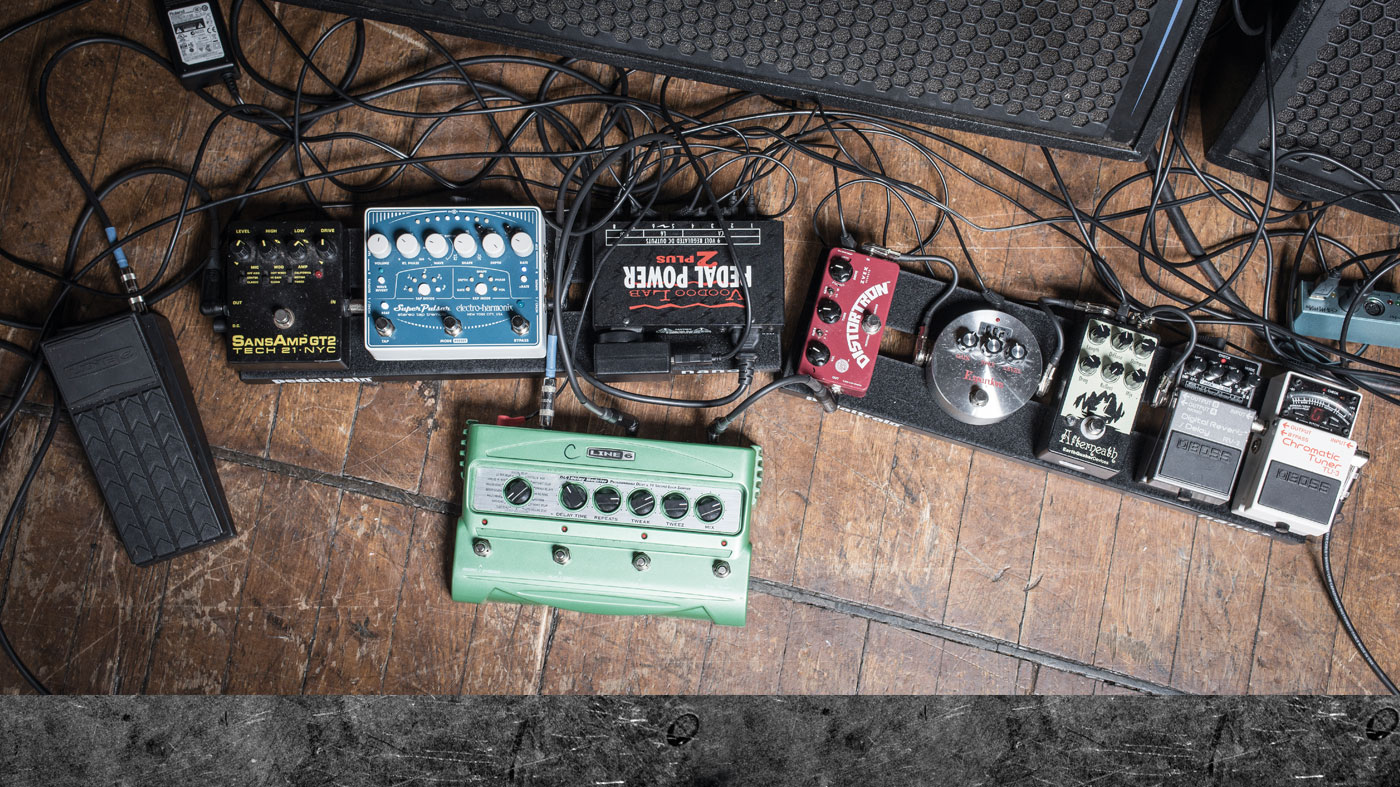
Mark Smith, Explosions In The Sky
Tech 21 SansAmp GT2
Mark: “This is the one I use for the real apexes of our songs. It can just boost a melody so it shoots through in a way that works really well - like when Munaf and Michael are playing really heavy chords on songs like The Only Moment We Were Alone or Greet Death, I play this pedal for the melodies.”
Electro-Harmonix Super Pulsar
Mark: “This is brand new. With this record, we didn’t play a lot of it live before recording, so we had to reverse engineer the sounds we got in the studio. I got this to replicate the tremolo sounds on Disintegration Anxiety and Colors In Space, which we made in the studio using a pedal I borrowed from [producer] John Congleton.”
Line 6 DL4
Mark: “This is the only pedal I’ve been using since our first record. It makes a brief appearance on that record, and then I’ve used it on pretty much every song since. Of course, this is probably the 15th one I’ve had to buy, because they tend to break too easily, in my opinion. I use the expression pedal three or four times in the set, generally to add longer decay times to delay settings to just use in certain sections of songs, and then switch back to shorter decay times.”
Z.Vex Distortron
Mark: “This is the one I use for the thick, viscous distortion sounds, like the volume-swell washes from Greet Death or the power chords of Have You Passed Through This Night? - it’s a really pleasingly heavy pedal.”
Bixonic Expandora
Mark: “I probably don’t need three distortion pedals! But I borrowed this from Congleton in the studio, and ended up loving it so much I bought one off eBay. It has a nice sharpness to it without being harsh, and you can just lightly distort the guitar so it growls a little without being piercing.”
EarthQuaker Afterneath
Mark: “This is another new addition. There have been times when I want the reverb to be even thicker and spacious and alien, and this pedal is my first try at it.”
Boss RV-3
Mark: “It’s been indispensable, and now that I think about it, this exact pedal has lasted me about 15 years without breaking. And we finally bought some backups - so I’m feeling good about that! There are other super nice reverb options these days, but back 15 years ago it seemed far and away the best way to get the most warmth and grandness from the guitar.”
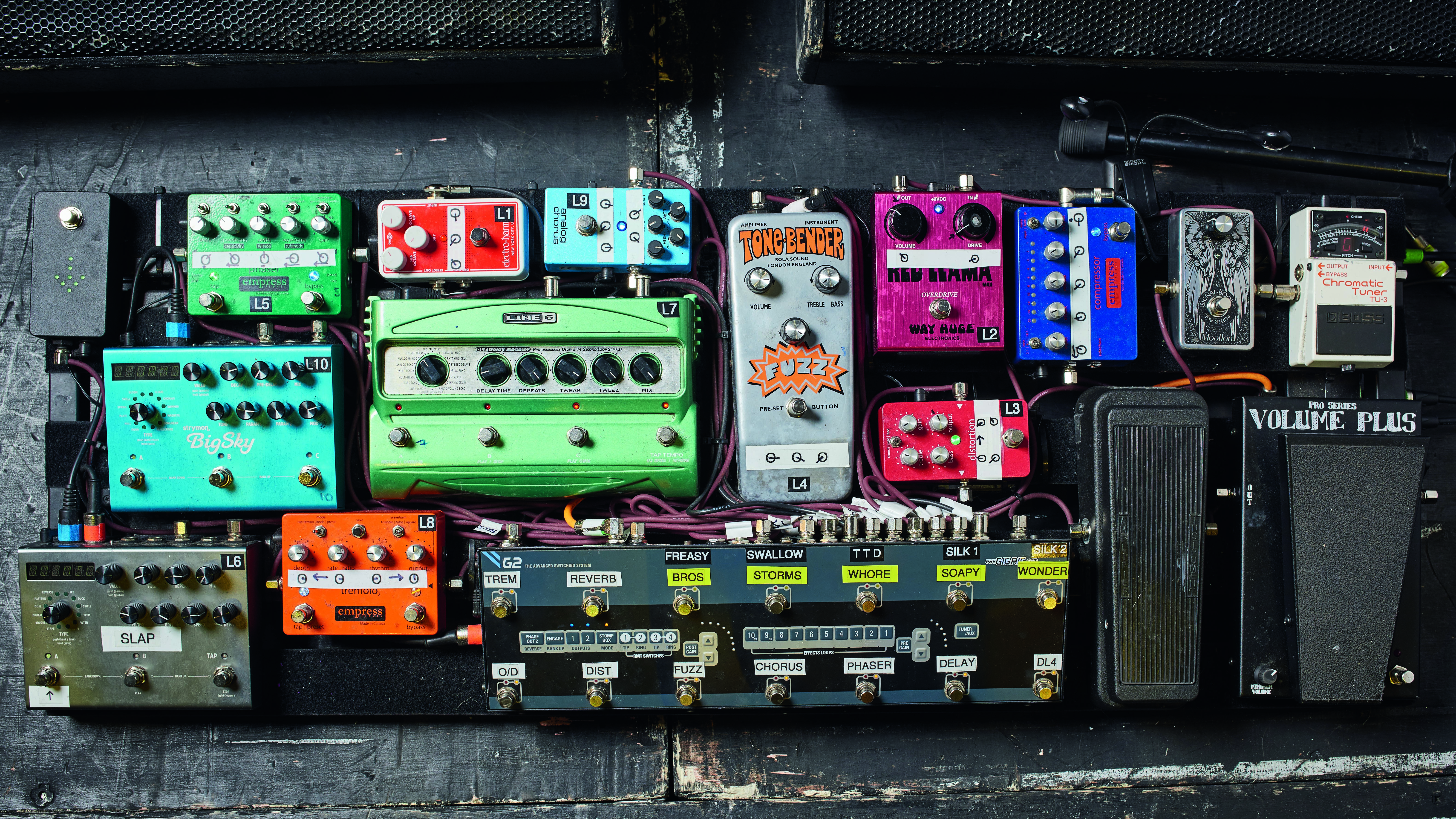
Joff Oddie, Wolf Alice
TheGigRig G2
“I got it about a year and a bit ago. I was looking for something that did MIDI changes and multiple things at once because there’s a couple of tracks on the record that go from one guitar sound to a completely alien guitar sound. It was getting to the point where I was spending too much time between songs pressing this button here and this one here. So I needed something that could do the leg work for me, that’s still going to give me the flexibility to improvise and flick switches. But is not a big rack with patches, which I think could be a little bit boring.”
Empress Tremolo2, Phaser and Compressor
”Empress just make the techy-ist pedals in the world. I’m a massive, massive fan and I can’t sing their praises enough. In terms of their tremolo you can get any trem sound you want out of that, no matter how extreme. And the phaser has ridiculous sounds. weep patterns that are really cool.”
Strymon Timeline
“The Timeline does more bog standard delay sounds. The main sounds I use it for are slaps. But things like Bros and Storms have the custom ones with different sounds on.”
Strymon Big Sky
“It’s a good live utility because it’s linked to MIDI and you can have lots and lots of different sounds. I might not use it in the studio per se because they’re fairly digital sounding. I like what the Strymons do and I need to have it for live but sometimes I feel some of the sounds a little bit digital, if you know what I mean.”
Electro Harmonix Nano POG
“I’d like to get the full-sized POG, or maybe a HOG, but it doesn’t fit on my ’board!”
Line 6 DL4
“Probably my favourite pedal on the board. I originally bought the TimeLine to replace the Line 6 and then realised that I couldn’t get a lot of these sounds. To be honest, if I could fill my board with Line 6 DL4s I would! The normal delay sounds are great. There’s only three presets though so this one does the weird stuff.”
MXR Analog Chorus
“That’s one of the first pedals that I bought. We’re big fans of them, they’re just really nice sounding chorus pedals.”
Sola Sound Tone Bender
“I went from Big Muffs but the Tone Bender is a bit more present that the Muff. It can be more abrasive and in your face, which is nice.”
Way Huge Red Llama
“I had the [Fulltone] OCD before and I found it sucked out a little bit too much bottom-end, and the Red Llama was recommended to me by Mike Crossey, our producer, because we were using Klons [Centaurs] in the studio and I said I couldn’t really find an overdrive that retains bottom end. He recommended that as a cheaper option because I didn’t have two grand to buy a Klon. I’d love to!
“I’ve ordered a Rock Your Repaired Amp Klone. It’s a Klon clone. I played one in a shop in Denmark a while ago and they’re amazing. The most transparent, beautiful things but unfortunately, they’re such high demand and it’s just him [Shane Logan] that’s making them. So there’s a waiting list. I put my order in a couple of months ago and it will potentially replace the old Red Llama.”
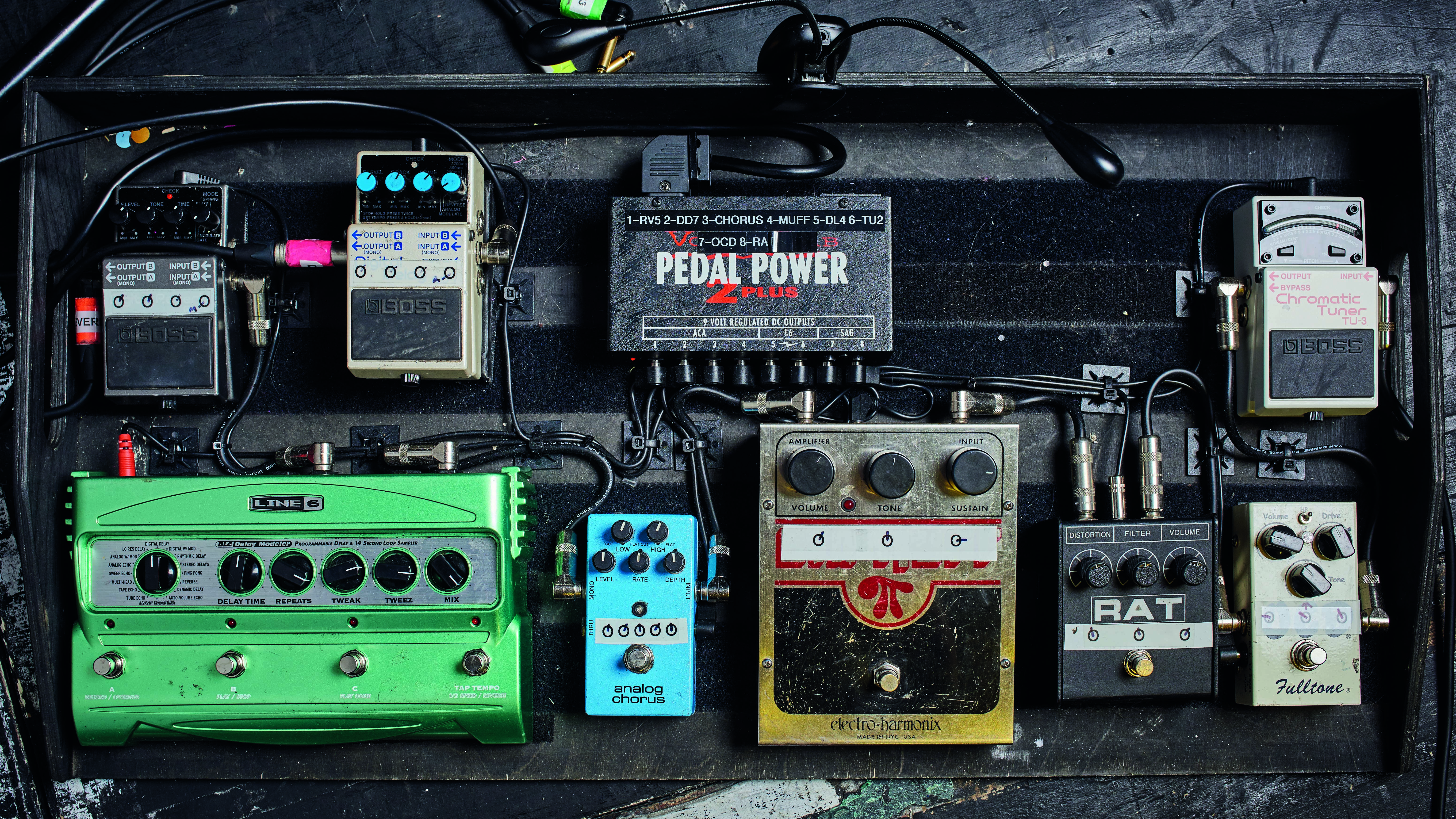
Ellie Rowsell, Wolf Alice
Boss RV-5 Reverb
”I normally use that with the reverb time and level all the way up and the tone all the way down because I like that sound. If we’ve used a synth in one of our tracks, instead of playing a synth that’s my go-to synth sound.”
Boss DD-7
”I use this for my vocals. I hook the harmonica mic up to it. That has a really cool sound on its own but the delay means I can control it more and mixed with the old school clipped sound the mic has, it gives different textures. It can sound a bit more instrumental rather than just a voice.”
Electro-Harmonix Big Muff
”I used to have a Little Big Muff, and that was the first and only pedal I had. My friend John [Victor] from Gengahr is a really incredible guitarist and he saw that I used one. It kind of dips a little, it’s great as an isolated effect, but when you’re playing with other people I find it dips and the tone is kind of gone. So John made me a pedal that makes sure that doesn’t happen.
”I have two at home, but I haven’t included them on my board yet because I’m deciding which of them I like more. He’s slightly obsessed with making the perfect fuzz, and I’m trying to find one. With the Big Muff, I compensate by putting the OCD on at the same time.”
Pro Co RAT
”I only use this for the nasty-sounding songs when I need it to cut through, on Fluffy and You’re A Germ when Joff has loads of fuzz on his tone and I need something more trebly and nasty.”
Fulltone OCD
”I do use it on its own, too. I use it to beef up my clean sound because it can be quite subtle, which is what I like about it.”
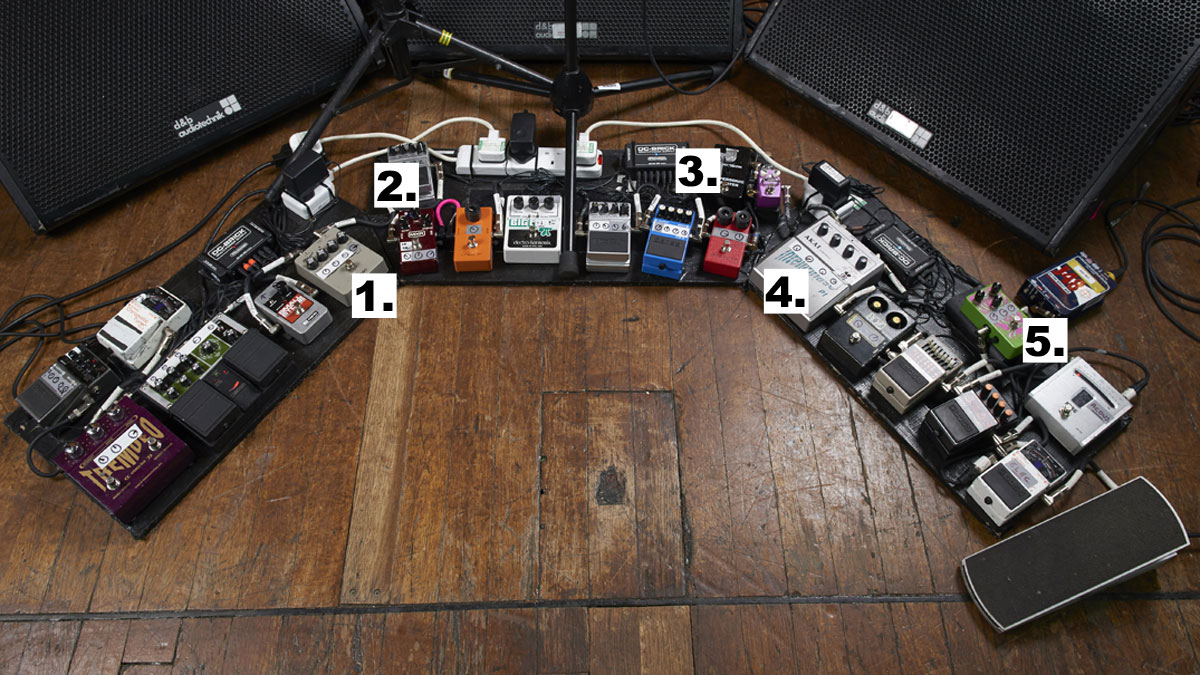
Richard Hawley
Richard’s live effects rig has a strong emphasis on vintage modulation and saturated drive.
Richard says he’s an experimentalist when it comes to pedals for recording, however:
“The cabin is stuffed with pedals. But I’ve got a very anarchic attitude to that. I remember talking to Richard Kirk from Cabaret Voltaire years ago and I asked him a similar question: ‘How did you get that sound?’ And he said, ‘Oh, I don’t know, I just plugged loads of pedals in’ - and I sort of like that very anarchic approach.”
By the numbers
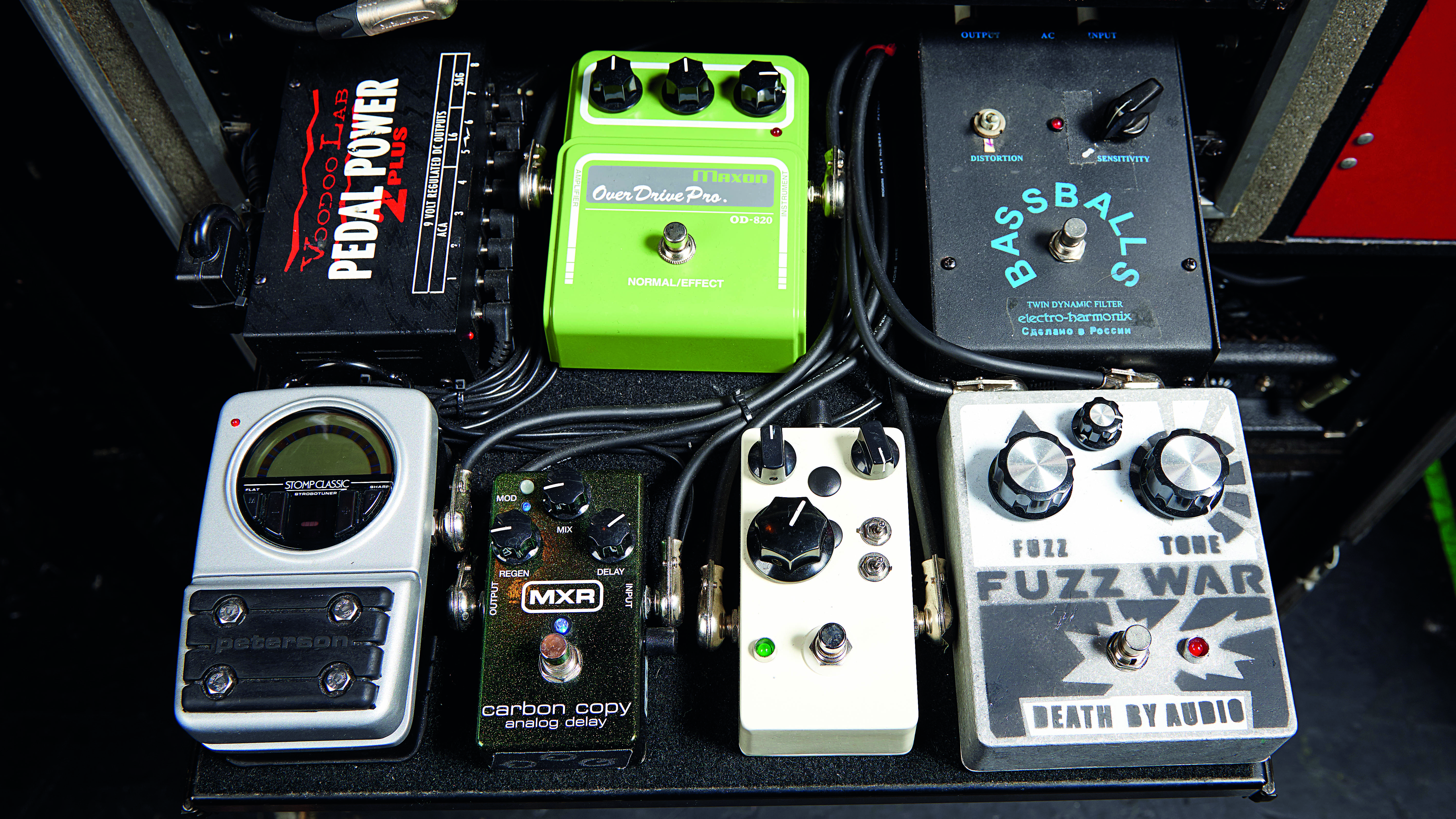
Mick Thomson, Slipknot
Maxon OD820
“I use it as a boost, just a little bit of boost. In the studio I use that pedal in front of an unmodded Marshall 800 from 1985/86 and I blended that in with my Rivera for tracking. I’d put that pedal in front of [the JCM800] and it really woke it up. It worked with that amp and it works well with these guys too.”
Electro-Harmonix Bass Balls envelope filter
“I only use this pedal for one song, and that’s Disasterpiece.“
Death By Audio Fuzz War
“That’s awesome, that is just the sickest fuzz tone. It’s basically fuzz and tone and fuck you; that’s where it’s at and it’s louder than shit. That will come in when I need some fatter shit, I’ll kick on at the end of a couple of songs.”
Kevin Allen Fuzz
“My guitar tech [Kevin Allen] made that; it’s his version of the octave fuzz I used for a long time. I use it at the beginning of Duality.”
Kevin: “It has a square wave filter on it so it sounds extra zippery and fucked up.”
Mick: “Fucked up was what we were going for.”
Kevin: “He wanted something more fucked up so… we fucked it up.”
Mick: “It’s so over the top we have to dial it back a little bit, but it’s a shit ton of fun and I can’t wait to be in the studio with it because I know it’s going to end up somewhere. It’s one of those things where it’s like, is that a guitar any more?!”
MXR Carbon Copy delay
“There’s a million analogue delays but this is a good-sounding one. It’s used minimally in terms of our current setlist. [Kevin] will pop it on or off for certain things just to fatten a couple of things up. Probably the single-note stuff in Devil In I and things like that.”
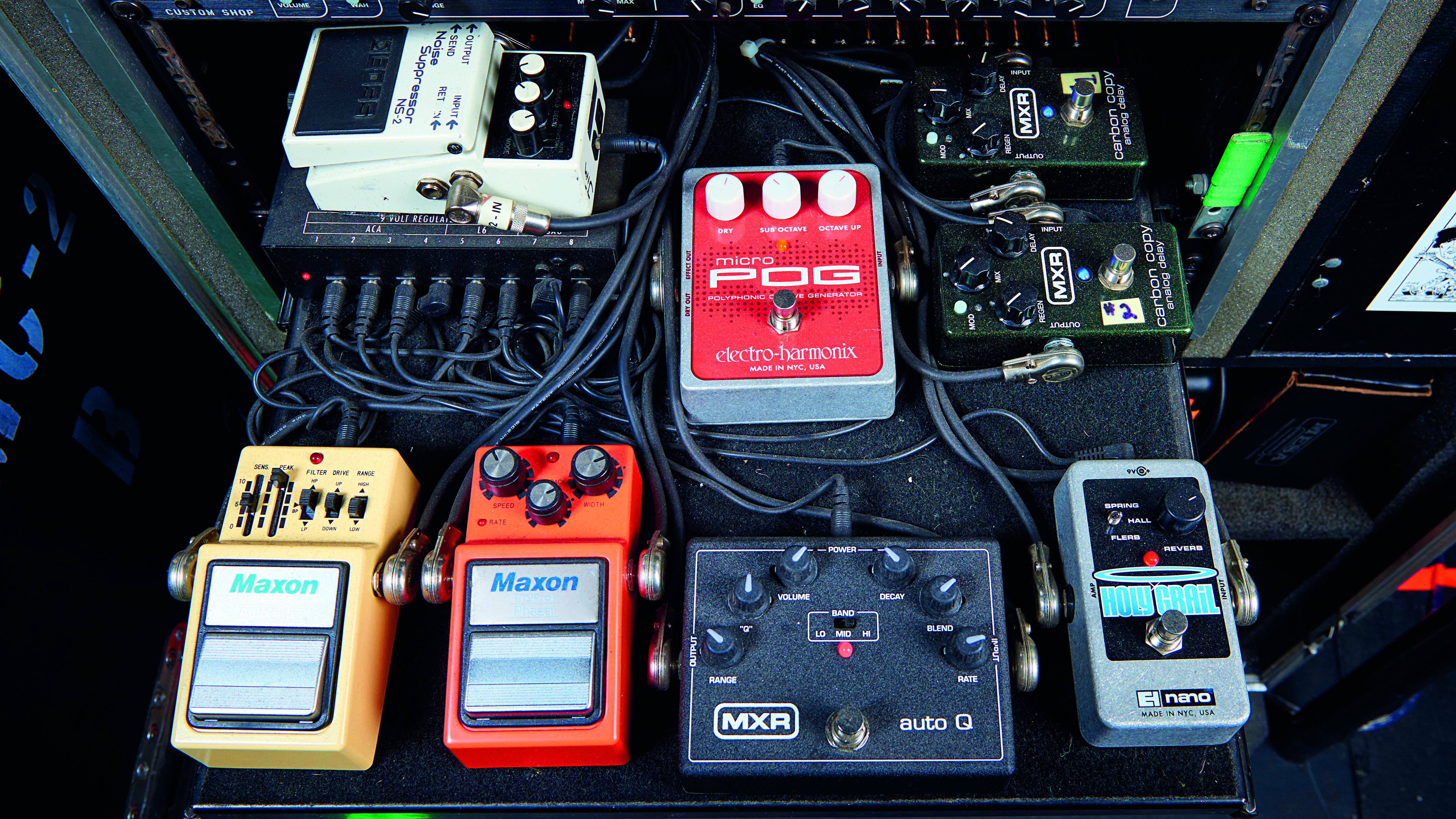
Jim Root, Slipknot
Boss NS-2 Noise Suppressor
“I like the old NS-2s: I’ve tried a bunch of other noise suppressors and I haven’t found one yet that I like as much. These are the pre-lead-free [solder] ones, and the newer ones I’m not quite as into.”
Dunlop DCR 2SR Rack Crybaby
“I use this a little more than the Jimi Hendrix one. Sometimes I’ll use the Hendrix wah for actual wah but the way I have the Custom Shop one [in the rack] setup, I can get crazier sweeps out of it.”
Electro-Harmonix Pog
“I’m not sure if I’m using it in this particular set, but the POG comes into Gently and Iowa.”
MXR Auto Q
“This is for clean wobbly sounds. I think I’m using this one on Sic and I’d use it on Gently as well. The way I have it set, it just gives you that almost Leslie cabinet kind of thing going on.”
MXR Carbon Copy delays
“I have one set up for the clean channel and one setup for the dirty channel. The one on the clean channel has a quicker slap on it. You can’t really hear it, it’s just adding a little bit of warmth. The one on the dirty channel is for really crazy solos and have a really long trail on the end of them.
“I had a couple of different delays but I just liked this one; it’s compact, it’s really cool if you want to mess around with the delay speed on it, to get it to recycle on itself. And it will do it every time and it’s not finicky, it’s very consistent.”
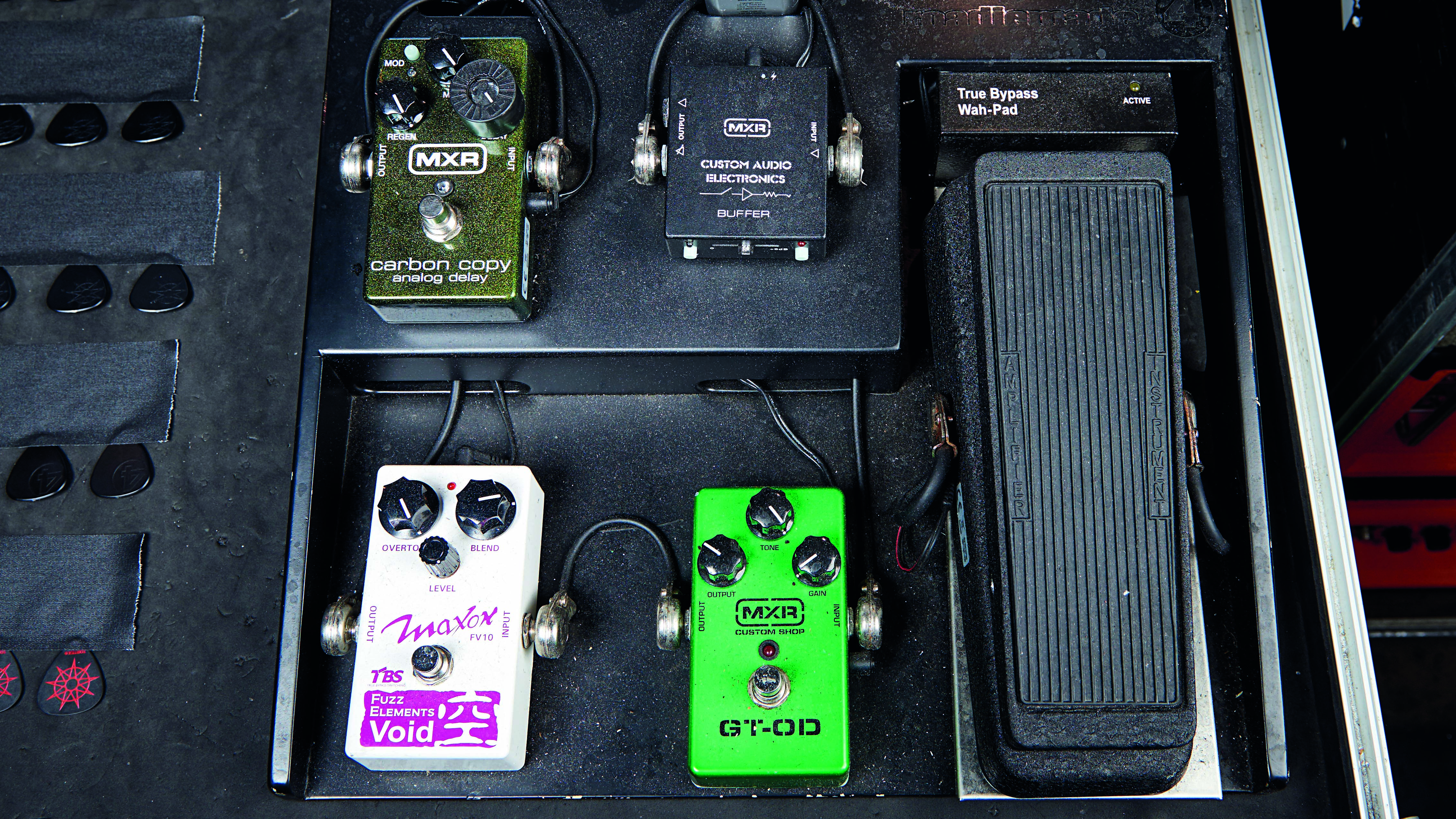
MXR Carbon Copy delay
“This one is out there on the pedalboard so I can play with the speed on it and get all the weird sounds.”
MXR GT-OD
“This is just in case I’m out there and I’m doing a solo and just don’t feel like I have enough sustain on something, I’ll turn that on real quick. I don’t really use it that often though.”
Maxon Fuzz Elements Void
“I’ve got a few different fuzz pedals that I own, and I use them in Eyeless in the middle section [Jim hums the doomy riff] and songs like Iowa, and also, if I remember correctly, certain sections of The Negative One, too. If Mick drops out and does something high on the strings, I’ll click that on to widen the band and give it something dirtier to go with the bass and kind of fill up the sound.”
Dunlop JH-1D Jimi Hendrix Signature Wah
“I tend to use it in fixed positions and then I’ve got the hotplate switch, so I’ll just put my toe or the side of my shoe on that to activate it. If I’m doing a solo and I want some wah, I’ll use this one.”
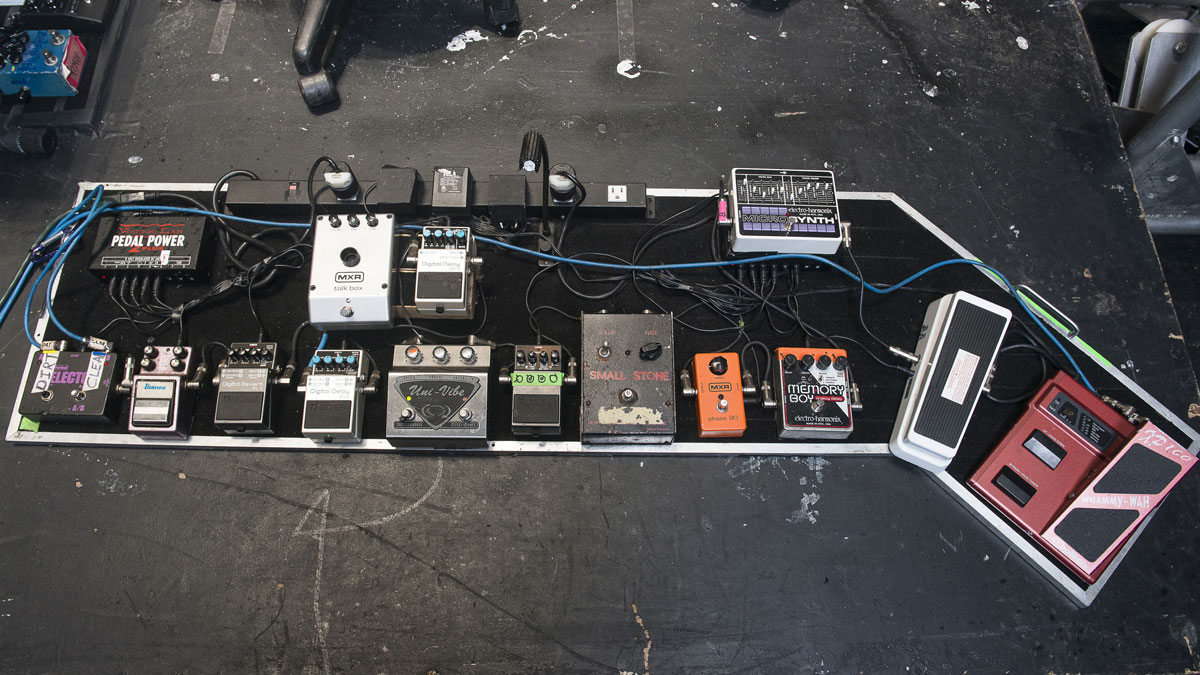
Munky, Korn
Jim Dunlop Cry Baby 105Q Bass Wah
“So this wah [pictured in white on the board above] is actually made for bass! [Laughs] But at least for me, it feels like you can get a better sweep on everything… because we use low tunings. So for our needs, it seems to work perfectly, and I also think it adds a little fuzz, too, near the top end.
“A lot of the stuff, I just like to have it out, because I’m oldschool. I want to adjust things and have some fun. When you’re playing night after night, you have to keep things interesting and mix it up. Do your own renditions, you know?
“If you play the right notes, it doesn’t really matter what effect or setting you’re on. It might even be some ear candy for the audience like, ‘Woah, that’s different!’”
Electro-Harmonix Micro Synth
“The Micro Synth is pretty much my favourite pedal. If you listen to the last three Korn albums, you’ll hear it all over. I find they’re a great way to layer sound and add in this tractor sound, I’ve got a setting that sounds like a monster truck.
“I’ll tag it into the start and end of songs here and here, like the beginning of Here To Stay, so it has to be in my live rig! It’s a bit like a Trent Reznor, bitmangled sort of sound, with an octave that I add in for different parameters… it depends where I am on the neck.”
MXR Phase 90
“It just has that classic phaser sound. I’m not really that technical with it, I just find sounds and mark them.
“It’s no secret I’m not the greatest guitar player in the world, that’s okay! But when it comes to Korn songs, I am the greatest guitar player at that. Anything else, I’m crap at.
“For me, using all these pedals together in unison really changed things for us. This and the DigiTech [XP100] Whammy have been a staple in our setup since Follow The Leader.”
MXR Talkbox
“I use the Talkbox at the beginning of Dead Bodies Everywhere.
“This one had more gain compared to the others I had tried, it helped me get this feedback drone like a didgeridoo: this circular sound that would just go on and on. And I could just leave it going, which is pretty cool! It’s become a really important part of the songs it’s appeared on.”
Ibanez BC9 Bi-Mode Chorus
“This pedal has been on my pedalboard ever since the first Korn album. It’s this really fucked-up sounding chorus. You can hear it on the intro to Blind, it’s not supposed to be pretty sounding, it’s really wobbly and distorts, too… which is just wrong!
“I think there was a similar-looking Tube Screamer model that came out around the same time [the much-loved TS9 model - Ed]. I also use a UniVibe for a more rotary sound, it’s tough to find a better one but I’m not gonna be stupid and try to bring a Leslie out on the road!”

Head, Korn
Dunlop UV-1
“They don’t make these Uni-Vibes [centre-right on board above] anymore, but I always thought they sounded great. I combine it with the reverb a lot, especially on tracks like Falling Away From Me and Here To Stay.
“That’s about as crazy as it gets for me - simplicity is key, each to their own right?! Some people just like the craziness, I guess. You’d be surprised how many songs are just the dirty channel for me, especially with the early stuff.”
Boss RV-5
“I don’t use any delay at all, but I’m a reverb fiend. The Boss RV-5 is a pedal I’ve stuck with since the beginning; it has this nice and clean reverb. But you know what I’ve found to be better? I only tried it out recently, but the Strymon BigSky totally rules!
“I tend to stick with about five pedals, it’s a pretty generic setup, but there’s less that can go wrong. I had a buzz going on the other day, and it didn’t take long to fix, but if it was coming from Munky’s rig it probably would have taken much longer!”
DigiTech XP-100
“I’m not actually using this for any of the first album set because we didn’t have them back then - they came a few records later.
“So I’m using it during on songs like Here To Stay, where I kick in this lower octave to add more beef. And for some of my Freak On A Leash parts, I dial in one octave up.”
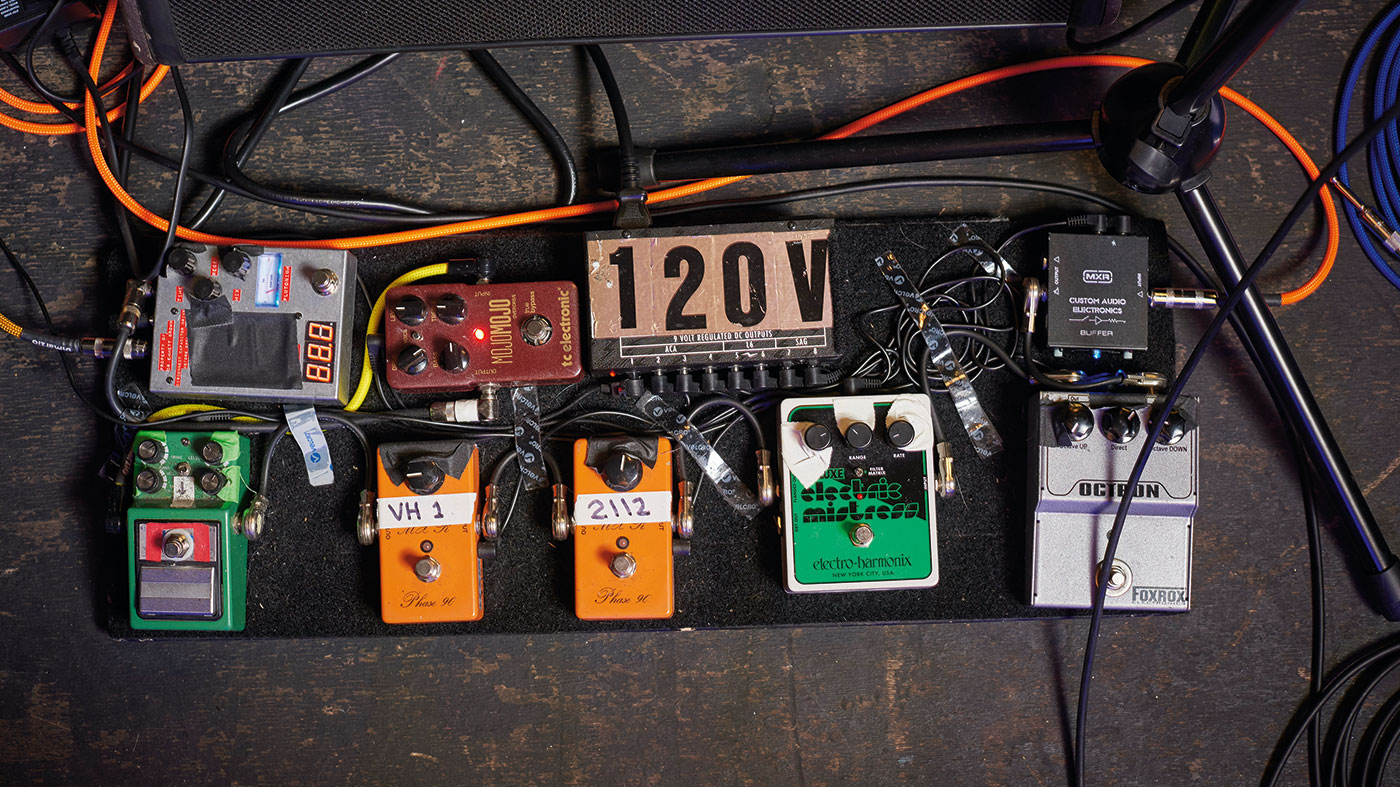
Paul Gilbert
“I have a TC Electronic MojoMojo overdrive and a Ibanez Tube Screamer so I can step up the amount of distortion in stages. I’ve also got two MXR Phase 90s - one of them is set to slow and one is set to fast. I use a delay, an EHX Electric Mistress flanger, an MXR [MC406] Buffer (to improve the signal on long cable runs) and an Octron octave pedal by a Foxrox.”
Paul Gilbert: "Fast playing is the musical equivalent of filling space"

Brad Paisley
From Shure wireless units, the pedals are then controlled via a combination of a Voodoo Labs Ground Control matrix and the RJM Effect Gizmo that also deals with amp switching and routing.
All effects go to all amps and guitar tech Dave Rouze controls the vast majority of Brad’s pedal switching. And the pedals themselves…
Dumbloid: “It doesn’t sound anything like a Dumble,” says Dave, “but it is a really great-sounding pedal, not super distorted, and he uses that for some lead sounds. He really likes it”
Wampler Plexi Drive: “This is a very specific sound that just gets used once”
Hermida Audio Zen Drive: “Basically a backup, we used to use it a lot but it’s basically been replaced by the Wampler Plexi Drive”
Wampler Paisley Drive: “This is Brad’s proto Paisley Drive and we use that quite a bit - maybe on a half-dozen songs. It’s one of his main overdrives, too”
CMAT Signa Comp: “This is used for certain clean sounds and never with drive”
Ibanez TS9 Tube Screamer: “He uses this all the time, it’s his go-to pedal. We use 808s and TS9s pretty much interchangeably, so I hope that ends some kind of fight out there on the internet! [laughs]”
Way Huge Green Rhino: “We use that specifically on the opening of Water. He does this Jaws lick. He used to do a Van Halen cover, Hot For Teacher, and he used it on that. We have this set really heavy and he only ever uses it dry”
Wampler Underdog: “Brian Wampler built it just for Brad and I believe there’s a version of it coming out with a combination of this and the Paisley Drive in one pedal”
Boss NS-2 Noise Suppressor: “This runs mostly on the wah-wah because it’s so noisy, but I don’t really gate anything else. The ’52 squeals a bit so it helps with that, too”
Boss DD-2: “These are becoming hard to find, and that’s Brad’s main sound as the slapback - on the 200ms setting, just a short slapback with two or three repeats. That’s what you hear on his clean sound pretty much all the time. That’s the secret to it!”
Way Huge Aqua Puss: “It’s a sound that Brad likes, really crunchy and analogue-y. For that specific sound, it’s the go-to”
Roland RE-20 Space Echo: “I use these for when we need to tap the delay in for the longer delay times”
Wampler Wheelhouse: “Brian built that for Brad - it’s got the tape warble on it but also tap-tempo, which is crucial,” says tech Dave Rouze
Line 6 M13: “This is for all the other stuff: a chorus in Riverbank; Old Alabama has a phaser and so on…”
Brad Paisley talks writing with Fogerty and Jagger, and reveals his live guitar rig
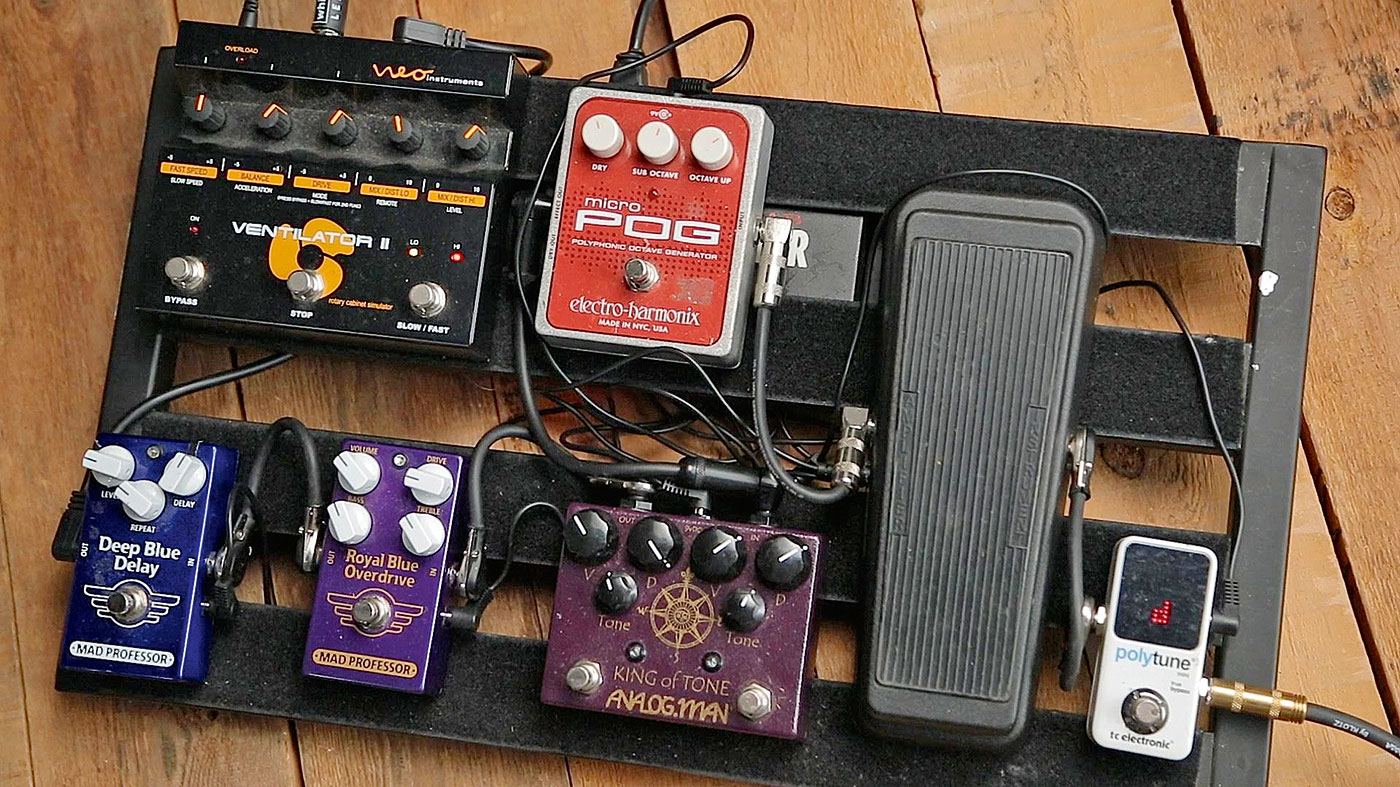
Laurence Jones
“I always use the Analog Man King of Tone and the Mad Professor Royal Blue Overdrive, so I have three stages of drive as it were - because the KoT is, basically, a two-in-one overdrive.
“I first heard the KoT when I was touring with Kenny Wayne Shepherd - he was using one and it sounded fantastic. As he put it, ‘When they called it the King of Tone, they weren’t lying!’
“But, yeah, I always leave my Royal Blue on, set up to be just a tiny bit louder than the amp on its own, just to drive the valves a little bit and round off the tone as Fenders can be quite harsh. And if I need a little more boost, just to edge it a bit, I put on the KoT. And if I want to go more crazy, with more sustain, I hit the other side of it.”
Laurence Jones and Mike Vernon on why Take Me High is "the future of blues"
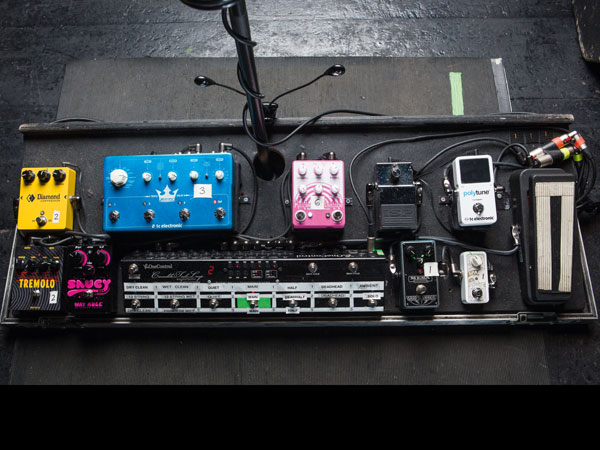
Devin Townsend, Devin Townsend Project
"I enjoy experimenting with gear and I like pedals; I really enjoy the tactile sensations of changing my own patches and tweaking things when I’m playing live.
"With the Casualties stuff, or with my home rig, it’s a very different pedalboard: different guitars, amps, everything. But with DTP, this is what I'm using now."
One Control Crocodile Tail Loop Switcher
"This One Control acts as a true bypass loop, which, depending on the patch, sends a MIDI signal to both the Kemper and the Axe-Fx- it goes to the Kemper and then to the Axe-Fx.
"Each one of these patches corresponds [to a sound], for example; one is a Rectifier profile with my main GP sound, another is a Fender profile with my clean Axe-Fx sound. And with the buttons on top, every time I change it, the light corresponds to one of these loops.
"The numbers on these pedals signify a different loop. So if I want the Rainbow Machine to be on my Dead Head patch, I just hit six and then that engages that loop. It’s as simple as that with this thing."
One Control Crocodile Tail Loop Switcher
"The main chain I run for my heavy channel. I’ve got these drive pedals ahead of the amplifier. I’ve got a Mesa profile on the Kemper, too, but these are for a clean boost. I went through a ton of different overdrives and I’m still experimenting with them.
"I had a Maxon OD808, and I’ve used the Keeley [Red Dirt]... Seymour Duncan has a new one that is cool. But for this tour, I chose the Grid Slammer because it’s a bump in the mid that is really aggressive-sounding and adds a bit more mid to the Kemper. And if I want to add that to my clean channel as well, I can add a bit of distortion."
TC Electronic Spark Mini Booster
"If I want to play a lead, I throw this in, which is basically just a clean boost."
Diamond Compressor
"The clean-sound loop starts with the compressor. I tried a bunch of different compressors.
"I really like this one, and I also like the new Seymour Duncan one that just came out: the Vise Grip. They’re a parallel compression so you can bring in your clean tone."
Way Huge Saucy Box
"Then is goes into the Saucy Box, which is essentially a Klon overdrive sound. Again, it’s a parallel addition to the sound."
Voodoo Lab Tremolo
"For this tour, I’m using the Voodoo Lab. Someone broke into my truck at home and stole my Malekko one, so this was what was kicking around. And it’s good - it acts like a tremolo!"
Earthquaker Devices Rainbow Machine
"I was looking for something that when you turned it on, you didn’t know what it would do. Kind of like my wife. This just goes crazy. It’s got a magic button and when I press it, it does weird shit. And I like having it at the end of the chain.
"I’ve got the TC delay prior to it as well, so basically, they feed into each other. You kick this Rainbow Machine on and it does random things. There’s something to be said about it that I really dig, for that element of surprise."
TC Electronic Flashback Triple Delay
"I've got this in front of the amp and it adds three different styles. With this triple delay, you can stack them as well. This is more just a big washy delay."
ISP Decimator
"I remember we toured with a band years ago when I was with Strapping [Young Lad] and when this pedal first came out, we made fun of the guy relentlessly for having a Decimator.
"We thought it was the stupidest name for a pedal ever. And we had this whole back story about his Decimator where it was in its own rack - don’t fuck with the Decimator, man, because if you hit it wrong or you turn it up past a certain threshold, it will create a vortex that will suck us all in.
"So we made fun of him, then after a while I realised it was the best noise gate ever! So now I have a Decimator. But don’t fuck with it, because I will and have been known to turn it up past its threshold."
TC Electronic PolyTune
"Great tuner from TC Electronic. If you hit all the strings it tells you which ones are out of tune.
"Which is great if you aren’t in an open tuning like me, so we use it as a standard tuner because that special function does fuck all for me. But it’s really cool."
Dunlop Cry Baby 95Q
"I used to use a [Morley VA-1] Bad Horsie wah, the Vai one, but I didn’t really like the sweep on it. It’s a real specific sound - less of a wah and more of his sound.
"As much as I ended up using that thing, I really liked the Judas Priest sort of wah sound. This Dunlop is an auto engage as well, and it has a variable Q and volume boost on it."
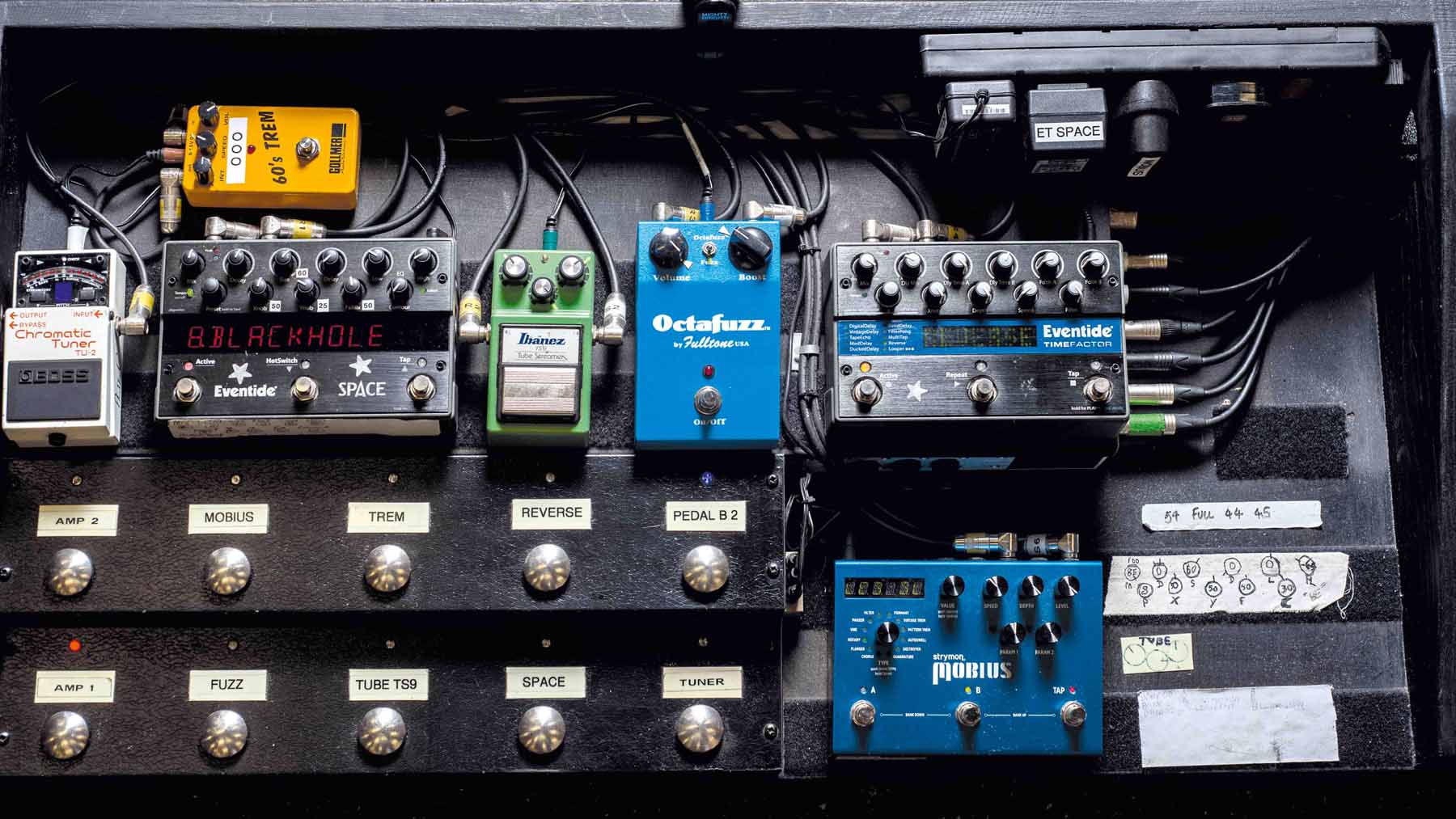
Andy Bell, Ride
Eventide Space
“Eventide came out with the Space and TimeFactor pedals a year or two ago. These pedals are based on the H3000, so it’s been perfect for the Ride reunion. I remember we were doing the second Beady Eye album and I saw the Space for the first time and was just like, ‘Oh my god – the day has come!’”
Eventide TimeFactor
“The TimeFactor is very versatile, but I only use it for one thing, which is the backwards sound. That’s used on quite a lot of the lead stuff like Seagull. I use the Space on the Blackhole setting for the big reverbs on Dreams Burn Down: the twinkly lead in the verses.”
Strymon Mobius
“I have quite a bit of Strymon gear as well, because the delays are really good. This is the only pedal I’ve ever seen that’s got a bpm-controlled tremolo. I’ve got that on a Leslie setting – a fast Leslie sound for Time of Her Time and a slow sound on Taste.
“Mark got every pedal Strymon does, but we try not to copy each other. If I’ve got an Eventide reverb, he’ll then go Strymon on the reverb and vice versa. We’re both trying to kind of fill in all the gaps.”

Ibanez 9 series Compressor
“The most essential pedal that I have. It’s an 80s pedal and it’s always on. It just smoothes out and lifts and brightens up the whole sound.”
Fulltone Octafuzz and Univox Super-Fuzz
“I have two different fuzz units: I have the Octafuzz on the fuzz setting, not the octave; and a Super-Fuzz. They work for different songs on different parts.”
Origin Effects Cali76
“The other compressor in the chain. Origin is quite a new company – it’s Oxfordshire-based and is coming out with really, really good pedals. That does a really good job and it’s like having a studio rack in a pedal. I use it as just a huge volume boost.”
Jim Dunlop Buddy Guy Cry Baby Wah
“I use it as a volume step. I had a standard Cry Baby for ages but then, after seeing the Roses, I ended up getting the Buddy Guy signature one with the polka dots, which John Squire plays. It has some extra circuitry and a little bit of a drive in it as well.”
Andy Bell talks returning to Ride and his Rickenbacker'd rig
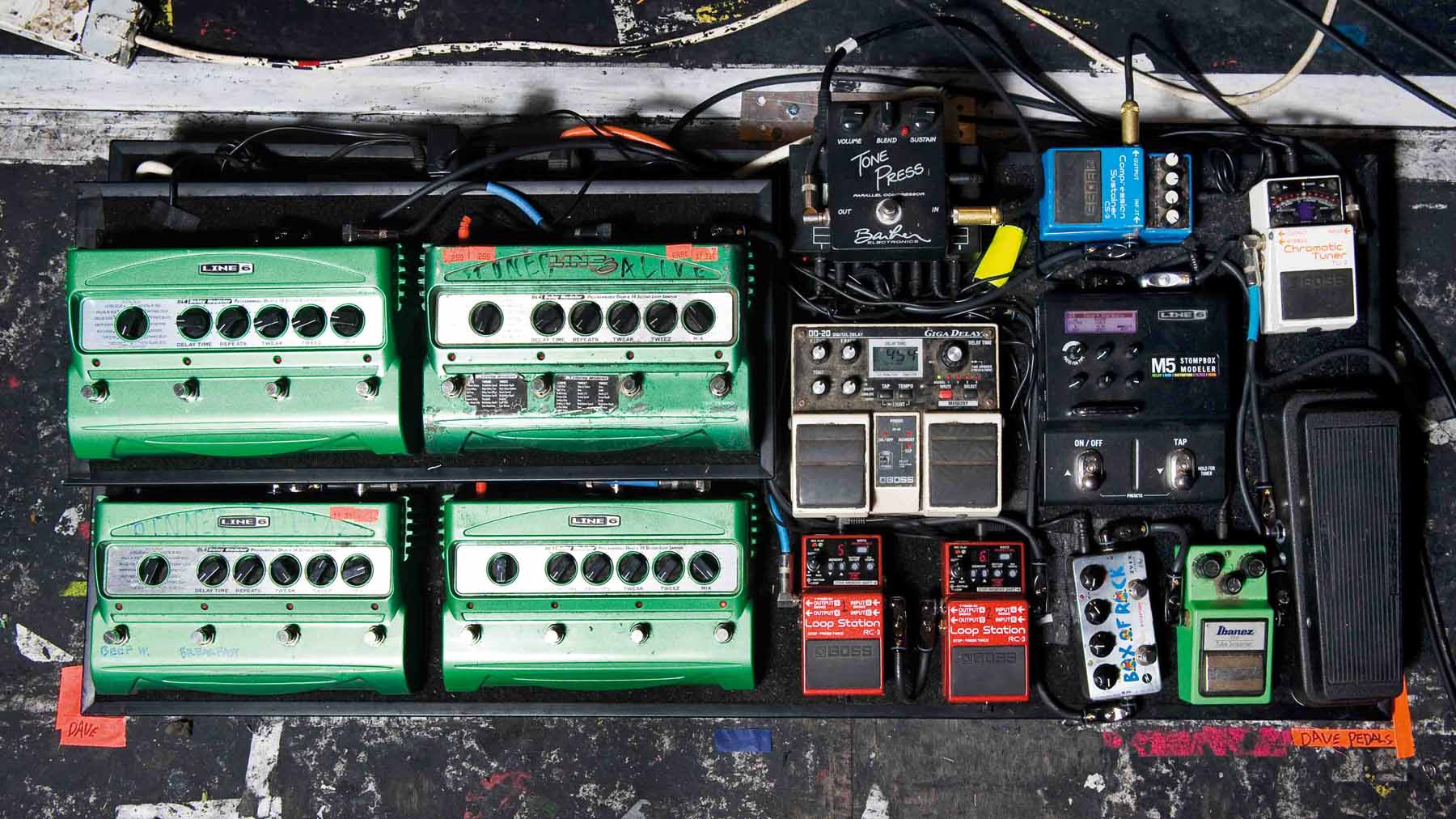
Dave Knudson, Minus The Bear
“Actually, [on] the first couple of records, They Make Beer Commercials Like This and Highly Refined Pirates, the ’boards were much smaller, because there wasn’t as much use of sampling and all that stuff.
“Then [Menos El] Oso came around, and it became kind of a necessity, with all the sampling and stuff, to get more [Line 6] DL4s on there to make the live sound like the record.”
Line 6 DL4 bank
“If the song allows you to, I prefer to record the loops while the song is playing. Most of the loops I record are either at normal speed or double-time, so most of the time [I record them in] half-speed so that when I take the [loop] speed up it goes into double-time or whatever.
“The DL4s work especially well for re-triggering the beginning of the sample – y’know, the really jittery, stuttery, one-shot stuff. That feature has made the DL4 a staple of my rig. Because of the way the songs are written, that stuff is kind of a necessity now.”
Z.Vex Box Of Rock
“I mainly use the boost section of the pedal. I just love the way it brings out some of the chimey-ness and the upper-harmonic tonalities, especially in combination with a nice tube amp, like a [Fender] Twin, which I obviously use on a lot of stuff. It just makes any amp sound better, and adds a whole bunch of extra character.
“Plus, when you have a pedalboard chain as long as mine is, I’m sure there’s some audio deterioration along the way, so it’s good to sometimes sparkle up the sound if it gets a little dull.”
Boss RC-3 Loop Stations
“Some of the samples I can get away with having stored ahead of time – like the sample of Into The Mirror – that’s one of the ones I play off there, or the crazy sample at the end of Ice Monster that’s really intense – stuff that would take me a while to recreate live. For those kinds of things, I think that works great.”
Barber Tone Press
“The Tone Press just levels everything out, especially with the tapping stuff – it can kinda get lost in the mix, especially the low strings, so you just hear the high notes coming through, tapping-wise. It levels all that stuff out, so on songs like Pachuca Sunrise or Absinthe Party At The Fly Honey Warehouse, where there are a lot of high and low notes competing, this kind of flattens everything and brings it to a nice level.”
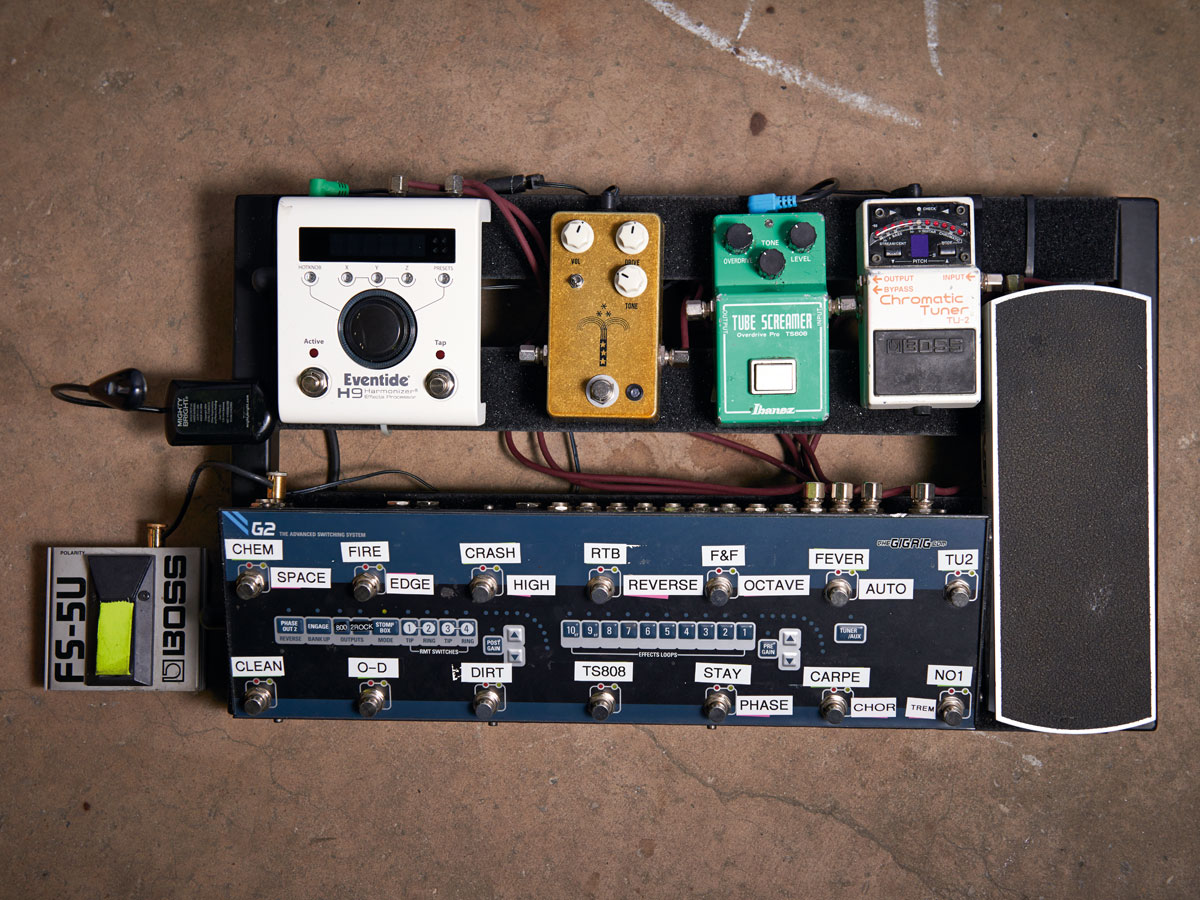
Chris Miller, You Me At Six
TheGigRig G2 Switching System
"The heart of the 'board is a G2switcher by TheGigRig, which is a fantastic British company.
"It's just mind-blowing what you can do with it: you've got 30 different patches, different ways you can loop your pedals, you can swap your amp channels, set the phase between two cabs. Basically, everything."
JHS Morning Glory/Ibanez TS808 Tube Screamer
"I run two amps live, so I've got an overdrive for each one. On my clean amp, I run a JHS Morning Glory, which is like a Tube Screamer TS808 clone.
"The Morning Glory's got a lot of gain - but when you find the sweet spot, it's just a perfect break-up. And then I use an actual old Tube Screamer on my dirty amp. It's the drive pedal I've used forever."
Eventide H9
"I used to use a lot of delays and modulation, but I've whittled it down to the Eventide H9, which is a multi-effects pedal with all the patches from the Factor series and that covers all my delays, reverbs, phaser, trem, octaves and everything.
"The only flaw with it is that you can't stack more than one thing at the same time, so I hope you sort that out Eventide, because that would be sick!"
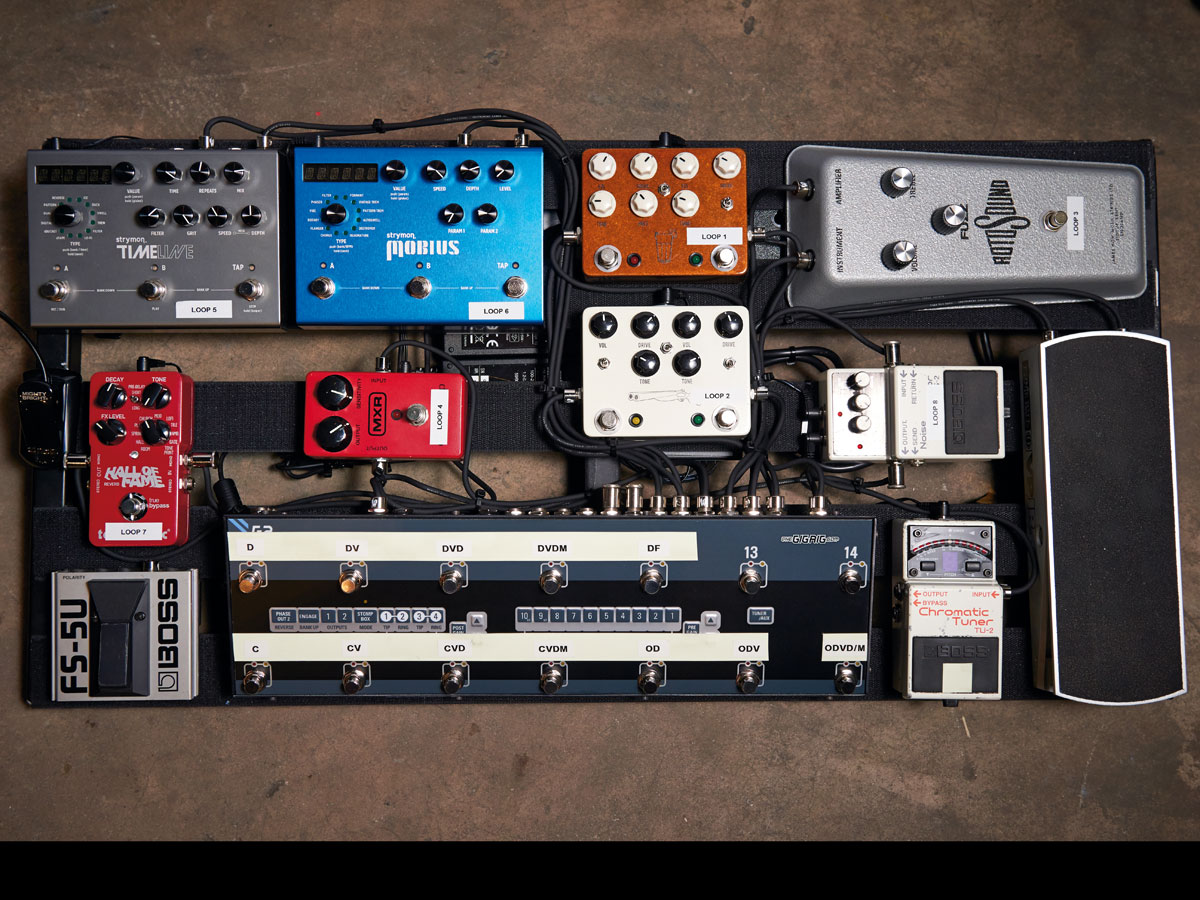
Max Helyer, You Me At Six
TheGigRig G2 Switching System
"Since we last spoke, my pedalboard's totally changed and, like Chris, my main hub is the G2.
"Just seeing how efficient it's been for Chris really was a selling point to me. I was there tap-dancing eight different changes, while Chris would just be laughing and having maximum time for beer drinking!"
Strymon Mobius & Timeline
"I made the move from Boss to Strymon because a lot of my friends who play guitar raved about how well that stuff works.
"The options you can get with the delay on the TimeLine are ridiculous. Then the Mobius, for me, I feel the selling point was that I could have chorus, phaser, flanger, rotary, vibe, tremolo - all of these settings in one box."
JHS Double Barrel & Sweet Tea
"I find my overdrive sound with the JHS Double Barrel, which is similar to Chris's Morning Glory pedal, but with an added boost on the other side.
"I have both of the settings on and I run it really hot, so it breaks up really well. Then my distortion sound is another JHS pedal, the Sweet Tea."
Rotosound Fuzz
"I have a Rotosound Fuzz reissue, based on the ones that Jimmy Page used back in the day.
"They copied everything they did on the 60s version into the new one and made 2,000 of them. I put it on top of my JHS Sweet Tea, so it adds this fizz and fuzzy tone underneath, or if I want to make something sound fat."
Other pedals
"I've been getting involved with the TC Electronic Hall Of Fame reverb in a lot of our songs just to make it sound big and roomy and vast.
"Then I use a Boss Noise Suppressor, because all of these pedals make a lot of noise. There's also an Ernie Ball volume pedal on my pedalboard, which is just reliable and great. Then the classic TU-2 tuner: good old trusty TU-2!"

Mike Einziger, Incubus
Boss PH-2 Super Phasers & MXR EVH90 Phase 90
“The two Super Phasers are set differently: one is set at a higher speed, almost like a rotary effect; and the other is set to a very wide, sweeping, almost flange-like sound. I use these in pretty much every song. The MXR was put in there by one of my old guitar techs, Larry Melero, who was a crazy Van Halen fan. I use it all the time.”
Boss RV-3 Digital Reverb/Delay & Electro-Harmonix Holy Grail reverb
“During Megalomaniac, I use this Boss reverb and also the Holy Grail reverb sometimes. I use both of them together if I want a real brittle, dark-sounding reverb, like on Pendulous Threads. They carry a lot of the higher frequencies through and they become kind of harsh-sounding, making it very dark, which I really like.”
Electro-Harmonix Micro POG & Boss OC-2 Octave
“This POG is great. It gives you an octave above as well as the sub octave. When you play a chord through it, it doesn’t get the notes jumbled. It will actually harmonise the whole chord, which is really cool.
“I’ve been using it a lot during Sick Sad Little World, like when I play a solo in the middle of that song. I also use it during In The Company Of Wolves and that’s another place I use the Octave a lot. I use [the Octave] during the verse sections of Privilege.”
Boss CS-3 Compression Sustainer
“I use this a lot when I’m playing solos, like on the song Pistola. I'll click on this and it makes things go to 11, basically. When 10’s not quite enough, that’s what I use. I don’t have 11 on my amps, so this is the 11 pedal!”
Dunlop Cry Baby
“This is one of the first pedals I ever started using. A lot of times, I actually use it set at a midway point so you get this really throaty sound: I do it during the bridge section of Megalomaniac, in Adolescents, during the bridge section of Are You In? and during the guitar solo in Here In My Room with a slow phaser and a delay as well.”
Danelectro Reel Echo
“This is probably my favourite pedal. It is awesome. You know all this dubstep-type stuff that people are trying to do? This is like dubstep in a little box! It basically effects the delay rate without effecting the pitch, and I haven’t ever found another delay that does that. I use it during the Pistola solo. There’s some weird stuff happening on there – and it's all this pedal.”
Electro-Harmonix Deluxe Memory Man
“You can get some really wild things to happen with this pedal just by messing around and changing the feedback and the delay. It can get really out of control, actually, and blow your amp up if you aren’t careful!
“A lot of the time, I’m just really experimenting with this and the [Reel Echo], specifically running them through the wah. It ends up sounding like an analogue synth filter section. The guys in my band tease me a lot of times because sometimes I end up losing control of the thing. I call it ‘spilling the paint’!”
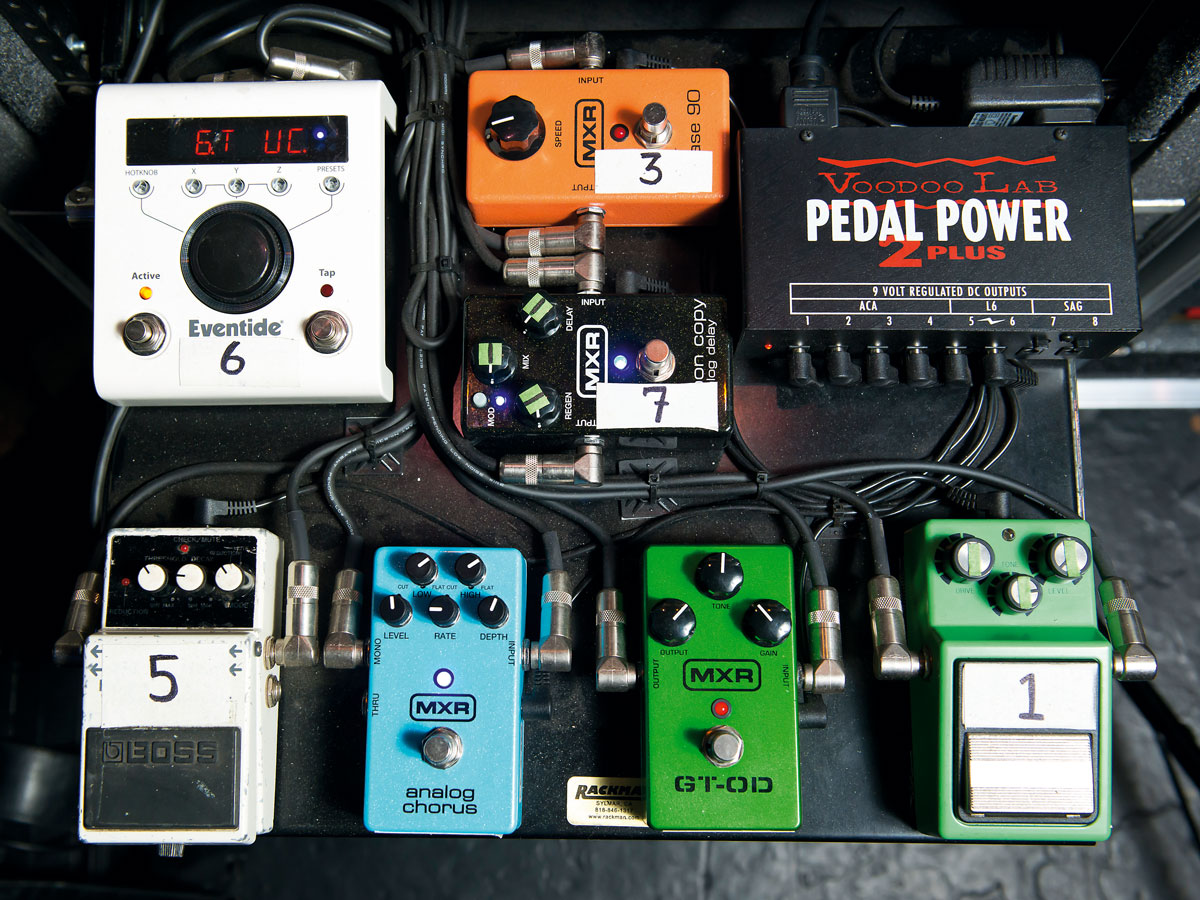
Zach Blair, Rise Against
“I’m using an Ibanez Tube Screamer, an MXR GT-OD and Analog Chorus and also the MXR Carbon Copy Delay.
"I was using some Boss pedals, but then the MXR people were good enough to bring out their own versions of a good chorus and a good overdrive for me and they’ve been great. We’ve also been using these Eventide H9 pedals. We’ve barely skimmed the surface on these things so far. They can pretty much do everything that all of our other pedals can do, but we just got them and we’re still exploring.”
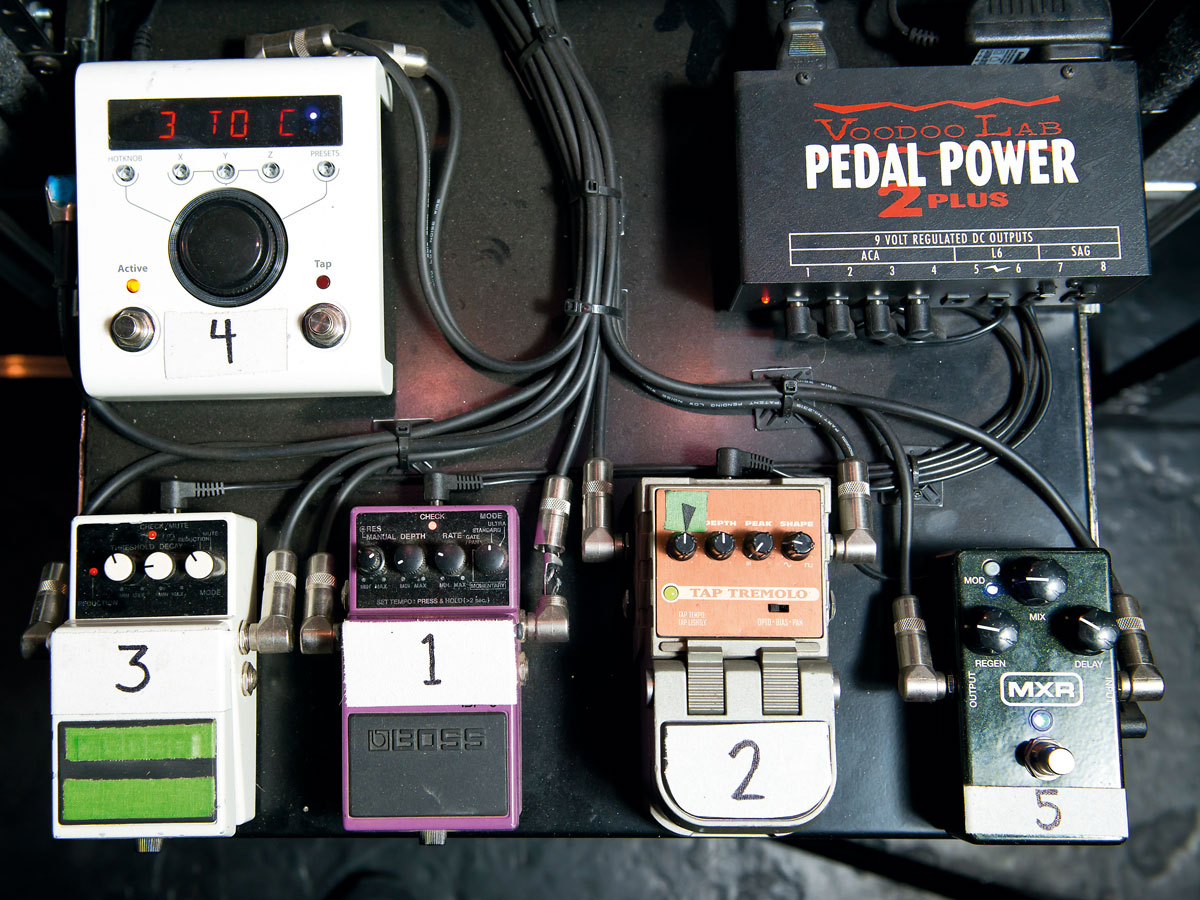
Tim McIlrath, Rise Against
“Essentially, it’s stuff that we came across during the recording of the songs. When we’re writing songs, we don’t mess with pedals, we just plug guitars into amps. It’s only in the studio that we find all the different toys and gadgets to add to different parts. That’s what these are: bits and pieces from the most recent record, The Black Market mainly.
"I do a lot more clean tone stuff than Zach does, so that tone has to be just right. We’ll spend days in the studio trying to get the right clean tone, so we’ll try and simulate that with some of these. It’s all fairly simple stuff: delay, reverb and tremolo. We trust Jeff - he’s like our ‘artist’ back here - to introduce these colours to the songs and he does a great job of it.”
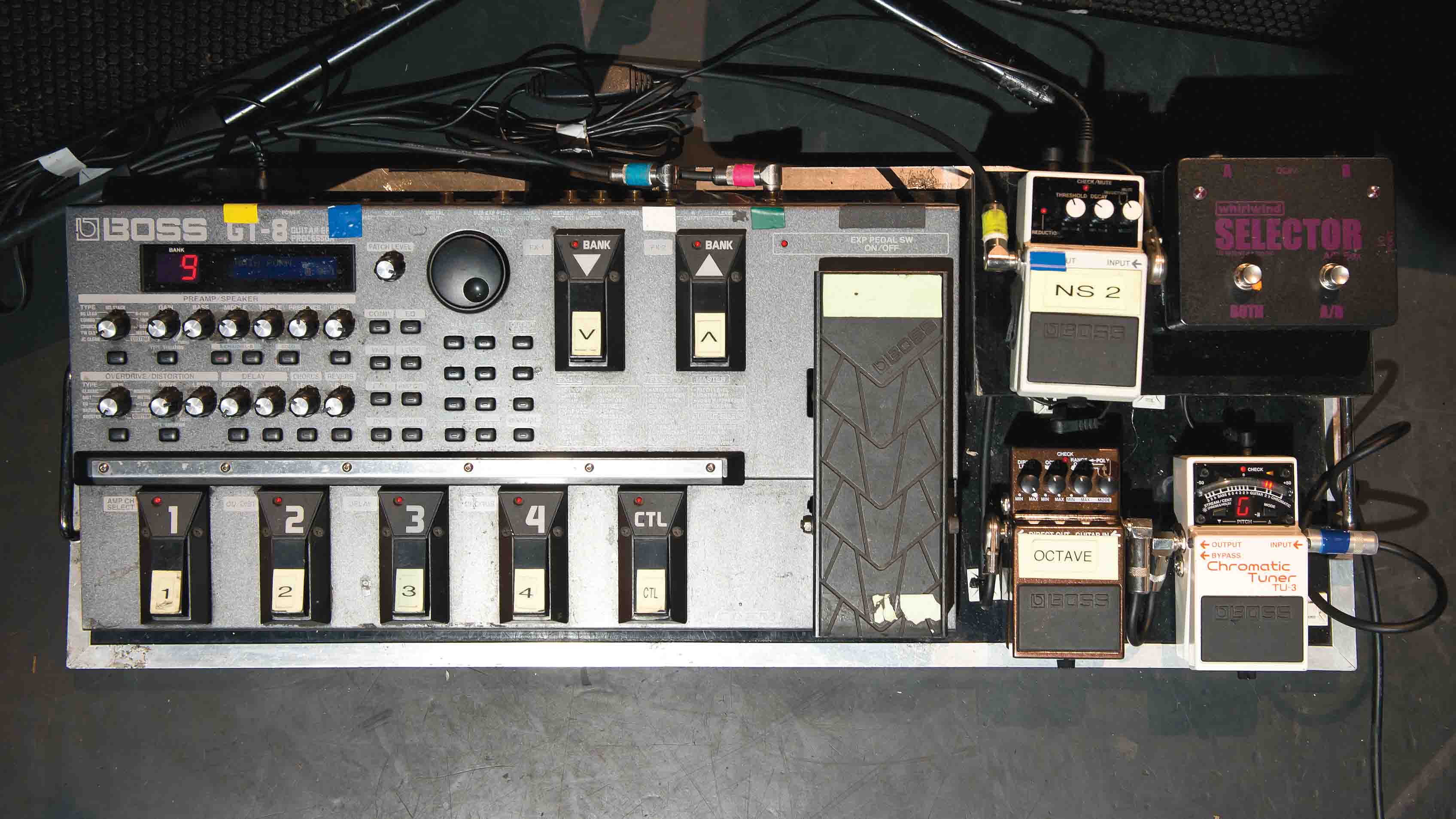
Nuno Bettencourt, Extreme
Boss GT-8 Effects Processor
“The pedalboard that I’m using... well, I’m not much on effects anyway, and with Extreme it’s always about the real minimalistic approach.
"Even though it’s a multi-effects unit, I use four patches for 90 per cent of the songs. There’s just a plain one, then a little bit of chorus on another one for all the chorus hooks that I play on.
"The third patch is like a solo boost - more for the volume and adding delay for the solo. The fourth is always a flanger. I just use that to go to for ‘vibe’ when I feel like that. That’s all that I really have on there. other than a few delay changes, that’s basically it.”
Boss OC-2 Octave
"I have a Boss octave pedal. I use it for a few songs. I don’t know if we’re doing anything right now, as in songs, that we’re using it for.
"There are songs like Comfortably Dumb and stuff off of [2008 album] Saudades De Rock, or whatever, that I’ll use it for if the songs were written that way.”
Boss NS-2 Noise Suppressor/TU-3 Tuner
"Other than that it’s just a noise gate and I think that’s it. Yeah, I think it’s just the noise gate there.”
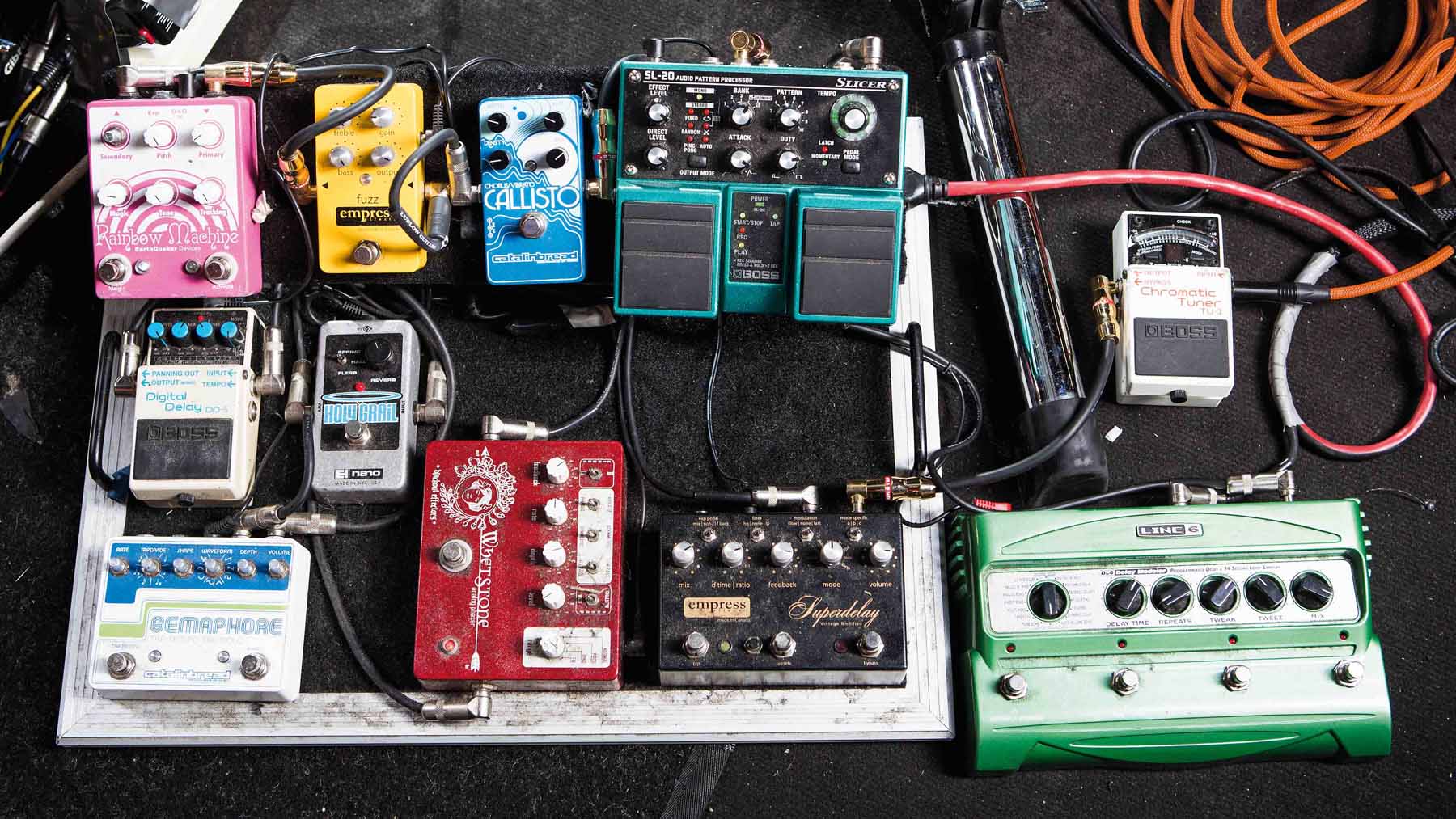
Omar Rodriguez-Lopez, Bosnian Rainbows
EarthQuaker Devices Rainbow Machine
"It's on there, just for a pitch shifter, and it does this strange little modulation thing. It’s on Torn Maps.”
Empress Effects Fuzz
“Empress Effects is a Canadian company. This one’s really nice – and it’s yellow!”
Catalinbread Callisto
“The Callisto is a chorus pedal that can also double as a vibrato pedal.”
Boss SL-20 Slicer
“It cuts up the guitar with these nice little preset rhythms that are there.”
Boss DD-5
“Me and Jeremy [Michael Ward, former Mars Volta member] saved up and bought them when they first came out, and it's been on the pedalboard ever since.”
Electro-Harmonix Holy Grail
“Although the reverb on my amp is great, I just got too lazy to walk over to it and turn it up!”
Catalinbread Semaphore
“For tremolo – it’s an amazing pedal.”
Blackout Effectors Whetstone Phaser
“An amazing phaser, it can also double as a vibrato pedal. It’s a really solid-sounding thing. I just leave it on most of the time, to tell you the truth, because I like the sound of it so much. On something like Turtle Neck, where it feels a bit more dreamy and lush, I wanted this sort of wavy, atmospheric sort of sound. I used tape delays like the Copicat tape delays in the studio. With the Blackout Effectors phaser, I change its setting, so I can get it to be more of a vibrato.”
Empress Effects Superdelay
“It’s really versatile, with modulation in it and all sorts of neat little tricks.”
Line 6 DL4
“My ultimate secret weapon. Well. it’s not even a secret, but I took the delay pedal that I liked the most away from myself so I didn’t have to rely on it – the Electro-Harmonix Memory Man. That is my favourite all-time pedal, but I feel like I relied on it so much, I loved it so much, that I wanted to see what sort of creativity would occur if I just didn’t have access to it at all.
“I like exploring, because I have never considered myself a musician. I never learned music theory or anything like that, I always saw it as painting or something, and that’s where all the effects pedals came in.”
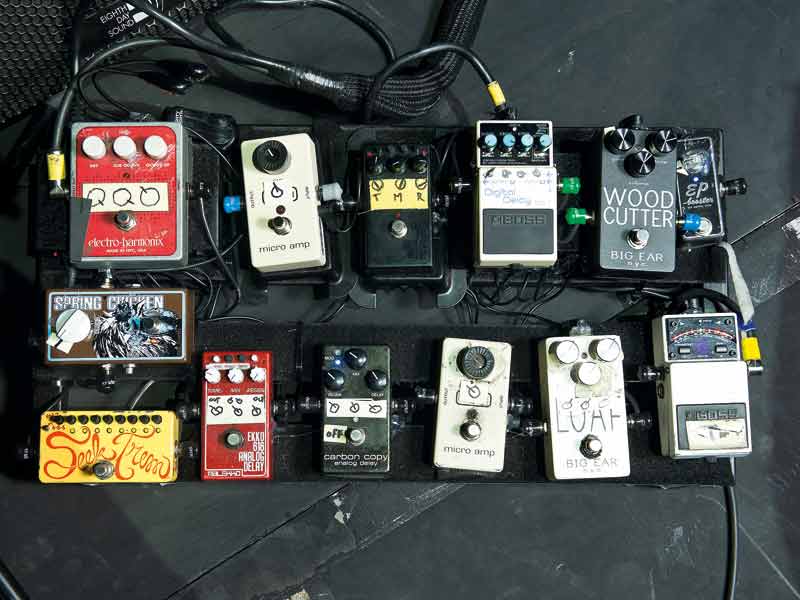
Paul Banks, Interpol
“I’ve not really changed my pedal rig over the years – delay and distortion are my main requisites.
"Luckily, my guitar tech is a nerd and he’ll often have something new for me to try out, and he’s had a lot of success with that.”
MXR Micro Amp & Xotic EP Boost
“I like my bass tone to be a little bit juicier than the straight amp sound.”
Big Ear Loaf
“This is a really clever distortion pedal.”
MXR Carbon Copy, Boss DD-7 & Malekko Ekko 616 delays
“I use a bunch of delay pedals, mostly an MXR Analogue, an old Boss DD-7 that has a couple of settings I really like, and a small boutique delay pedal [the Malekko] that’s pissing me off!”
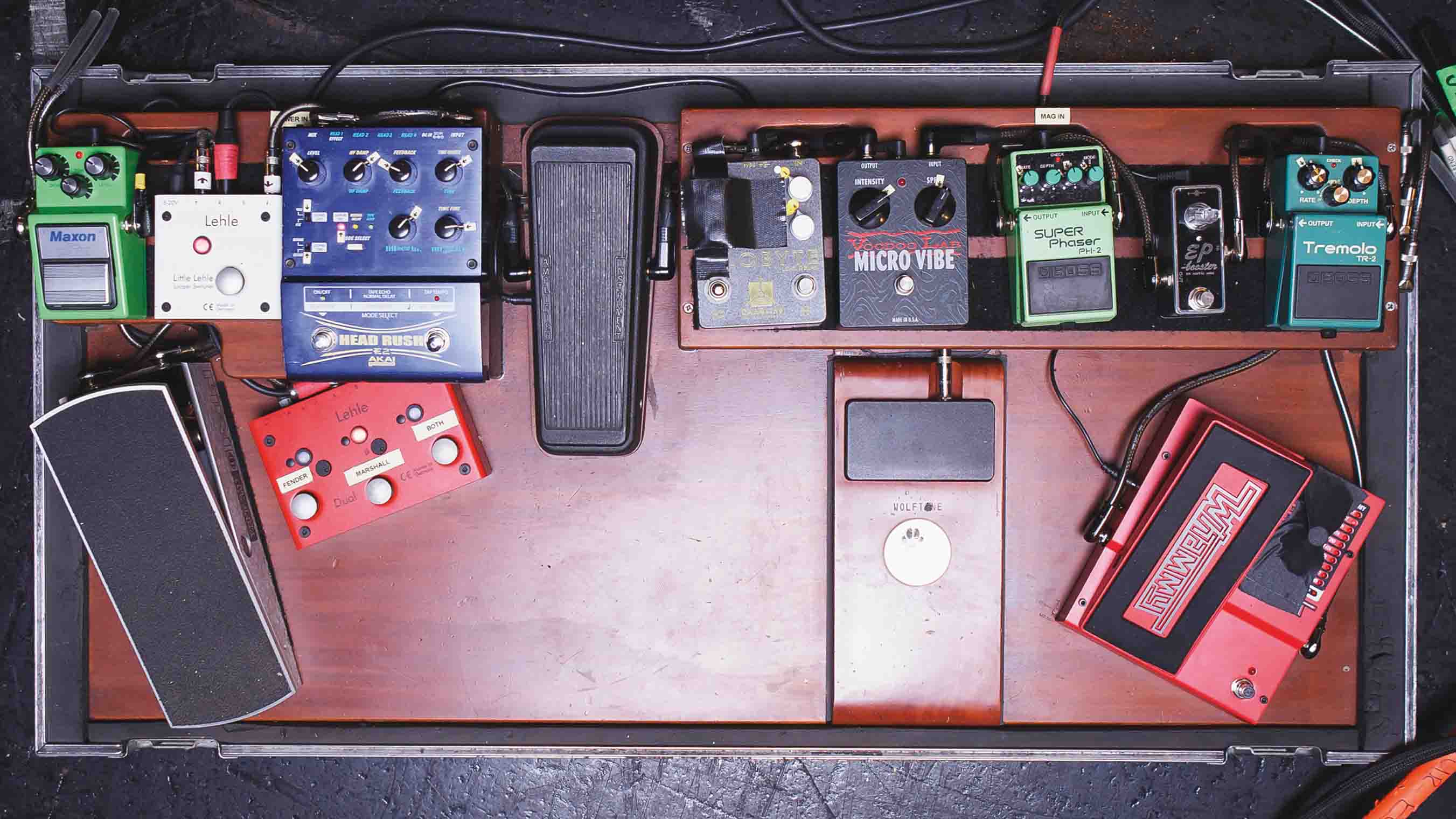
John Butler
Ernie Ball Volume
“It’s good, because you can really control your feedback. It takes a lot of palm muting to make some of these sounds work at high volumes, too. But I always see a volume pedal as kind of like the gas pedal on a car.”
Maxon OD-9, DigiTech Whammy, Lehle switchers
“Gareth [Russell], my tech, gave me this great little switch and plugged it all in, in very interesting ways I don’t understand. But basically, I can go through my Marshall and Fender so it’s a lot more versatile. So if I want that recorded sound of the Fender and Marshall coming in for a second chorus, I can have more of that studio-esque effect with two amps running different sounds.
“Gareth also brought switching in for the electric guitar. It’s cool how they can be configured to make different channels do different things. For electric, I can do the thing I have with my acoustic where I have my clean sound, but still have those nice blends. I can run straight through the Marshall and the Tube Screamer [Maxon] and I can go through just the Fender.”
Wolftone Stompboard
“I use a stompboard for Ocean [the 12-minute solo instrumental set staple that is John’s signature tune] and I use it a lot when I play solo, especially. That’s why this looks quite different to most pedalboards, because of all this space. All the times when I’m sitting down solo, I’m living on it, like I’m in a car with the controls.”
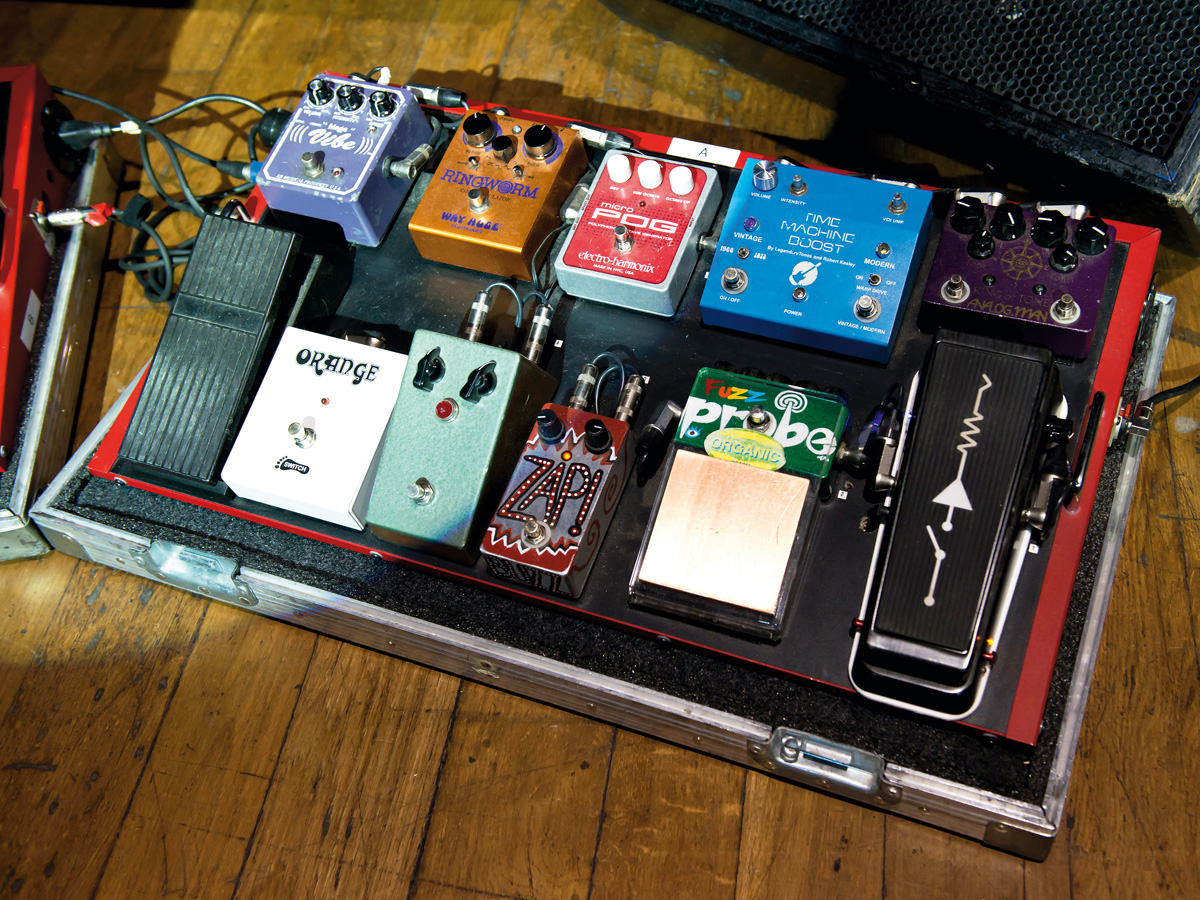
Scott Holiday, Rival Sons
"These are my robot friends. Usually people like to hide this stuff, but I decided a couple of years back, 'Why hide it?'
"It cost a lot of money, it's very individual and there are a lot of choices. So now I'm going to show you everything and if you want to go buy it, you can and spend a million-billion dollars, like me."
Custom Audio Electronics Dual Inductor Wah
"I've used several wahs throughout time, but this is the one that I'm using right now.
"It's really good. It's got a couple of inductors [giving a choice of high or low-mid emphasis], it's got a boost on it and it's got a cool graphic on top - so it must work good!"
Analog Man King Of Tone
"Right above the wah is the Analog Man King Of Tone. It's the version four King Of Tone, which is coveted. It's a wonderful overdrive – beautiful."
Keeley Time Machine Boost
"Widely used in this band for all of the early records [2009's Before The Fire and 2011's Pressure And Time] is the Keeley Time Machine Boost.
"It's basically like an old Dallas Rangemaster [the sought-after 60s treble-booster made popular by the likes of Brian May and Tony Iommi]. It's hardwired and it's got a Germanium tranny in it. It's awesome."
Z.Vex Fuzz Probe
"This is one of my favourite pedals on the board. Look how good it looks, it's got a giant copper plate, funny graphics and it's organic, so it's really great.
"It's kind of like a theremin built-into a germanium fuzz. It's distracting, freakish and hard to control - I love it!"
Zap! "mystery pedal"
"This is the mystery pedal. What could be inside that box? Well, I won't tell you, but it's called 'Zap!' and that's basically what it does: it zaps ya! It's a fuzz I use on basically everything."
Electro-Harmonix Micro POG
"Everybody knows this one! It's the Electro-Harmonix Micro POG [octave pedal] and I think everybody knows where that goes in our set."
Basic Audio Gnarly Fuzz
"Another mystery box. What could it be? I am going to tell you what this one does: it's a Basic Audio Gnarly Fuzz. I use this on a lot of the earlier stuff, too, as well as some of the newer songs."
Orange amp switch pedal
"This just switches me between the two OR50 heads. As I told you earlier, I use the two for a clean and a dirty sound and that's how I get it."
Way Huge Ringworm
"This is a Ring Modulator made by the wonderful people at Way Huge. It's also difficult to control, unpredictable... What will it do next? We do not know..."
KR Effects Megavibe Phaser
"This is probably one of the best production - if you could call it that. It's just one guy, Kevin Randall, who builds these - Uni-Vibe clones.
"It's called a Megavibe and he makes a big box one like the original and also this small one, which is super-duper accurate."
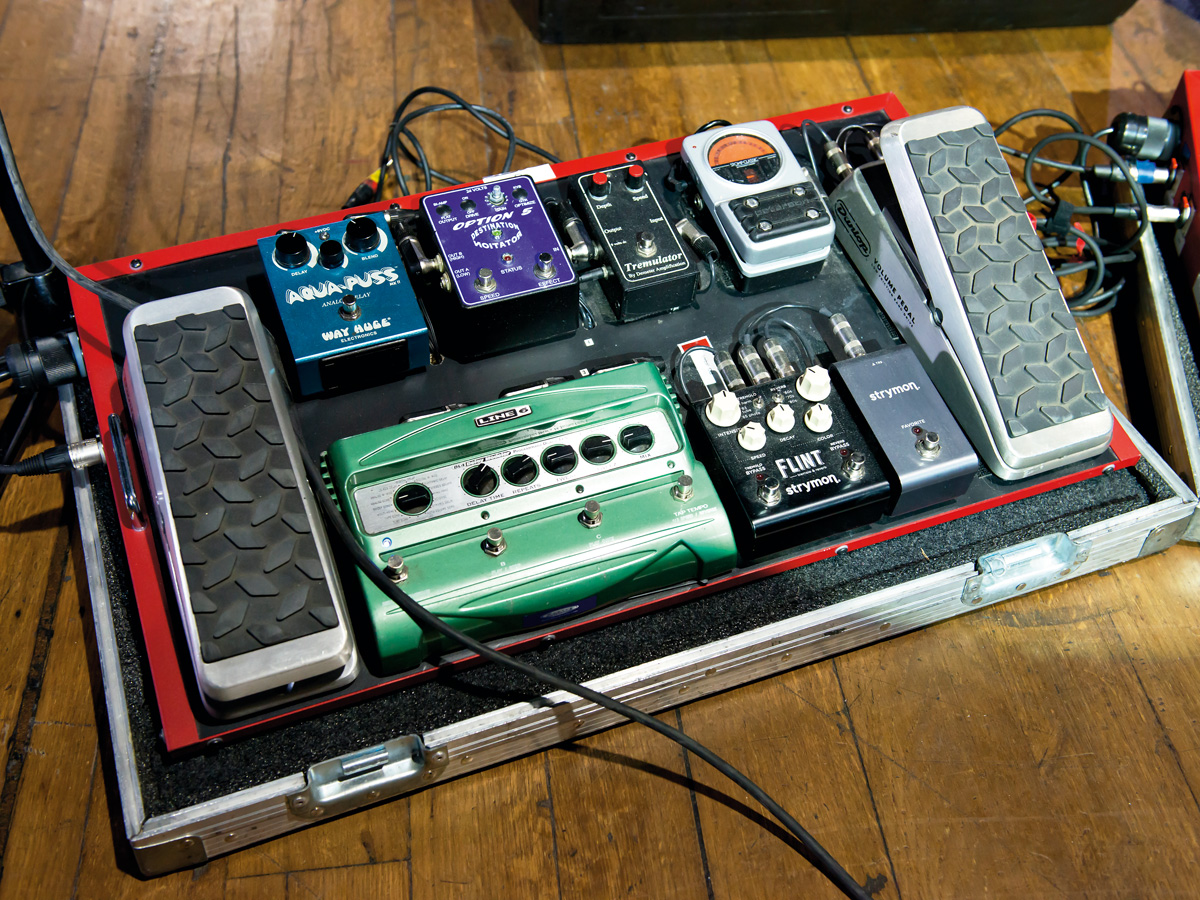
Dunlop Volume Pedal
"It's a volume pedal. There's nothing much more to say about that. It's not that exciting, but it's a Dunlop volume pedal and it works great."
Peterson Stomp Classic
"This is just a little tuner that I rarely use, because I've got a wonderful tech, Mr Chris Draper, who does a great job.
"But it looks cool, it spins around and it makes my 'board look great!"
Strymon Flint
"This is something I got when we started touring [third album] Head Down. It's the Strymon Flint and I get reverb and tremolo sounds out of this."
Demeter Tremulator
"Above it is one of my oldest and trustiest tremolo pedals, the Demeter Tremulator, which was originally built for Ry Cooder to emulate the Fender Tremolo. I love it."
Option 5 Destination Rotation
"This one is actually out of production. It's the first one he made - my buddy Jay Woods over in the US built that.
"I've had it modded, if you can see, I don't want any of the knobs, except the gain knob, so he plugged it up for me. It's been working ever since I got it years and years ago and does a kind of rotary Leslie speaker effect."
Way Huge Aqua Puss
"One of the best-named pedals on the 'board - the Aqua Puss. It is an analog delay that we use for all sorts of, well, delay!"
Line 6 DL4
"I'm sure everybody will be very familiar with this; it's the Line 6 DL4.
"I had mine modded by [noted US effects guru] Robert Keeley and he put better lights in it - so that must make it cooler - as well as improving all of the sound, so there's no noise. The floor to noise ratio is really, really good."
Modded Dunlop Volume pedal
"This pedal looks just like the one over [on the right of the board], but my good buddies over at Dunlop turned it into an expression pedal for the DL-4.
"So there you go... That's the robots! Now get the cheque book out and go and buy it!"
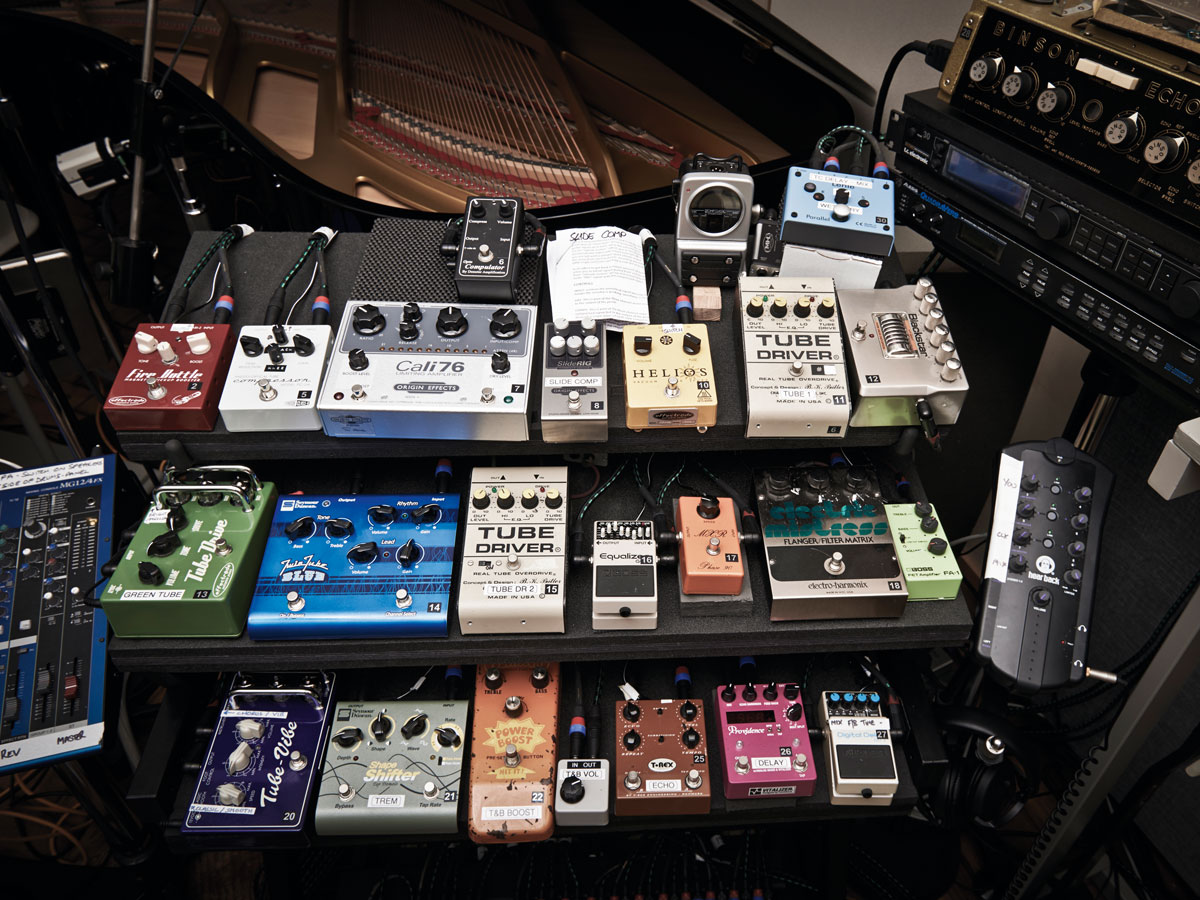
David Gilmour, Pink Floyd
A number of Gilmour’s go-to pedals are mounted on racks at hand-adjustable height in the live room, for convenience during use, but can be accessed from the control room, where - in case these weren’t enough - a second, variant rack of pedals is located.
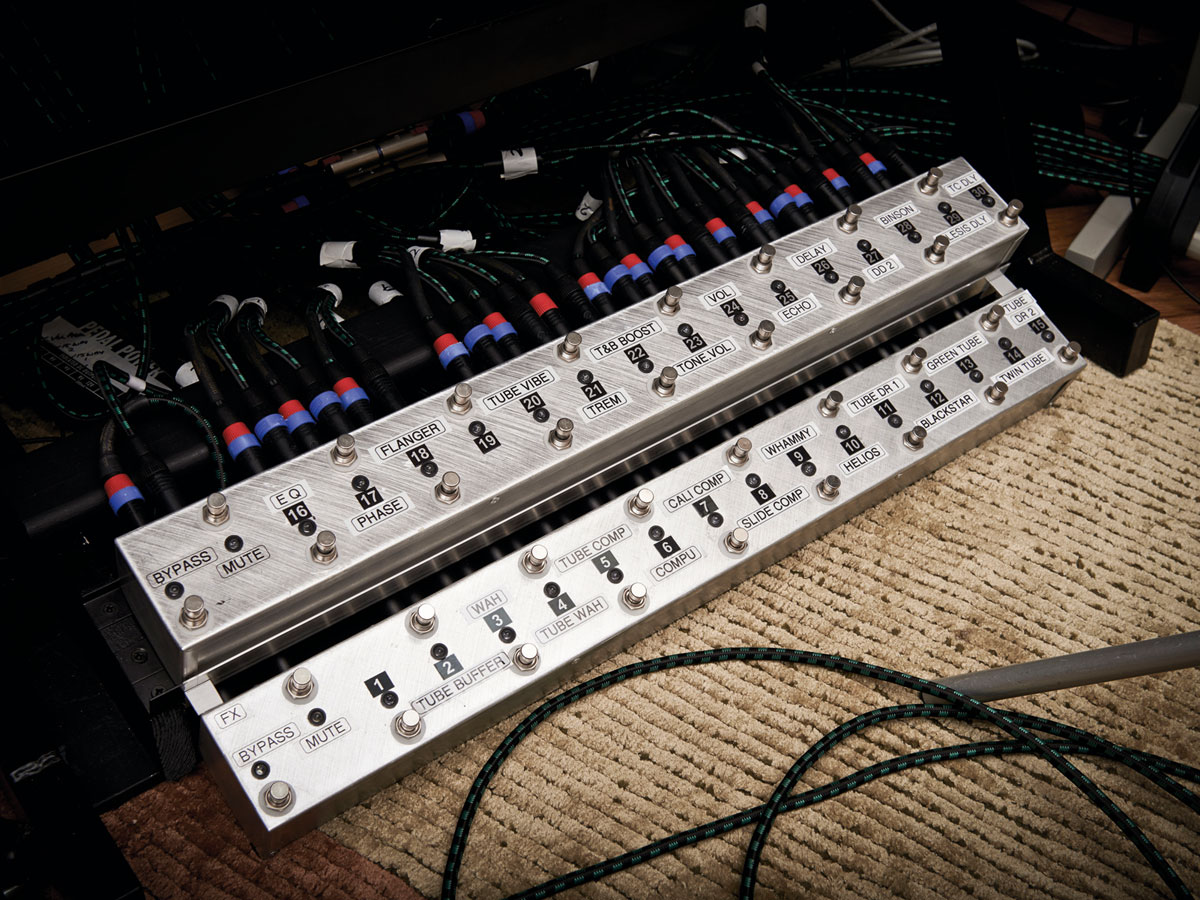
A custom switching system on the floor allows the racked pedals to be engaged easily via conventional footswitches.
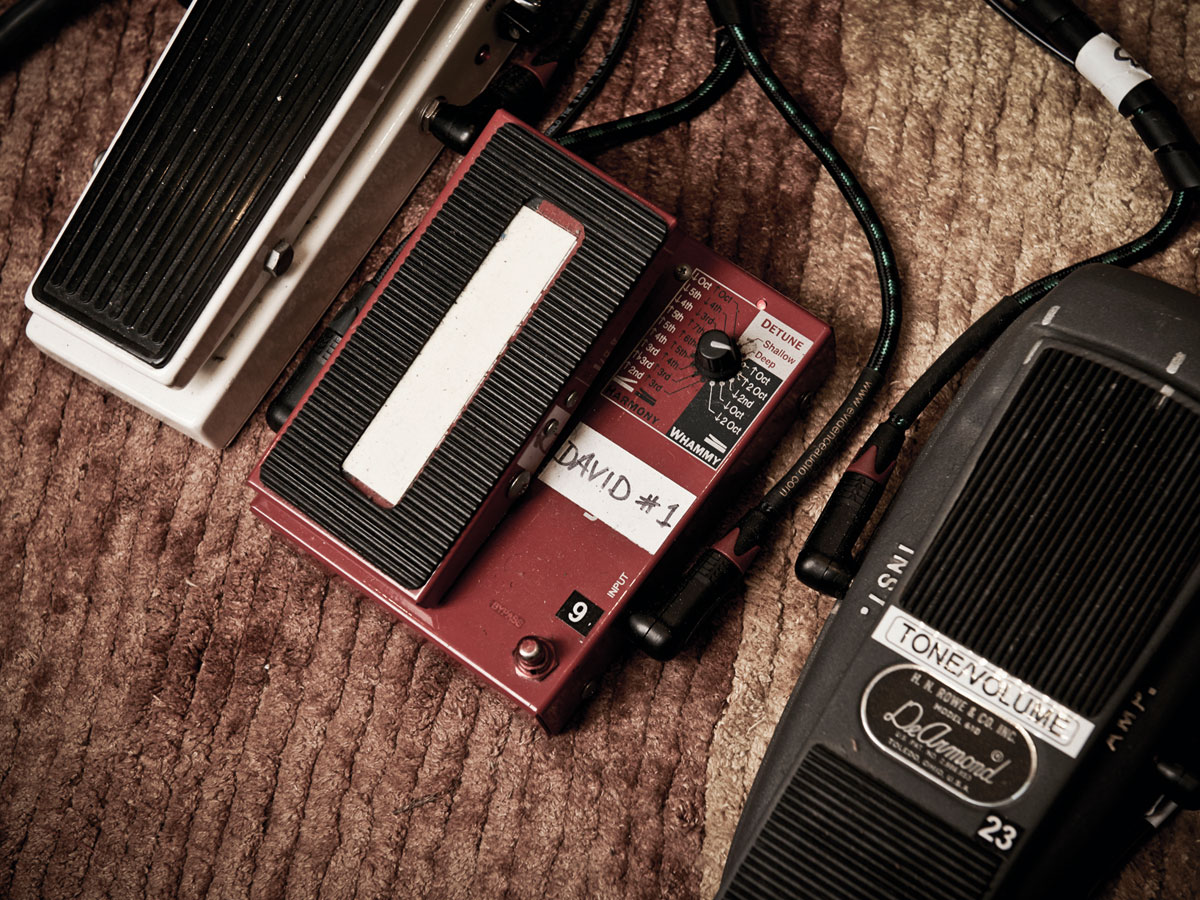
Phil Taylor [David Gilmour's guitar tech]: “I’m sure your readers can work out what this 1990s Digitech Whammy pedal is on. At the 1993 recording sessions that became the basis of The Endless River - recording The Division Bell at the time - I changed a couple of pedals in David’s set-up. Just so he had something else to try.
"He’d never used a Whammy before. But out of that came Marooned - which won a Grammy. And there are bits of Whammy on The Endless River. He generally uses it in the ‘one octave up’ position. And that’s it. Is David playing slide, or is he playing a Whammy? Let’s leave a bit of mystique!”
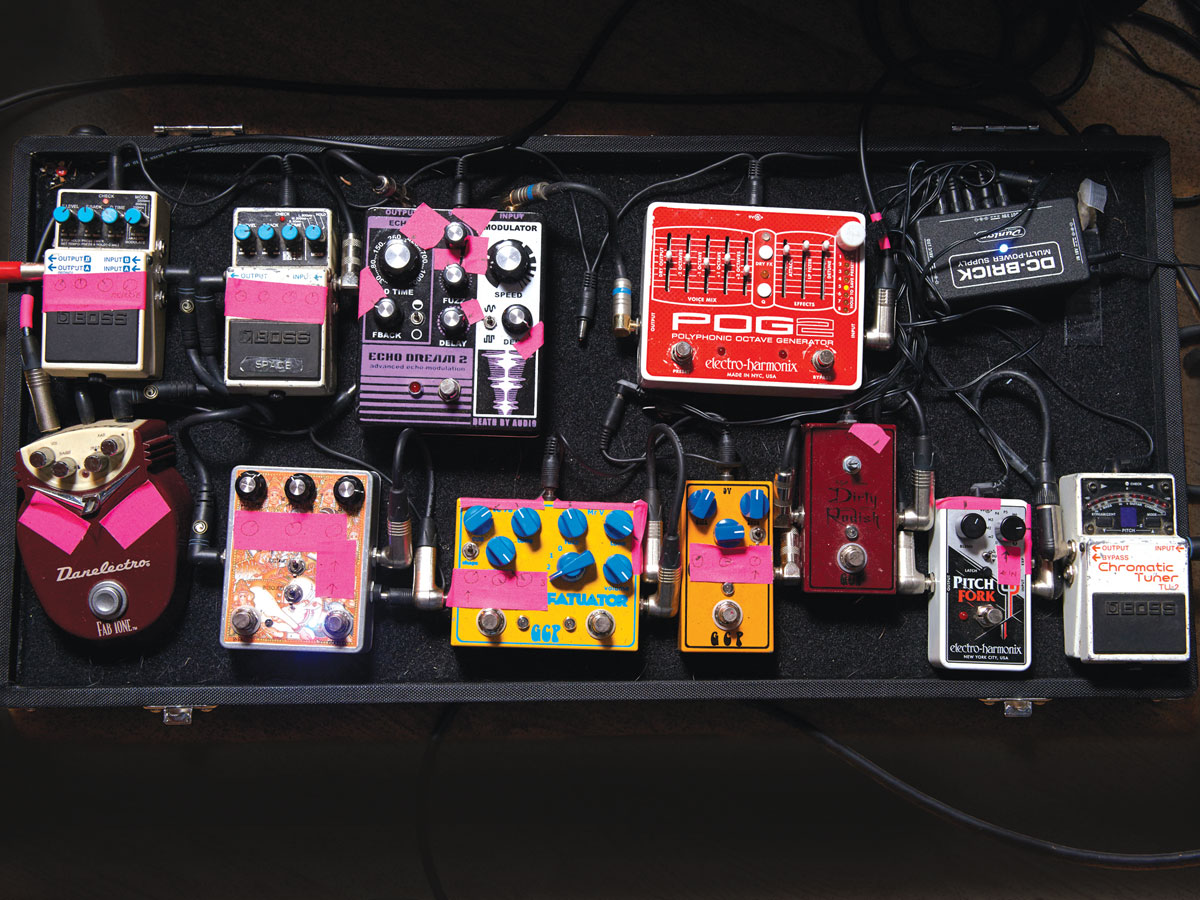
Mike Vennart
Electro-Harmonix Pitch Fork
“I'm using it in place of a Whammy; the Whammy was taking up too much space. That's the main sound on Infatuate.”
Green Carrot Pedals Dirty Radish
“That's a really nice boost, so I use that for a bit of overdrive.”
Green Carrot Pedals Cornstar
“It's just fucking deadly; that's a really clear, amp-style distortion.”
Green Carrot Pedals Infatuator
“You've got the Big Cheese on one side with four different settings of fuzz; I use that a lot for broken-up, Velcro-y shitty-sounding stuff. And then the other side is the IC Big Muff; it's got a switch on it that takes the tone control out so it just gets more woolly but really, really fat.”
Dwarfcraft Shiva Fuzz
“This is real volatile, horrible; it's not nice. It's just for really sick, My Bloody Valentine atonal nonsense – it's really good fun.”
Danelectro Fab Tone
“For when I just want to kill everyone.”
Electro-Harmonix POG 2
“That's just to fill the space; it's not even doing anything!”
Death By Audio Echo Dream 2
“That's my main delay; it's an analogue delay that's got loads of weird modulation in it as well. You get a lot of crazy oscillation and distortion out of it. It's really, really ugly and beautiful at the same time.”
Boss DD-3
“Just a standard digital delay.”
Boss DD-7
“This is set up for backwards delay. Everything is mainly backwards delay, but it's subtly done so you can't tell. Infatuate has that sort of delay.”
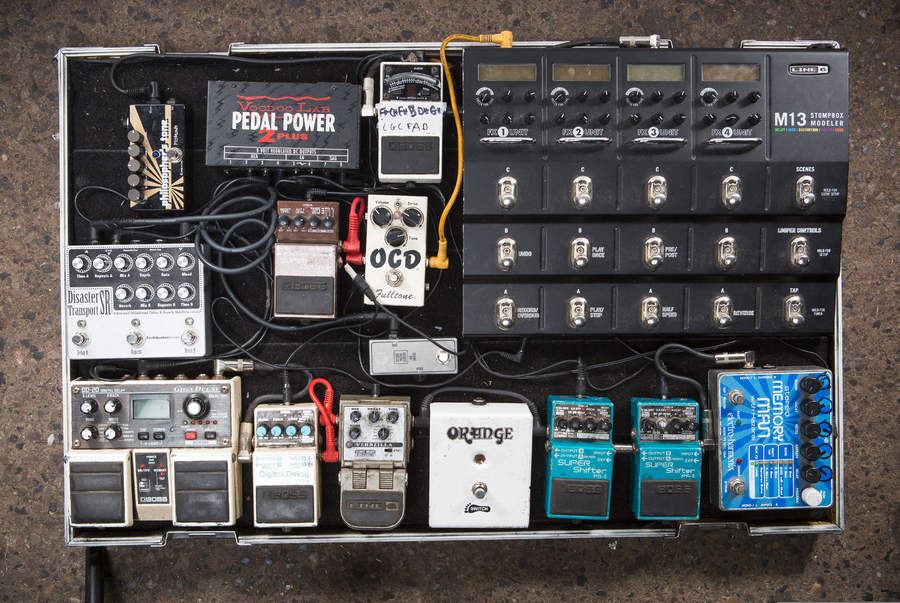
Rory Friers, And So I Watch You From Afar
Pigtronix Philosopher’s Tone
“I found that for my clean stuff, I was digging into the strings and breaking a lot of strings, because my guitar wasn’t thick or loud enough.
“I wanted to work on my clean tone, so I bought this, and it’s solved all my problems. I have it on for 50 per cent of my show.”
Line 6 M13
“Our last album had a lot of sounds, so it was impossible for me to make them all come on at the same time, so I had to resort to a multi-effects.
“And I was pleasantly surprised. I’d always had a bit of a thing - I guess a lot of people do - about multi-effects pedals, like they’re inferior, but for what I needed it for, it was great. And it has a looper in it, as well.”
Fulltone OCD
“My first gain stage is this OCD: you can have it quite subtle - a little gritty - or it works as a nice distortion if I’m ever doing any festivals where I don’t have my exact rig, and I might be using what’s at the festival.”
Boss OC-3 Super Octave
“This is just an octave pedal, really. I’ve had it for ages and it does the job.
“I use it less and less, actually, because I have a preset on the M13 that I really like, but I use this whenever I’m doing some volume stuff, like low volume-y stuff with some delay on.”
Orange Footswitch
“My amp is a Thunderverb 200-watt, and I use the two channels - clean and distortion - which I activate on this.”
Electro-Harmonix Stereo Memory Man with Hazarai
“I actually just have it on one setting, the 300-millisecond modulation, and have everything turned to turn it into this self-oscillating insanity, so essentially, whenever I press this button, it just creates this big, thunderous, cacophonous ‘reeargh’.”
Boss PS-5 Super Shifters
“I have one set to go from natural up to two octaves above in a big, long linear ‘weeeooorp’.
“And then I have the other one set to go up with zero attack, so it jumps from the natural sound to a 5th up, and I use this for this arpeggiation thing: I’m doing hammer- ons on triplets, and I’m pressing this on the beat. It makes it sound like I’m really good on the guitar.”
Line 6 Verbzilla
“I use it on a hall setting; sometimes I’ll have it full mix up, so it’s just reverb, sometimes not, but I usually don’t mess around with it too much.”
Boss DD-6 Digital Delay
“I have it set to loop: whenever you press and hold it the loop starts, and when you release it the loop ends.
“So, the shorter you do that, then the shorter the sample it records, so I use it to do little stuttery ‘brrrrp’ effects every now and again.”
Boss DD-20 Giga Delay
“I use it on a standard digital delay with tap tempo. I don’t really do anything very fancy with it.”
Earthquaker Devices Disaster Transport SR
“This is probably my favourite pedal on the ’board at the minute - it’s gorgeous modulating delay, set for really slow, really long delays, repeats up really high.
“You can just brush the strings and just let the sound of the pedal do the rest.”
Bright Onion Pedals Kill Switch
“It just makes everything stop, and we try and make everything sound tight: nice, straight cuts.”

Niall Kennedy, And So I Watch You From Afar
Ernie Ball VP Jr
“I just use that with delays and reverbs to do swells and things like that.And sometimes, I’ll have the POG on as well, which can get a big, thick low-end sound, and have loads of reverb and delay stacked and do big, huge swells.”
Boss TU-2 Tuner
Boss PS-6 Harmonist
“This does pitch modulation-type little bends, like in Big Things Do Remarkable I use it at the end and do a big pitch bend, and use it throughout the set in the same way a drummer would do a drum fill.”
Electro-Harmonix Pog 2
“I use the POG for all the octave stuff.”
Earthquaker Devices Rainbow Machine
“I just use it in the same way that I would use the Harmonist, for weird little drum fill-type things - I don’t know what the equivalent is for guitars!”
TC Electronic Spark Booster
“I’ve got the clean on the amp, and the Spark gives it just that little bit of grit.”
Orange Amp Footswitch
“The Orange distortion is the main distortion sound.”
TC Electronic Hall Of Fame
“I use the effects loop to stick in this reverb - I have that on church setting, just a big, huge sound, have the mix up real high, the decay up real high.”
Earthquaker Devices Disaster Transport SR
“This gives you that really beautiful tape echo-type delay sound.”
Line 6 M9
“I use this for all my delays, some of my reverbs, and then I also use a kind of rhythmic tremolo to create a choppy sound, a bit of a drum-fill sound at the end [of songs].”
Bright Onion Pedals Kill Switch
“Sometimes, it’s good to have a panic button, so you can completely kill everything, but I also use it to do a big crescendo and then [clicks fingers] to nothing. We’ll use it like that to make super-tight cuts.”
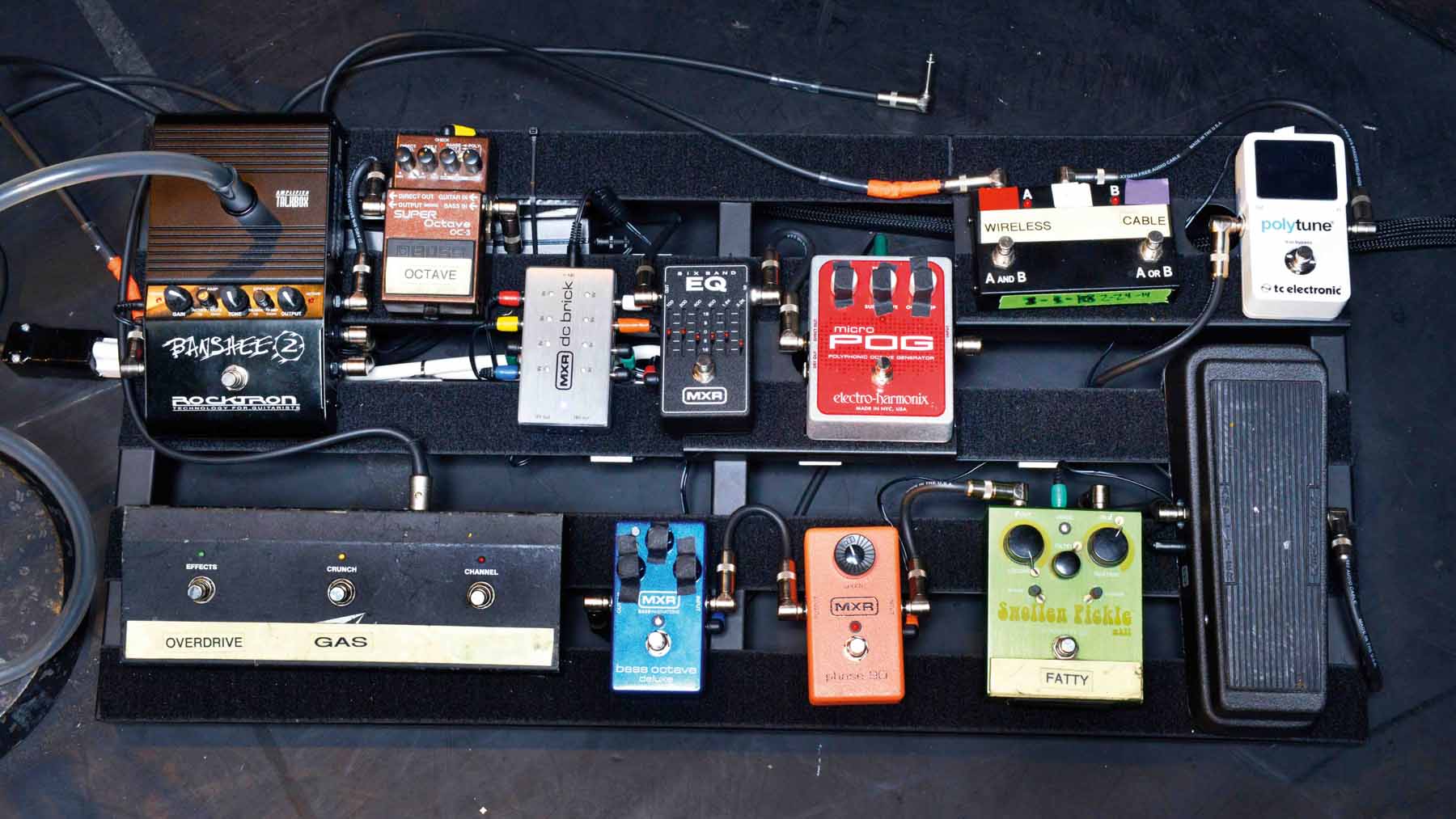
Ben Wells, Black Stone Cherry
Peavey 3120 footswitch
“This is my amp footswitch. We call my main heavy sound ‘gas’, and then the overdrive is the Peavey rhythm channel that we run as a quieter sound.”
Rocktron Banshee II Talk Box
“This is a pretty sweet pedal – it allows me to have the Talk Box signal and the amp signal at the same time, and if I don’t want that I just click a button and it goes to just the Talk Box. I use it on White Trash Millionaire and Me And Mary Jane.”
Boss OC-3 Super Octave
“This is linked up to the Banshee II, so every time I click the Talk Box on, the Super Octave [engages] with it.”
Jim Dunlop Hendrix Cry Baby
“I use a Budda wah in America, and it’s a sweet wah, but when we got new pedals to duplicate our 'boards over in Europe, I wanted to try the Hendrix wah. I was just hoping it sounded good! And [fortunately] when I got it in, it was perfect.”
Electro-Harmonix Micro POG
“This is probably one of my favourite pedals on the ’board. We have it set to do an organ-style effect, and it sounds incredible. I could play it on every song, but I don’t want to overuse it.”
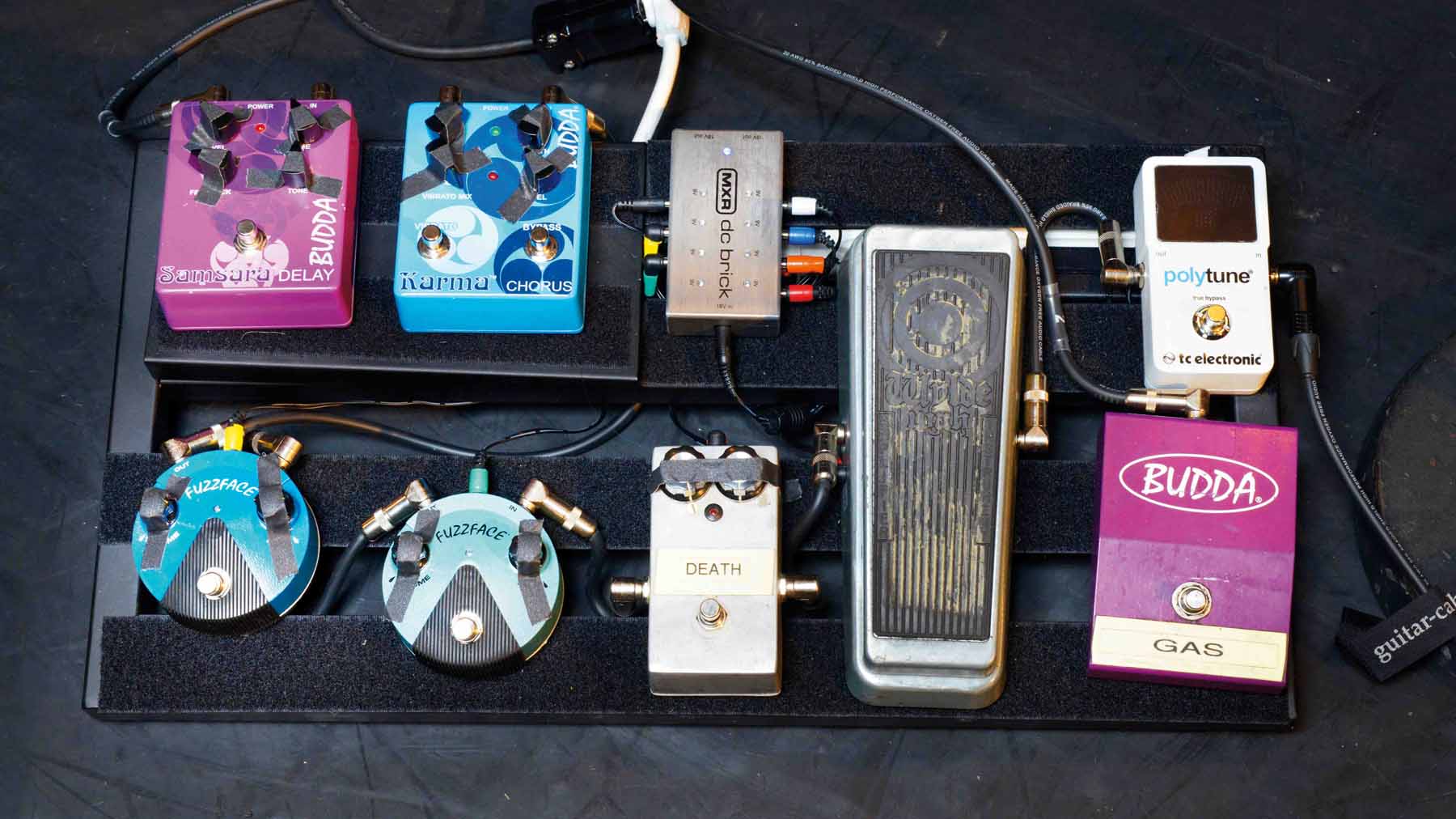
Chris Robertson, Black Stone Cherry
Dunlop Zakk Wylde Cry Baby
“I use this wah because I like the sweep. I prefer a wah that doesn’t have a button, and that just self activates when you put your foot on it.”
Death Box
“I use this on a few of our songs – Change, Ghost Of Floyd Collins and a couple of others. It’s kind of like a fuzz pedal with an octave up. It’s actually a clone of an Ampeg Scrambler that I picked up on eBay for $70.”
Jim Dunlop Jimi Hendrix Fuzz Face Mini
“I use this for a lot of my lead work, and also for a lot of the stuff from the new record. Then there are also a couple of [older] songs, like White Trash Millionaire, that I use it on now.”
Jim Dunlop Silicon Fuzz Face Mini
“This is another Fuzz Face, and it’s set just for rhythm fuzz for the tracks that we did on the new album. I use it if the amp is feeling a little light, just to give it that extra ‘oomph’. I don’t like a really bright guitar sound and a Fuzz Face pulls the highs back.”
Budda Samsara Delay
“If I just want to add that extra bit of wetness – if the room is really dry, or something – I’ll use the Samsara.”
Budda Karma Chorus
“I don’t really even use the chorus, but it’s got an extra button for vibrato, so I keep the vibrato on. I use it for songs like Fiesta Del Fuego and Me And Mary Jane, which have this super-fast vibrato on verse parts.”
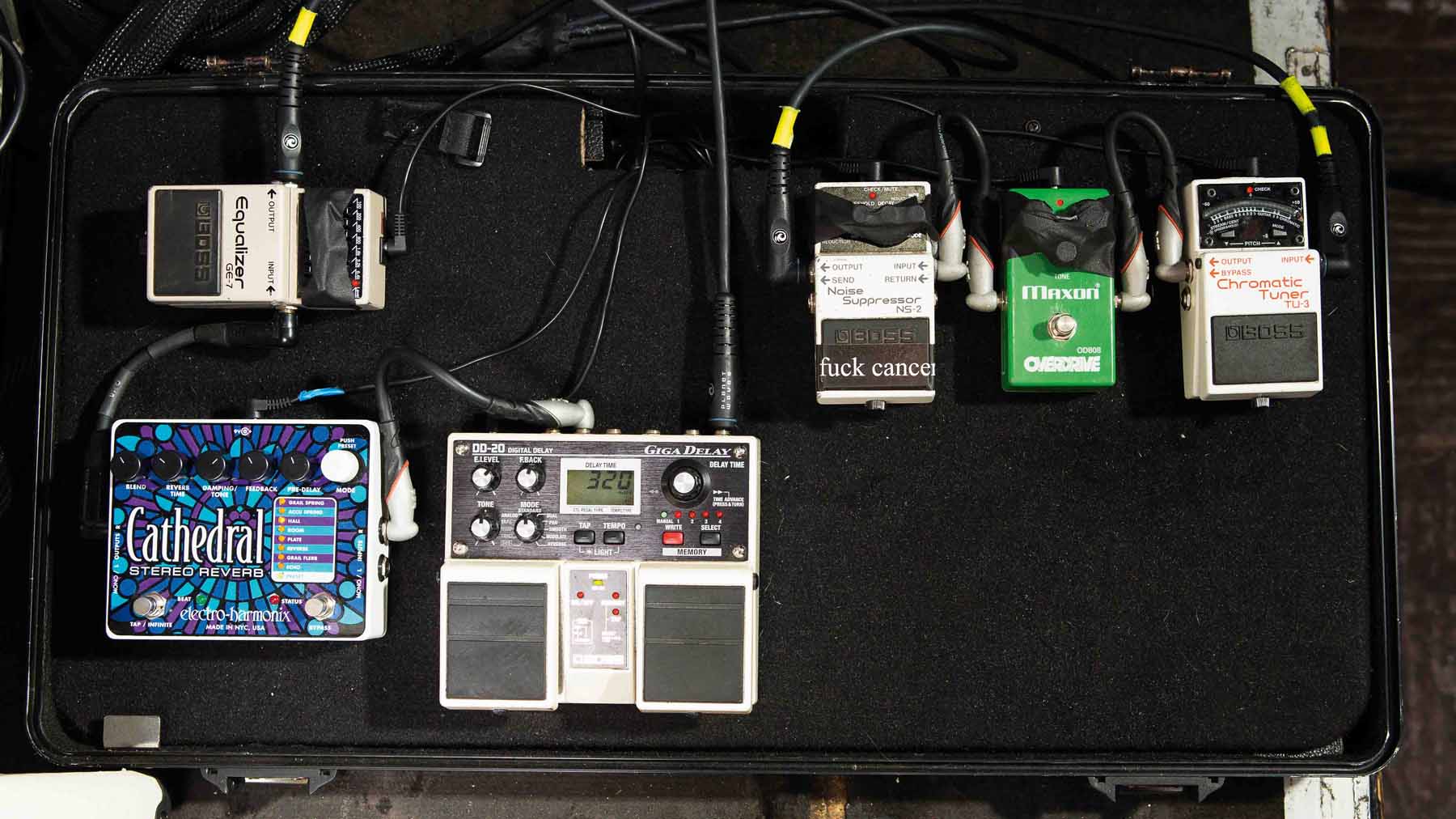
Elliott Gruenberg, Blessthefall
Boss NS-2 Noise Suppressor
“I think I’ve had that for seven years, and it’s my oldest pedal. I’ve been contemplating buying a new one. I’ll run that, and then the signal goes back into the front of the head from there. Then I have effects in the effects loop.”
Maxon OD808
“This is my favourite Tube Screamer-type pedal. This is the dream one I always wanted – either this, or the Fulltone OCD. This one is used by Killswitch and As I Lay Dying – many bands in that kind of vein were advocating it.
“Great saturation, it’s awesome and it makes your pinching sound great. The tone is pretty much in the middle, and I balance the gain from the actual head with the pedal, so it’s not too much.”
Boss TU-3 Tuner
“Pretty standard – I had a TC Electronic PolyTune for a while, but I found in a live setting when I’d strum open, it didn’t always get it. And it can only go so many semitones [down] before it loses frequency, so I went back to the TU-3 just because it’s easier.”
Boss DD-20 Giga Delay
“It’s one of my favourite delays. I went between this, a [MXR] Carbon Copy and a TC Nova Delay. I love the Carbon Copy for what it does, and the Nova Delay is great, Eric runs that. But the DD-20 is just easy and user-friendly. It’s the iPhone of pedals.
“I keep that pretty standard, and on this tour, I’ve kept it on the tap tempo. There have been times before when I’d go through and bank everything, adjusting the effects levels, but I find it varies according to the rooms we’re playing sometimes. It can be subjective to what sounds good in our practice space, and whatever venue we’re playing.
“There’s leads I’ll use it on, but on the new record there’s lots of pretty swells, lots of parts to complement our sound so it’s not so dry. Even when we do our older songs, I try to put it on when I’m playing things like octaves, so it’s not so abrasive. That’s why we use passive pickups, too.”
Electro-Harmonix Cathedral Stereo Reverb
“This is the newest pedal I’m running. I used to run the Holy Grail, but Eric’s using mine right now. He had this one originally. They’re a bit fragile, but they’re great, and they sound good. Lee [Malia] from Bring Me the Horizon is the one that sold me on it. I feel like I’m on Logic with it, and I pull up all my reverb plugins with it.”
Boss GE-7 Graphic Equalizer
“I think this is the most important pedal I have, because this is what will sculpt the tone. For my sound, I boost the bass a little bit, the lower tones, then I bring it up a little towards the mids so it gets a little of that high saturation. Then I just run that to the return of the amp.
“It can be a volume booster if you want it to be, but whatever rig I ever play, I’ll probably always try to run an EQ on it. You can hear where the bad things are, and just cut them out. You’re saving the sound guy some time by doing it.
“I find that a lot of times with high gain, once you get to saturation you’re really in a battle to hear notes – and you want it to be clear and crisp. This thing definitely helps sculpt the tone. I remember when I brought this to Eric and I said, ‘Listen, we need to run these’ and it just kind of changed the game for us.”
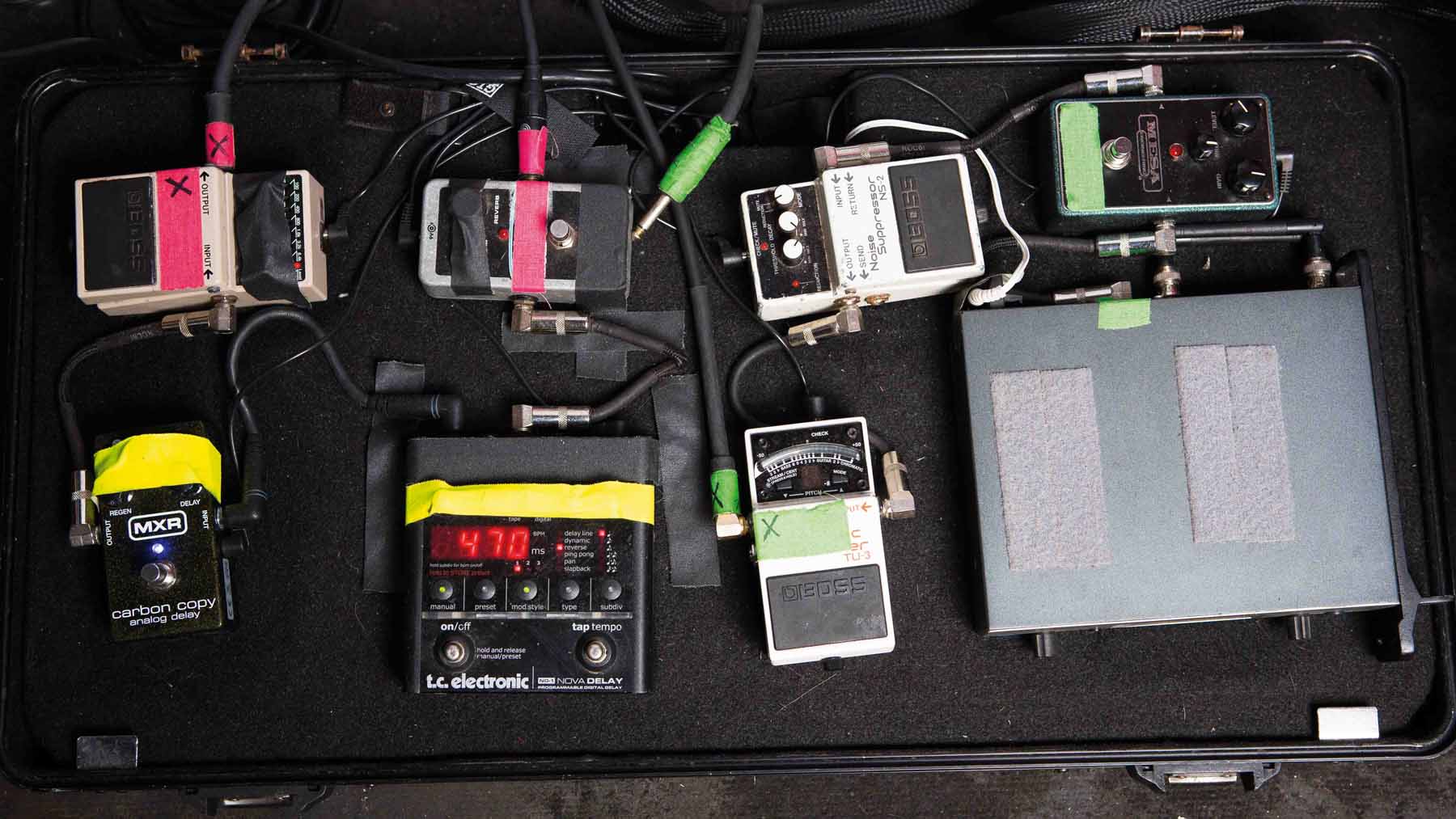
Eric Lambert, Blessthefall
TC Electronic Nova Delay
“This can make any delay I want; from ping-pong to reverse and feedback. It’s a very technical pedal; it takes hours to try and get the right delay, but you can tap everything out to tap tempo, and I can pretty much load up everything from our sessions to this pedal, too.”
Boss GE-7 Graphic Equalizer
“I scoop out some of the mid and let the highs cut through a little bit more. I don’t do much more than that. If I step off that pedal it almost sounds like a lo-fi on my amp.”
Electro-Harmonix Holy Grail Nano Reverb
“We have a couple of bluesy solos that I’ll throw that on to give it a little more atmosphere. Then that’s it, as far as the effects loop is concerned.”
MXR Carbon Copy Delay
“This is probably my favourite pedal on the ’board. It gives me a nice little studio delay. Any type of little lead I have that I don’t want to be so raw, I’ll kick on the MXR. It makes everything flow a little easier for me. On solos or tremolo picking parts, it’s really nice.”
Mesa/Boogie Grid Slammer Overdrive
“I use this on the front side, that’s my Tube Screamer right now. I don’t have it on right now, though, because the pickups are really hot in the guitars I’m using right now, so I actually don’t really need that. But over in the States I usually use it, as it gives a nice bite.”
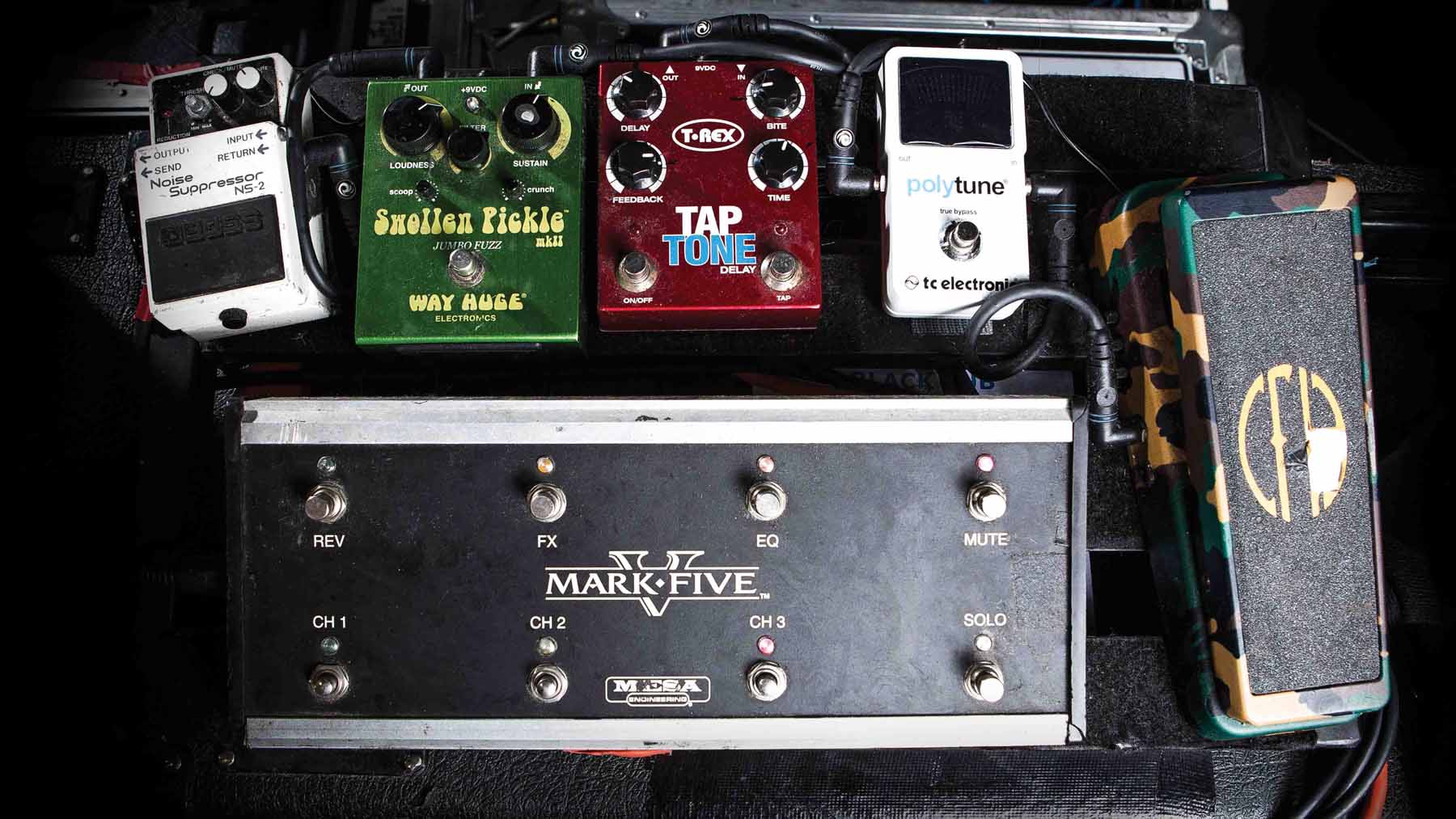
Ben Weinman, The Dillinger Escape Plan
Jim Dunlop Dimebag Signature Cry Baby Wah
“It’s a little more complex than the typical Cry Baby from Dunlop. You can affect gain and the range of scoop and sound and tone diversity and dynamic – and I’ve also had it customised to have an automatic on and off, so as soon as I let go of the wah it turns off.
“I always had problems where I’d leave it on and walk away and my tone would be totally screwed up and I couldn’t work it out. Now I have this so that it automatically turns off [similar to the Morley Bad Horsie wah].”
Mesa/Boogie Mark V foot pedal
“It’s got a reverb on/off control and the five-band EQ on and off, it’s also got a mute, which is great, because you can put the tuner in-line and have the tuner on all the time and just press ‘mute’ if you want to tune. You’re seeing the tuner on while you’re playing, too, so if you need to make sure you’re in tune while you’re actually hearing the music that’s really convenient.”
Boss NS-2 Noise Suppressor
“It really cleans up your tone a lot without taking out too much sound from it. A typical gate works a little differently, but the Suppressor just cleans up the hum. When you have a really good, high-quality amplifier, I don’t think you really need a gate, but having something that helps take out some of the hum and the hiss of the electricity that’s going through the amp – especially when you’re travelling a lot to different countries with different electricity – helps a lot.”
Way Huge Swollen Pickle Fuzz
“It’s a pretty funny name, but it doesn’t sound funny: there’s nothing funny about the Swollen Pickle! It’s basically like a really high, distorted fuzz. It says on it here that’s it’s ‘jumbo fuzz’. I use it on a song called Room Full Of Eyes where we just need to take it up a notch and make it really, really heavy… It just makes everything that you put through it gnarly.”
T-Rex Tap Tone Delay
“I have the tap set right now for a song called One Of Us Is The Killer, which is the title track off of our latest record, where I have a kind of ping-pong-y thing going on with a linear lead. I also use it for effects and noise quite a lot, as well. There’s one song called Crossburner that I use it on quite a bit.”
TC Electronic PolyTune
“It’s amazing, because you can strum all of the strings and see simultaneously which ones are out. It shows you all of the strings in the spectrum, or you can use it just individually. A lot of tuners you can [only] use it one way or the other, but with this you can use both. It’s really small and the TC Electronic stuff is great… the firm’s really innovative with the way that it’s doing things.”
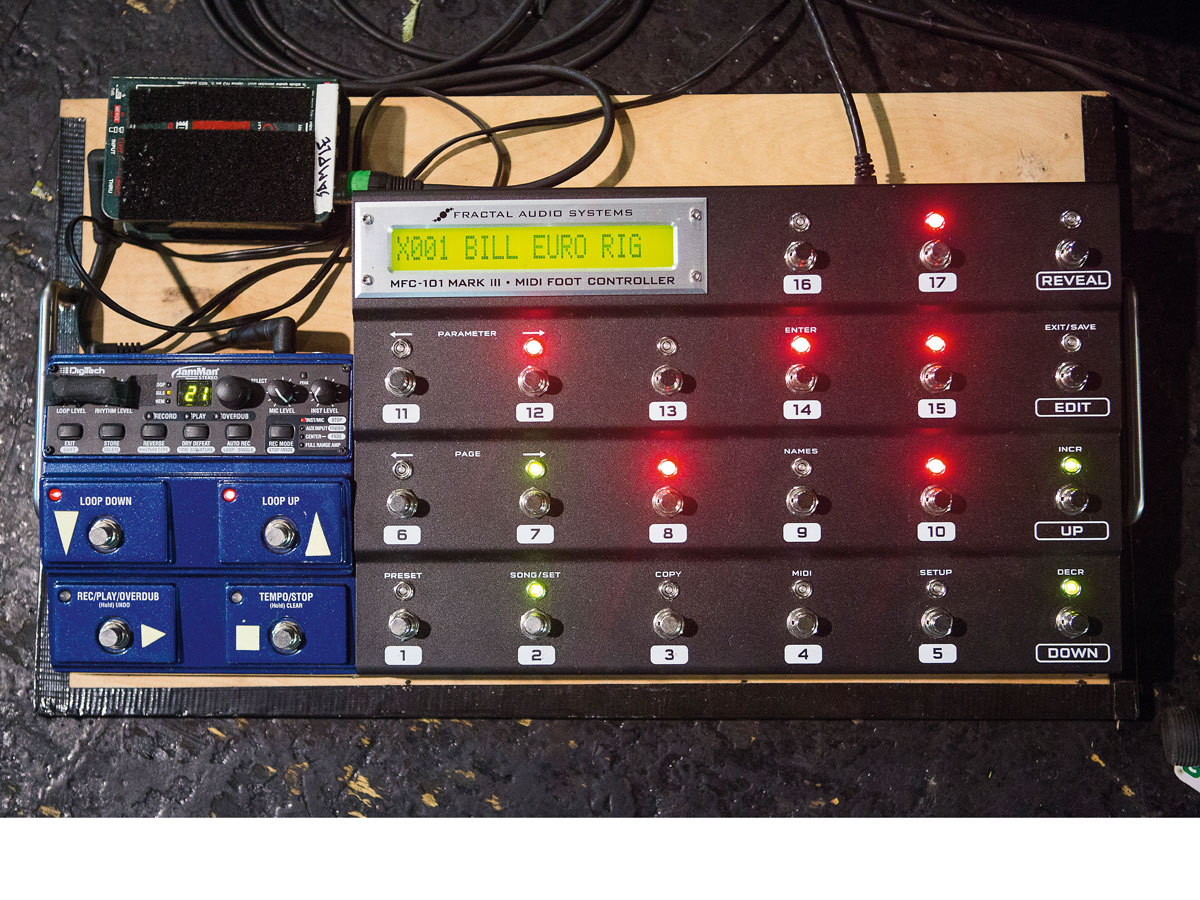
Bill Kelliher, Mastodon
“I’ve tried all sorts of combinations and never been able to do that with other effects processors; sending one signal doing one thing to one and another signal to the other thing doing something else.
"I haven’t been able to figure that out until the Axe-Fx. Because certain amps I have sound great with a distortion box in front of them, and some don’t.
“I’m using it like a pedalboard at the moment and I’m finding it really useful. I don’t use a lot of effects, but it does exactly what I want it to do. It does everything; there’s nothing it can’t do really, it’s great.
"One of the things I like about it is it runs off a cat5 cable right to a pedalboard that’s specific for it. It’s all easy to understand. You can hook up your laptop to it and tweak stuff in real time, like it’s a real pedalboard in front of you. I’m still learning about how to use it, but at the moment it works great.
"I’ve got delay, one clean channel that has a phaser. I’ve got reverb, a little bit of chorus. I’ve got an octaver, a boost... those are the ones I use the most. I just touch them here and there, it’s for peace of mind that they’re in there if I need them, it’s just for effects.
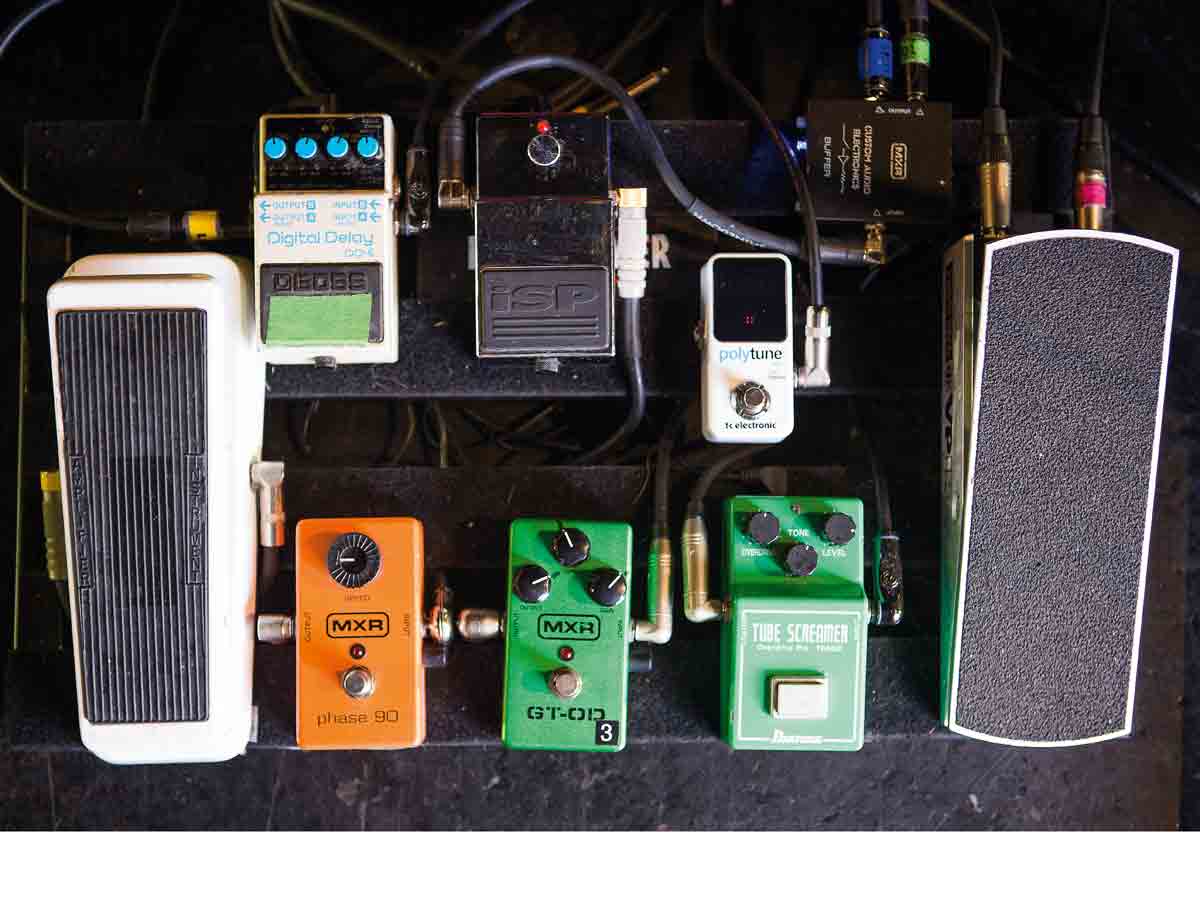
Brent Hinds, Mastodon
“Everything just pretty much stays on all the time. I just have to knock the TS808 off and then the phaser off and on quite often."
Dunlop Cry Baby 105 Bass Wah
“It has a wider envelope and it makes a more dramatic effect. Troy [Sanders, bass] had one laying around the practice pad and I said, ‘This will work.’ And then I tried another wah and thought, ‘This thing’s crap - it doesn’t have that huge envelope on it.’”
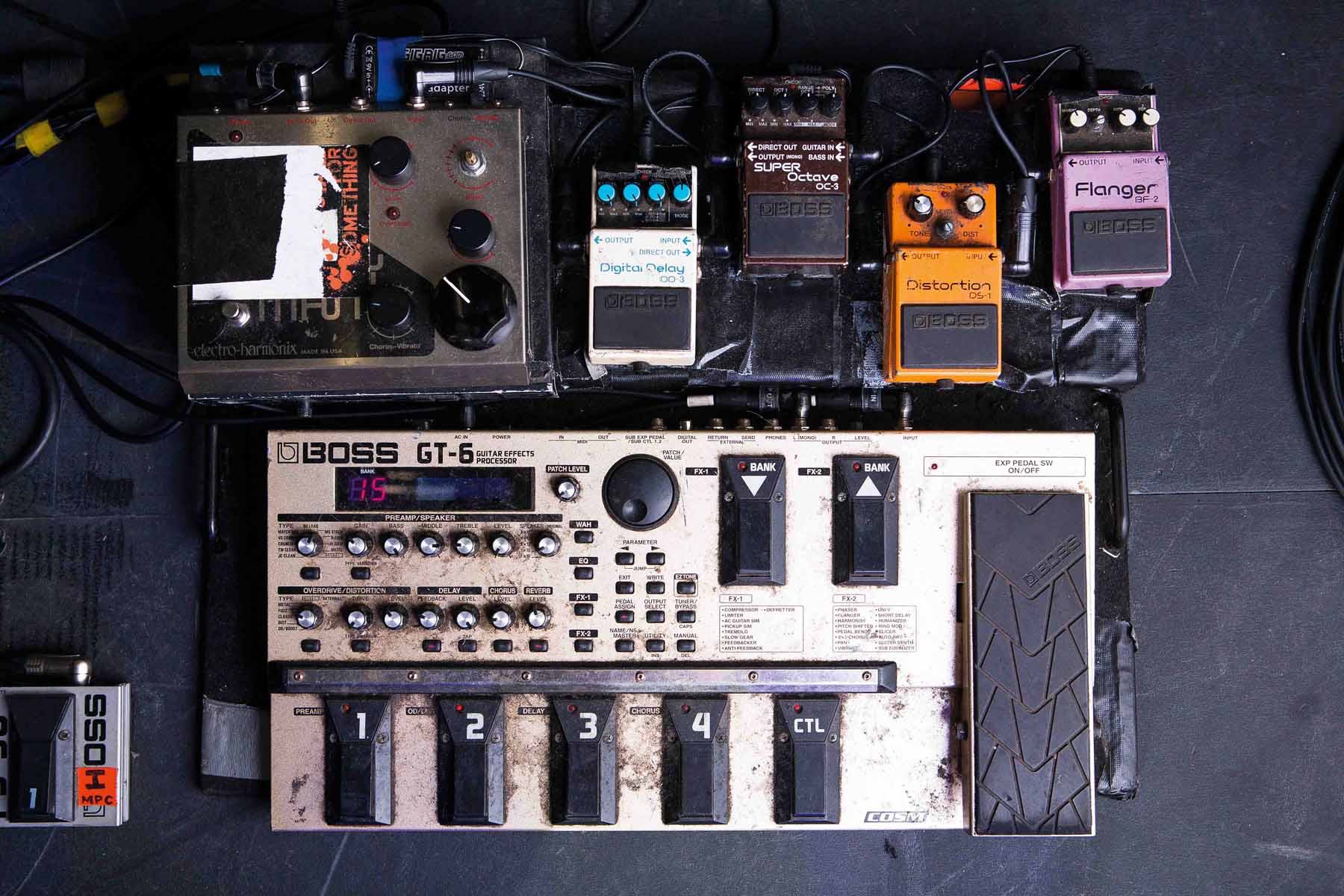
Mark 'Hoss' Hosking, Karnivool
Boss GT-6 Guitar Effects Processor
“This is the workhorse. Not a great signal to noise ratio, but they still have a funky batch of effects that fit into one unit. It’s something we’ve always used in the past for speedy creation of effects. In Australia, we have a lot more room for rack gear, but to get all the effects that we use into one ’board that works well with an expression [pedal] we find this is a great workhorse for that.
“The equivalent of what we use in Australia is four-rack units and a shitload of MIDI control boards at the front. Not quite practical for us to bring overseas, unfortunately.”
Boss DS-1 Distortion
“I use this for one song, Goliath. That first horribly hideous sound is basically a patch in the GT-6 for compression and then the DD-2, DS-1 and the flanger – all of them on full except the flanger. That just runs a slow wash over the sound. A great horrible dirty sound, which is probably all you’ll get out of a DS-1, but it’s effective for that.”
Electro-Harmonix Deluxe Memory Man
“I use it quite a bit for general wash effects. On the GT-6 we have a lot of presets, but this one, obviously being analogue, we have to do things manually, which is why I’ve got giant knobs I can control with my feet on there.
“I use it for a bunch of different stuff, including the effects on Set Fire To The Hive, all the high movement delay effects. It just sounds so good; it’s the breath among the digital evilness sometimes, I think.”
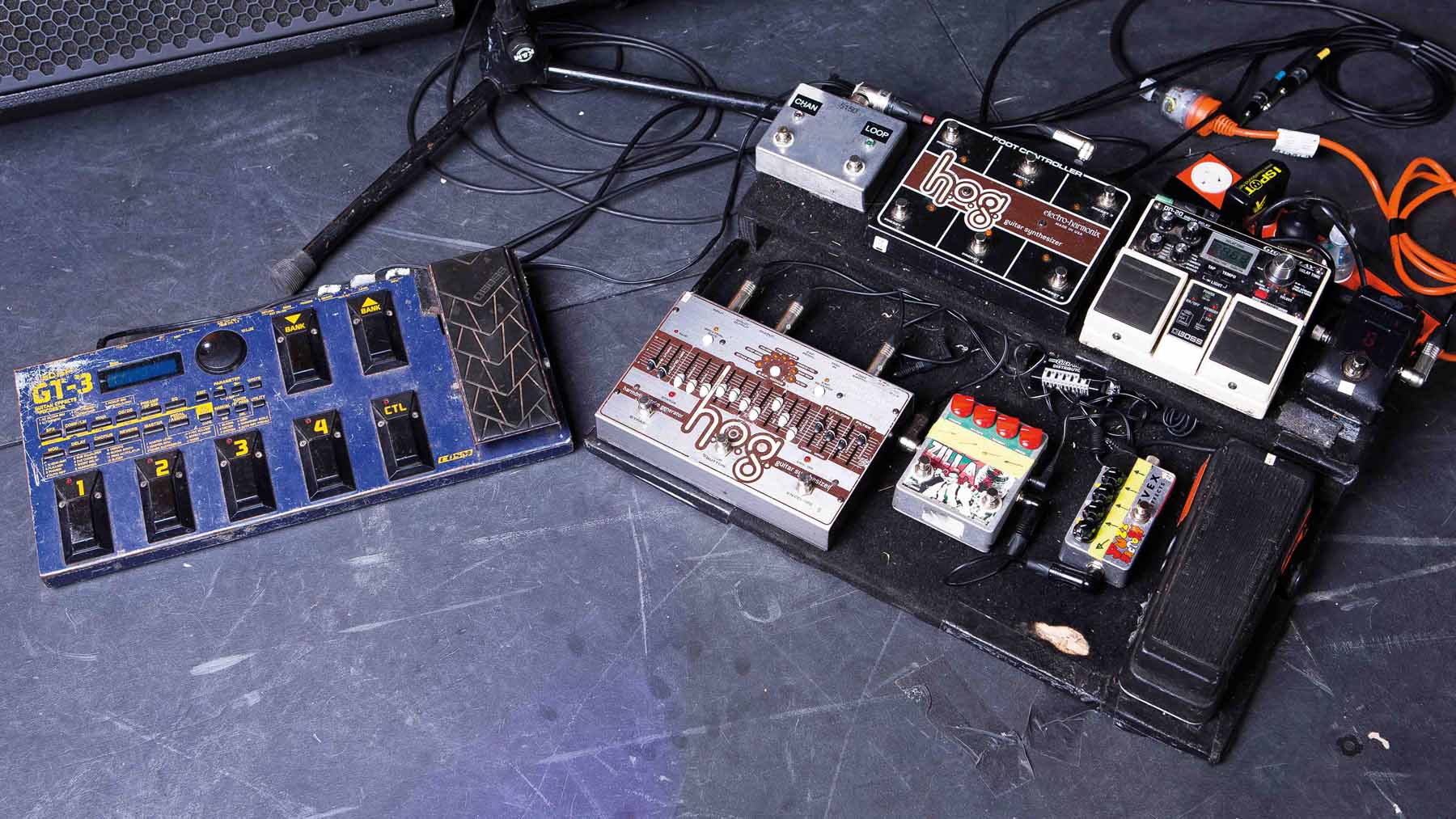
Drew Goddard, Karnivool
Boss GT-3 Guitar Effects Processor
“I run that through the effects loop and use it for some preset delays. While the [pedalboard] is running through the front, kind of a crucial element for me is sometimes I need the delay in the effects loop, which is after the preamp. It’s got a much cleaner sound and then the delay and all the modulation effects especially become a bit more nasty when it’s through the front. It’s more exaggerated, I guess.”
Devi Ever God Zilla
“This one of my favourite fuzz pedals. It’s made by a company, a girl called Devi Ever who just works on her own. She makes amazing pedals, especially these fuzzes. It has the 'I Can Has Cheezburger' cat on it and people running away from it frightened in terror, and that’s kind of what the pedal does.
“You’ve got your Blister, Texture, Tension and Volume, and this is two pedals in one, basically; you can get a blend between the two of them. It’s a very gnarly sound – it sounds as if the speakers are tearing. I used it to record the song We Are, in the middle. It’s also great for simple powerchords: big, doomy, thick, disturbing guitar sounds.”
Electro-Harmonix HOG
“I use the HOG on almost every song. I have two thick octave-below sounds. It’s like the POG, but with more options. You can use it as a harmoniser with some thick octaves below, then tweak with decay and attack envelopes. The filter is very good for picking the frequency of the octave, so you can almost get a parked wah kind of sound with an octave below.
“Then there are the other functions where the really cool stuff happens… You can connect up an expression pedal for an octave bend and volume. Freeze+Gliss are my favourites, which is where you get these big cathedral organ kind of sounds where it sticks.
“You play a chord, wind up the expression pedal – which I don’t have with me on this tour – and it holds the chord. Then you go to a new chord, bring the expression pedal back down and it does a glissando. And because it’s a polyphonic harmoniser, every note fades into the new chord. It’s one of the most interesting functions I’ve ever seen on a pedal.
“There’s the foot controller that comes with it for the presets. There’s a HOG2 now, which I think is much smaller. The real estate [the HOG] takes up on the ’board is kind of annoying, which is the only problem with it.”
Boss DD-20 Giga Delay
“I’ve got a few other delays back home, but the main reason I use this is the modulation setting. It’s got a really distinctive characteristic to it – a bit of a chorus wobble that slowly opens up as it goes and it just creates an atmosphere that’s essential to a lot of Karnivool songs. Only four presets spots, though – that’s the only bad thing about that pedal.”

James Veck-Gilodi, Deaf Havana
Way Huge Supa-Puss Delay
“I pretty much only use it in one song, which is called Fifty Four, but the reason I like it is because it's really transparent; it doesn’t colour the sound at all and that’s exactly what I want, really.”
Electro-Harmonix Stereo Pulsar Tremolo
“I literally use this for 30 seconds in one song to try and make it sound as ridiculous as I can. There’s no reason why I like that whatsoever – it just makes the guitar sound ridiculous!”
Electro-Harmonix Holy Grail Reverb Nano
“I bought it because of the size so it fits on there. I use it when I play lap steel and slide guitar. It’s a pretty natural-sounding reverb. I just use the hall setting. I’m not really big on effects, though – the tone’s in the fingers, innit!”

Matthew Veck-Gilodi, Deaf Havana
Boss DD-7 Digital Delay
“It’s got a non-latching footswitch connected, so I can time [tap tempo delays] myself through a song. Then it doesn’t matter if we play a song at a different tempo, which is nice.”
Electro-Harmonix Small Clone Chorus
“I’ve got this essentially because I want to be in a 90s grunge band and it makes me sound a lot more like that! It’s a really cool pedal and it sounds like the tone Kurt Cobain got on Come As You Are. The depth switch can give you a softer chorus, but when we play a song like Leeches I don’t switch it because it’s a bit more intense, which I like.”
Electric/acoustic input switch
“This is made by one of our techs, Mr Matthew Tag, essentially so I can use one lead for acoustic and electric guitar and just switch between them.”
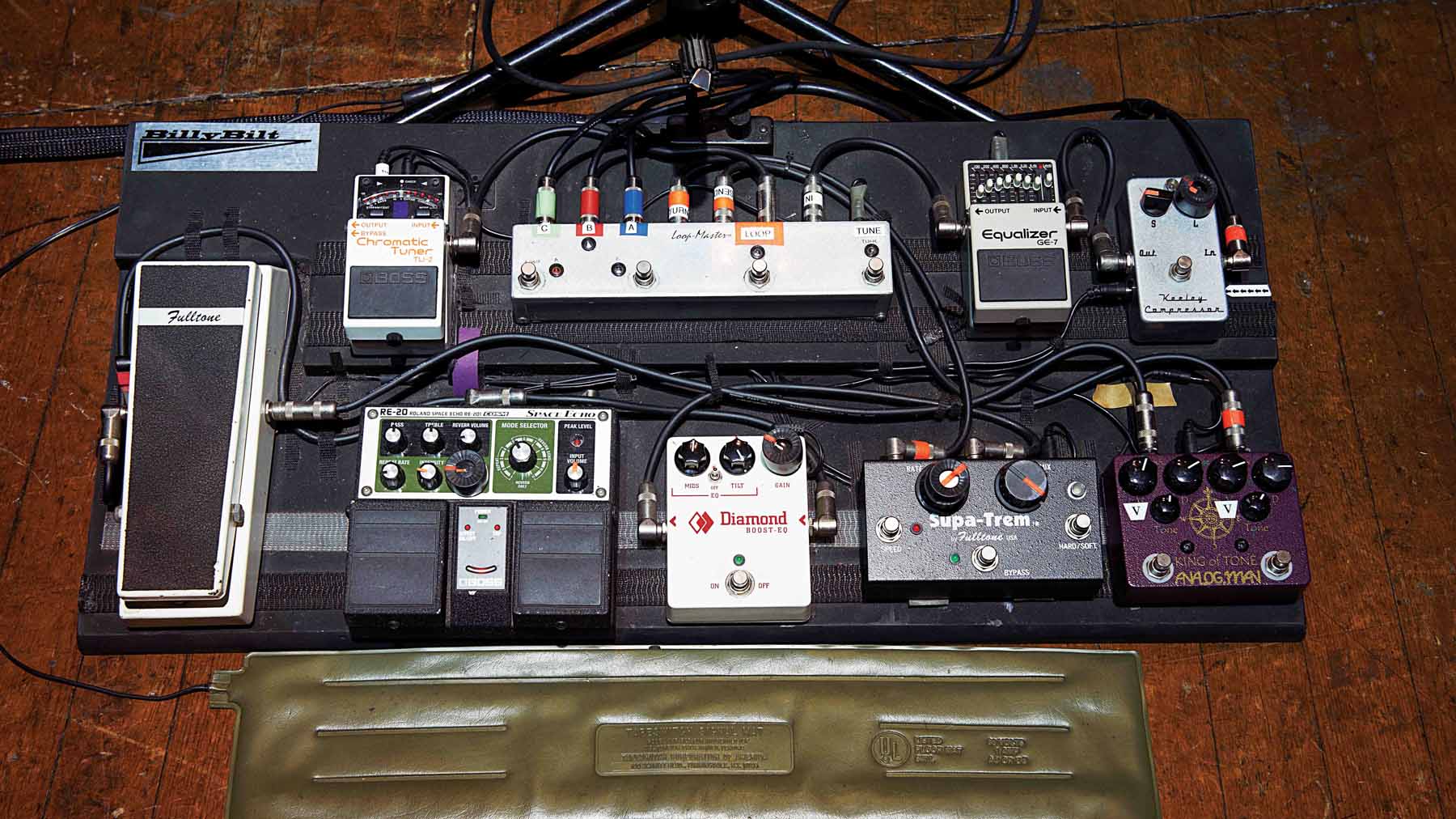
David Bryson, Counting Crows
Fulltone Supa-Trem
“It’s a really outstanding tremolo – it sounds the most like a proper amp tremolo that I’ve ever heard.”
Boss RE-20 Space Echo
“I use a lot of delay, I love delay. It’s my fascination with the Edge where I got that I guess. None of the other guys really use that, so it’s a thing that I can do. It’s just a few songs where I can incorporate a rhythmic, timed delay. I like the modelled tape sound that it has, so it’s a little softer sounding. The ergonomics are really good and the pedals are really easy to tap.”
Analog Man King Of Tone overdrive
“It’s got two sides to it and I don’t know if the sides are different, but they feel different to me. One side goes to 11 and the other side goes to 10 – I can use one side for a crunchier rhythm sound when turning the guitar up doesn’t really get me there. I have two solos in the whole show, and that’s what the 11 is for.”
Loopmaster effects loop controller
“They’re a really cool company because they will make whatever you want. Mine has a little tuner output. And it’s got an A and a B [for two amps] but then you can combine the C, because I have a second Matchless that I’ve used on a couple of songs. You couldn’t buy that, but they’ll make these great pedals for you.”
Fulltone Clyde Wah
“I use it on one song – Round Here. It got recorded that way. I could probably do without it [laughs]. Dave is more the wah-wah guy.”
Tapeswitch Signal Mat
“It switches the vocal mic on. They’re great if you have in-ear monitors because there’s so much bleed from my vocal microphone that there’s just no clarity to the sound whatsoever. When I’m not singing – which is a lot – I don’t stand on the thing, so I hear this perfect stereo. It’s like hearing a record on my in-ears. But the sound gets ruined as soon as I step on that.”
MXR rubber knob covers
“They’re so I can put my foot on the setting and twist it. With the delay, I can change the amount of delay. On some songs, I want a little hint of delay and on others, I want a ton of it so I can crank it up. Same with my compressor – I’ve got one on the gain. For certain songs, I want a more aggressive sound, and I can fiddle with it without bending over.”
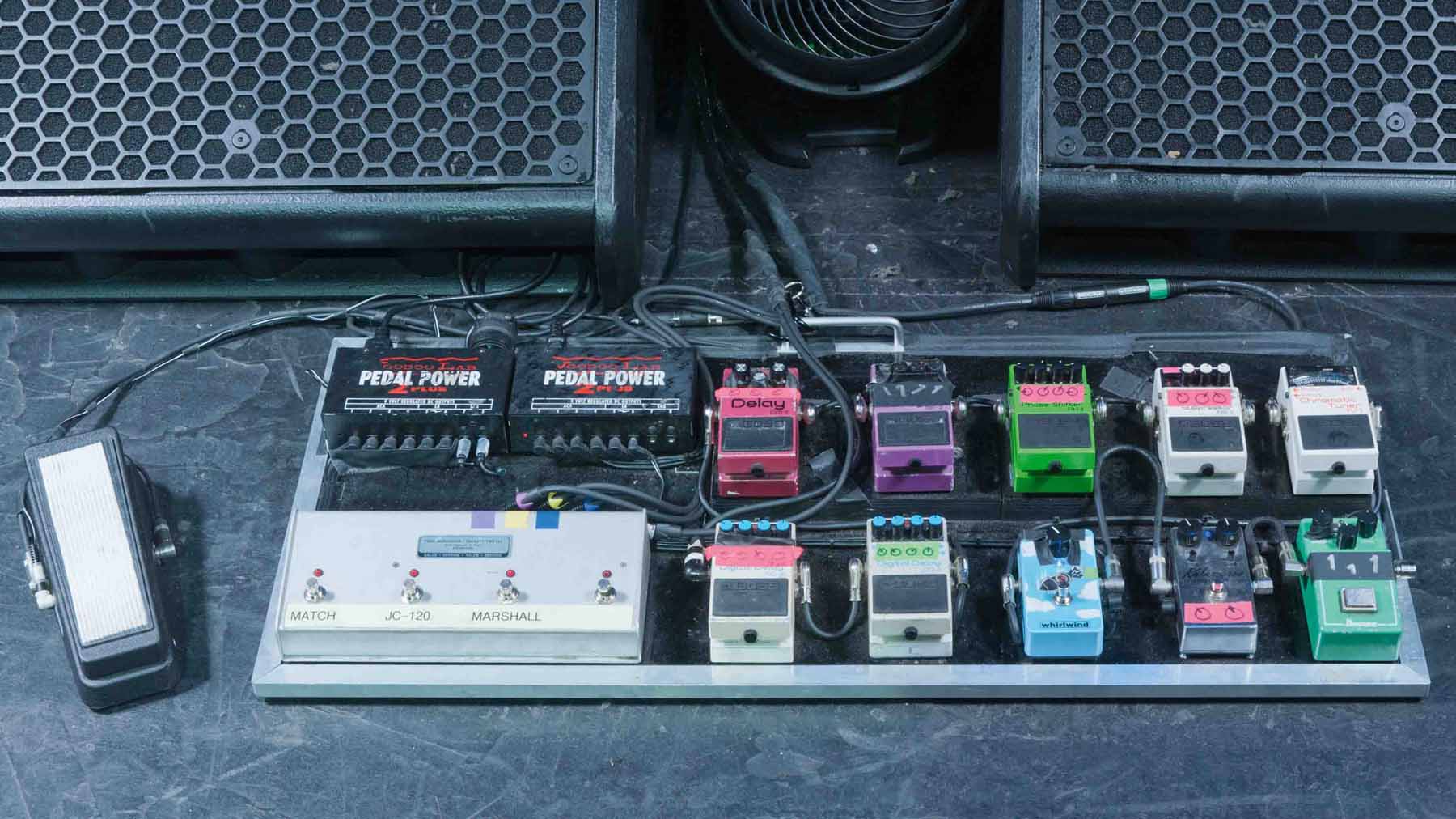
Billy Duffy, The Cult
Jim Dunlop 95Q Cry Baby Wah Wah
“Dunlop make all my picks and my wah-wahs. These days, I like a boost on my wah-wah so that it just automatically boosts the level, because usually they take a bit of your level. And I got into switchless ones recently – there’s no clicker on it, so I just engage and go. There are a few adjustable things on it; they’re not too dissimilar from the Dimebag Cry Baby.”
Boss pedals: DM-2 Delay, BF-2 Flanger, PH-3 Phase Shifter, NS-2 Noise Suppressor, TU-3 Tuner, DD-3 Digital Delay x2
“I’ve always used them. I like them – they always work. Well, I’ve always used them, apart from one period where I got a couple of rack-mounted Korg delays, and I had like a rack-mounted guitar system for a while. I really like it, but it’s a little bit complex, and the way we work now, we do some fly-in gigs, and me being able to control it all from the floor is pretty bombproof.”
Ibanez TS808 Tube Screamer
“It’s a reissue and it’s been modified. Well, it’s less fuzz, a bit more bottom-end and a bit more clarity. A friend of a friend in Los Angeles did it.”
Lovepedal Kalamazoo overdrive
“That’s my new favourite toy; it’s just an overdrive, but it just doesn’t add nasty fuzziness. Basically, it is a Tube Screamer, what you would like a Tube Screamer to do, but with all that warmth, power, sustain, crunch, and it does it all.”
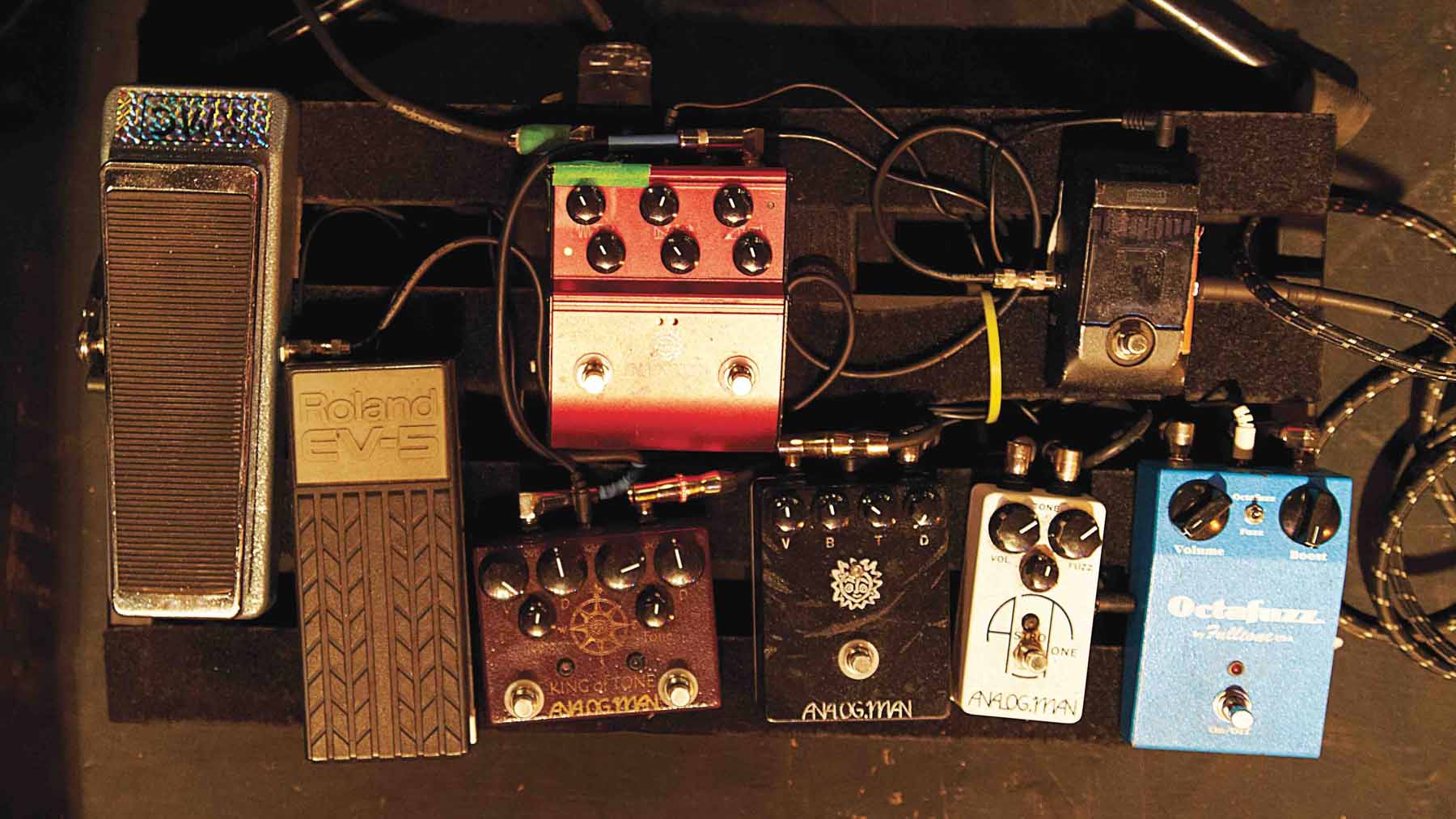
Gary Clark Jr
“Different pedals make me play different, and I can express myself in different ways, but sometimes there is nothing like going straight through with a clean, pure tone, with just the guitar and amp. Pedals can be fun, though.”
Fulltone Octafuzz
“I’m still finding out new things about this pedalboard. It’s all new to me from the past couple of years. This Octafuzz is a cool thing – it just puts a boost on things, really. I use it on Ain’t Messin ’Round to give it a boost in the chorus.”
RMC Real McCoy Wah
“This is pretty cool, and I stomp on that from time to time. It’s just different.”
Analog Man Astro Tone Fuzz
“As far as When My Train Pulls In goes, I use the Analog Man Astro Tone during the choruses to give it a boost, I use the Octafuzz during the leads, and then I’ll also use the [RMC Real McCoy] Wah, as well.”
Analog Man King Of Tone & Analog Man ARDX20 Dual Analog Delay
“The Analog Man King Of Tone is basically a boost overdrive, and it has two channels. The [ARDX20 Dual Analog] Delay’s random, and I like to adjust the amount of the timing of the delay like with slapback. I’ll throw a little bit of that on Ain’t Messin’ ’Round and Please Come Home, and sometimes even Bright Lights if I feel adventurous and I’m looking to do something different.
“For the big tone on Numb, I’ll drop down to open D and use the Analog Man King Of Tone, the Astro Tone and the Octafuzz together… Basically, I stomp on anything with a red light!”
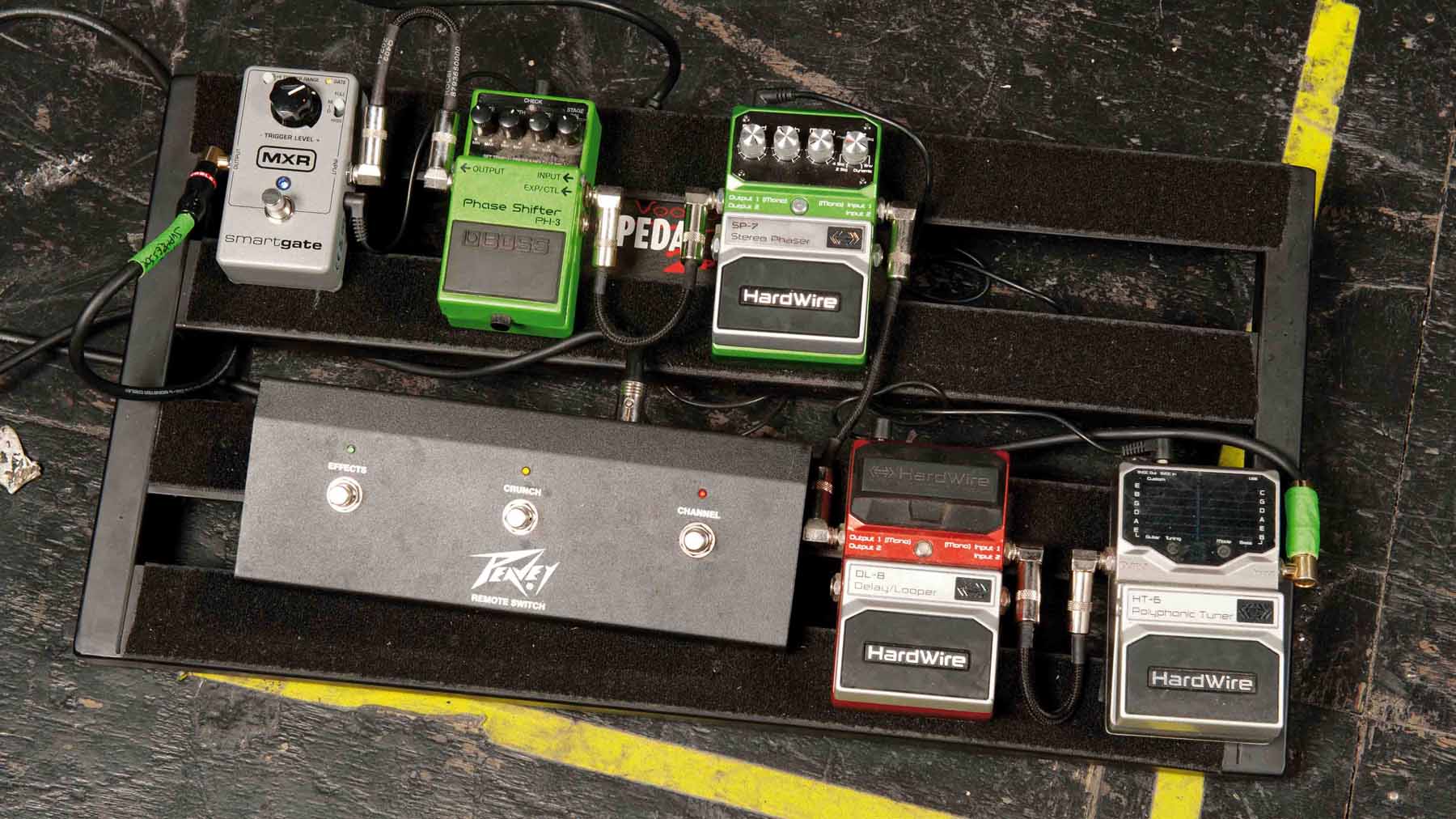
Phil Manansala, Of Mice & Men
Boss PH-3 Phase Shifter & HardWire SP-7 Stereo Phaser
“I use the PH-3 on Still YDG’N and also Product Of A Murderer. Then I have a stereo phaser, a DigiTech HardWire SP-7, which I like to run [simultaneously] with my other phaser, so they make crazy noises.
“I think the phaser fell off for a bit and, being a fan of nu-metal, where the phaser is used a lot, I feel like it needs to make a comeback. That’s why I’ve got two of them!”
HardWire DL-8 Delay/Looper
“I run a HardWire delay pedal, a DL-8, on all of my leads, just to spice it up a little bit. I have it on a tremolo setting, so it’s kind of fast, but it dies out in like four beats. Then it has a kill switch, so it doesn’t go over everything and make me sound stupid!”
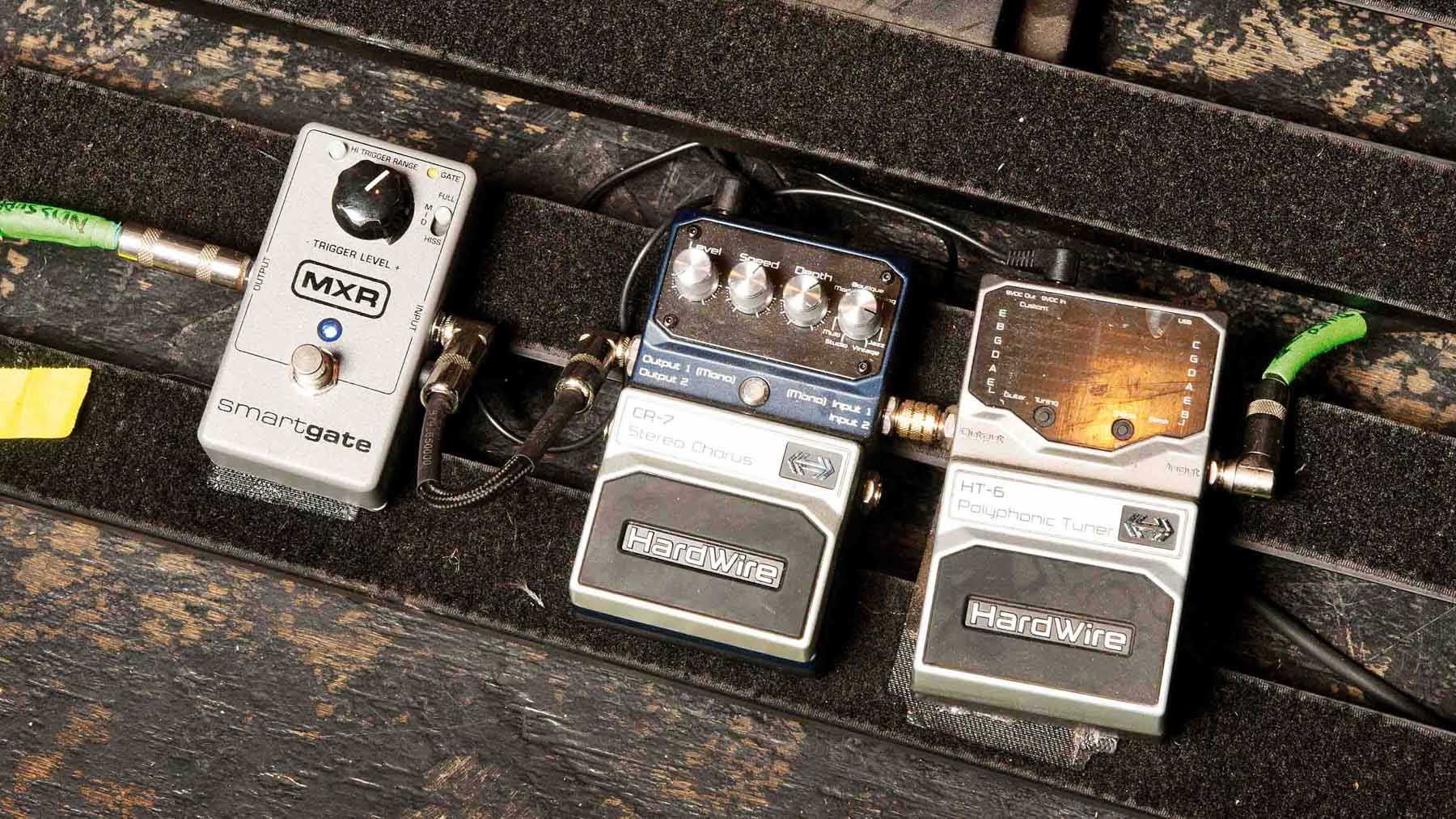
Alan Ashby, Of Mice & Men
HardWire CR-7 Stereo Chorus
“I use my chorus pedal for a lead that I play on The Flood and The Depths. I have the depth turned way up so that it sounds like a Korn lead sound.”
MXR Smart Gate
“A must. When I first joined the band I didn’t have one, but when you’re playing a different venue every night, sometimes you’re getting feedback – especially with how much gain we use. So we just turn up the noise suppressor and it cuts all the extra noise out.”

Total Guitar is Europe's best-selling guitar magazine.
Every month we feature interviews with the biggest names and hottest new acts in guitar land, plus Guest Lessons from the stars.
Finally, our Rocked & Rated section is the place to go for reviews, round-ups and help setting up your guitars and gear.
Subscribe: http://bit.ly/totalguitar

